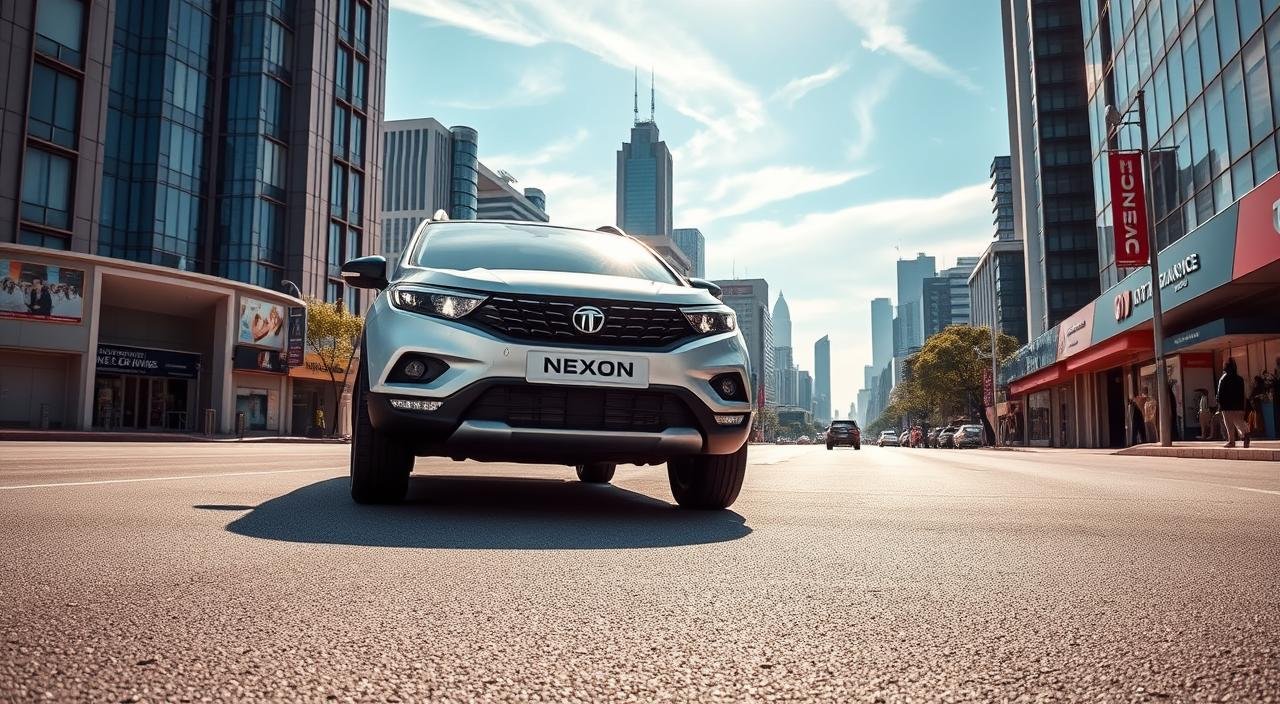
Oct
Every 90 seconds, a new family in India drives home a Tata Nexon. This makes it the top SUV for two years running. Over 500,000 units have been sold, proving it’s India’s #1 Car.
The Tata Nexon changed the Indian car scene when it launched six years ago. It quickly became the best-selling car, beating Maruti Suzuki Brezza and Hyundai Venue. It shows people want safe, stylish, and feature-rich cars.
In June 2023, the Nexon’s sales showed it’s a leader in both traditional and electric cars. It helps Tata Motors in two big ways. It boosts their ICE market and leads in electric mobility in Indian cities.
Key Takeaways
- Tata Nexon maintains its position as India’s best-selling SUV for two straight years
- Over 500,000 families across India now own a Nexon, a milestone from its 2017 debut
- The model dominates the sub-4 meter SUV segment, beating Maruti Brezza and Hyundai Venue
- Nexon plays a key role in both ICE and electric vehicle markets for Tata Motors
- June 2023 sales figures confirm continued market leadership in compact SUV category
Introduction to the Tata Nexon
The Tata Nexon has quickly become a leader in India’s compact SUV market. It combines modern tech, practical design, and great value. This makes it a hit with today’s car buyers.
It stands out by having premium features usually found in pricier cars.
Overview of the Tata Nexon’s Popularity
Sales figures show the Tata Nexon’s big success. It’s often among India’s top-selling cars every month. It attracts many buyers, from young professionals to families.
Its affordable price and safety tech make it a favorite in cities and towns.
Key Features That Drive Sales
The interior is a highlight, with a 7-inch touchscreen infotainment system at its heart. It has customizable themes and colors. The IRA connected car tech lets you control your car from your phone.
Voice commands work in English and Hindi, making it easy for more drivers.
Premium features include:
- 8-speaker Harman sound system for concert-quality audio
- Spacious 350-liter boot capacity for luggage needs
- 15-liter cooled glovebox keeping drinks cold
- Rear AC vents with 12V charging socket
- Door pockets with built-in umbrella holders
These features make the Tata Nexon a comfortable ride for all. The rear seats have plenty of legroom and headspace, perfect for long trips.
What is ADAS?
Modern cars are getting smarter every day. Advanced Driver Assistance Systems (ADAS) are a big step forward in car safety. They act like a co-pilot, helping drivers stay safe and confident on the road.
As Indian roads get busier, ADAS technology is key in preventing accidents. It helps save lives.
Definition of Advanced Driver-Assistance Systems
ADAS uses cameras, sensors, and radar to watch what’s around your car. It checks for dangers in real-time and warns the driver. A car with ADAS can spot other cars, people, and road signs on its own.
Some important ADAS features are:
- Autonomous Emergency Braking (AEB)
- Forward collision alert
- Lane departure warning
- Traffic sign recognition
- 360-degree camera systems
- Lane change assist
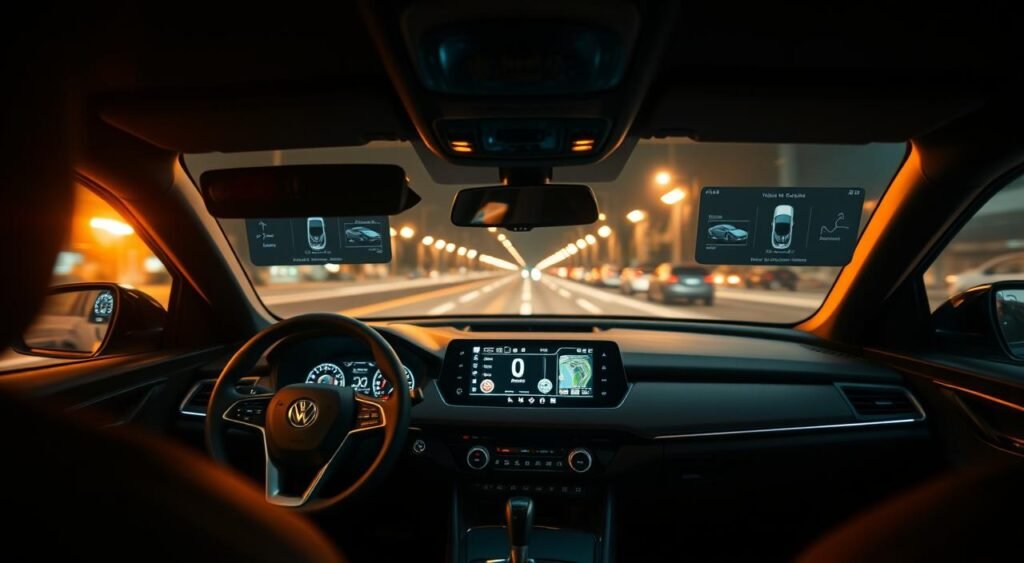
Benefits of ADAS for Drivers
ADAS makes long drives and city traffic less stressful. It gives drivers extra eyes on the road. Studies show cars with ADAS have fewer accidents.
Driver fatigue is less of a risk with ADAS. It watches blind spots and keeps a safe distance automatically.
The Role of ADAS in the Tata Nexon
Tata Motors has added ADAS to cars like the Harrier and Safari. But the Nexon focuses on traditional safety features. This makes the Nexon more affordable without sacrificing safety.
The Red Dark Edition: A Stylish Upgrade
The Red Dark Edition is a top-of-the-line version of the Tata Nexon. It combines sleek design with unique features. This edition turns the standard SUV into a standout vehicle with its color choices and interior touches.
Design Elements of the Red Dark Edition
The outside has an Oberon Black paint job, making it look bold on Indian roads. Inside, Carnelian Red accents pop against the dark background. The dashboard gets a glossy white finish with tri-arrow designs.
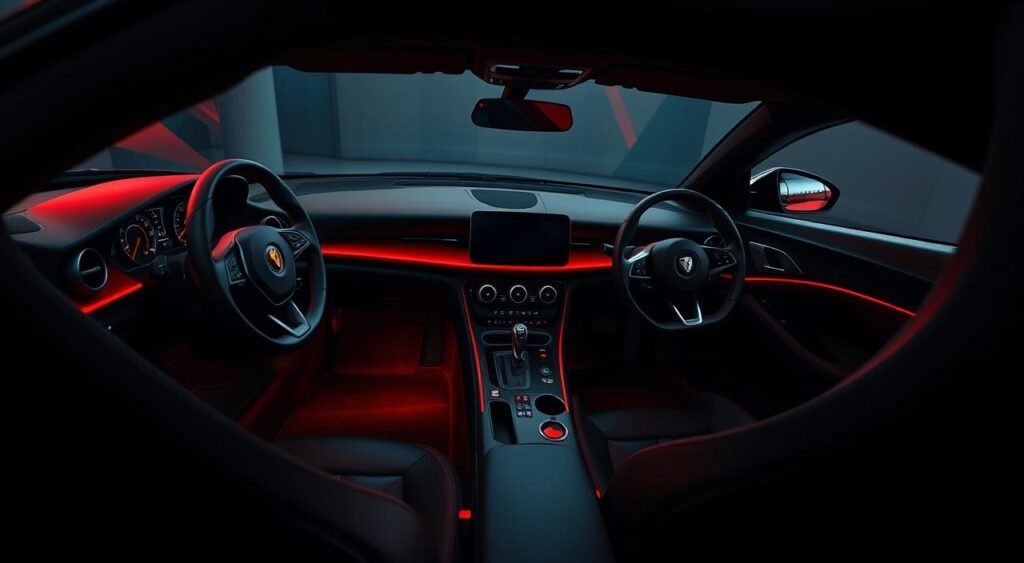
The steering wheel is wrapped in premium leather, adding a sporty feel. Ambient lighting around the sunroof makes night drives feel luxurious. It makes every trip feel special.
Unique Features That Stand Out
Several features make the Red Dark Edition stand out:
- 4-way powered passenger seats with Boss mode functionality
- Exclusive tri-arrow design elements throughout the cabin
- Premium leather-wrapped steering wheel with flat-bottom design
- Ambient lighting system integrated with the sunroof
- Carnelian Red interior accents on seats and door panels
Target Audience for the New Edition
The Red Dark Edition is for young professionals and urban families. They want style and practicality in their vehicles. This edition meets their needs with its unique look and Tata Nexon’s safety and reliability.
Safety Features of the Tata Nexon
The Tata Nexon is a top choice in India, thanks to its focus on safety. This compact SUV leads in vehicle safety technology, winning global safety awards. It gives families peace of mind with its full safety package.
Enhanced Protection for Passengers
The Nexon offers many safety features for everyone inside. Key ones include:
- Dual front airbags as standard equipment
- Anti-lock Braking System (ABS) with Electronic Brakeforce Distribution (EBD)
- Corner Stability Control for improved handling
- Rear parking sensors with reverse camera display
- ISOFIX child seat anchors
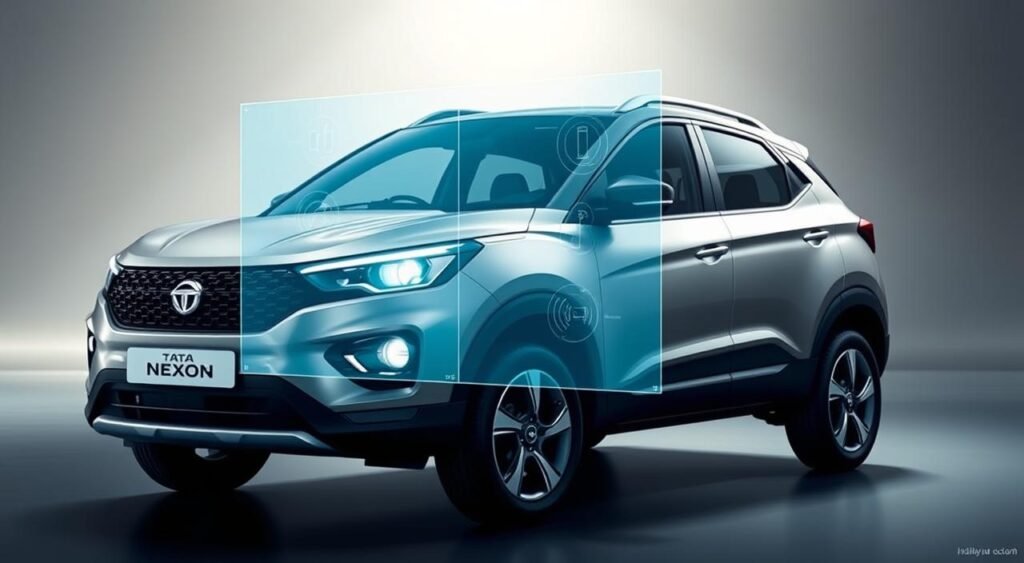
The Nexon’s high-strength steel structure acts as a protective shell. It absorbs crash impact, keeping passengers safe. Its strong B-pillars and side beams add extra safety in side crashes.
Crash Test Ratings and Safety Standards
The Tata Nexon got a 5-star rating from Global NCAP, showing it’s very safe. It scored high in adult and child safety tests. These scores prove the Nexon’s advanced safety tech works well in real accidents.
Performance Analysis
Tata Motors has made the Nexon a standout performer on various roads. It has a strong engine and smart fuel use, perfect for Indian roads. Whether in the city or on highways, the Nexon offers a great drive for all.
Engine Specifications and Power Output
The Nexon comes with several engine options. The 1.2-liter turbocharged petrol engine makes 120 PS. Diesel engines go up to 1497cc, with torque from 170 Nm to 260 Nm. This gives the car enough power for quick overtakes and climbing hills.
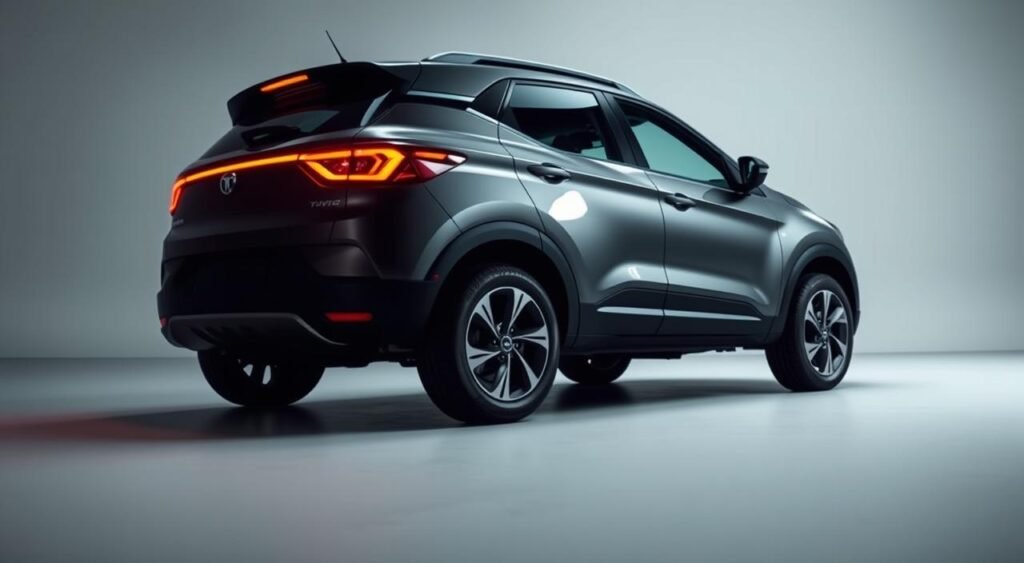
Fuel Efficiency of the Tata Nexon
Fuel efficiency is a big plus for the Nexon. It can go up to 24.07 kmpl, saving money on fuel. With three drive modes – City, Sport, and Eco – you can adjust for different driving conditions.
| Engine Type | Power Output | Torque | Mileage |
|---|---|---|---|
| 1.2L Petrol Turbo | 120 PS | 170 Nm | 17.4 kmpl |
| 1.5L Diesel | 115 PS | 260 Nm | 24.07 kmpl |
Driving Experience Across Varied Conditions
Driving on highways is smooth, reaching 100 kmph at 2000 rpm. The 6-speed manual transmission makes city driving easy. Though there’s some turbo lag at low speeds, the engine and suspension are top-notch for long trips.
Competitive Landscape
The Indian SUV market is getting more competitive. Many car makers are trying to be the best. The Tata Nexon has become the top car in India by beating its rivals. It does this by focusing on what customers want and being smart about its features.
How Tata Nexon Stands Against Rivals
The Nexon competes with other popular cars in its price range. Each rival has its own strengths. But the Nexon stays ahead because of its safety and roomy interior.
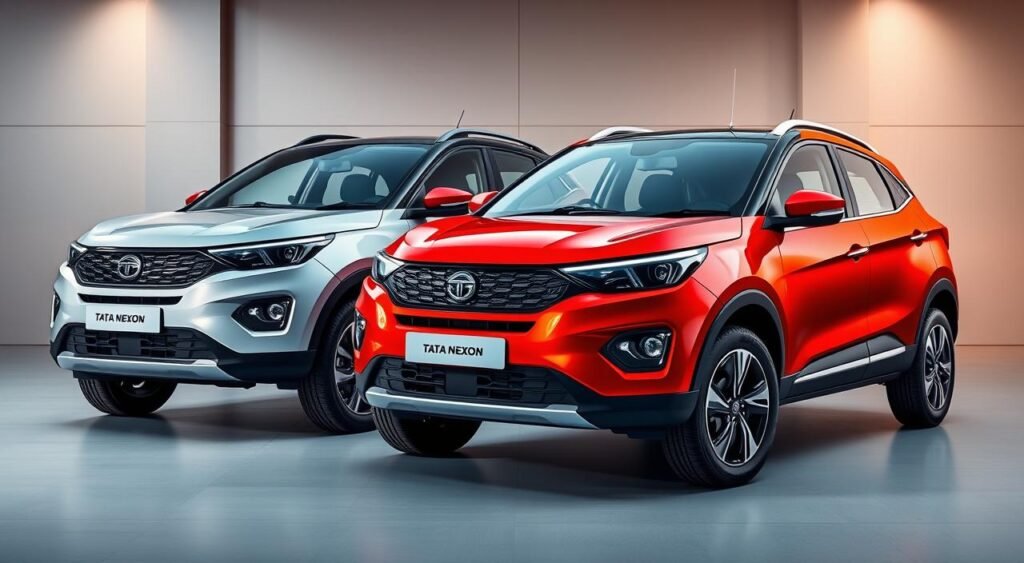
| Model | Price Range (Rs. Lakh) | Key Strength |
|---|---|---|
| Tata Nexon | 7.99-14.49 | 5-star safety rating |
| Maruti Brezza | 8.26-13.01 | Service network |
| Hyundai Venue | 7.26-12.46 | Connected features |
| Maruti Fronx | 6.85-11.98 | Fuel efficiency |
| Hyundai Exter | 5.68-9.61 | Entry-level pricing |
Market Trends Influencing Car Purchases
Recent data shows SUVs with safety features are in demand. Buyers look for high crash test ratings and ADAS. The Nexon’s strong sales in May and June 2023 show it’s a favorite over Maruti Brezza and Hyundai Venue.
Customer Preferences in India
Indian families want cars that are affordable and have modern features. Safety is the top priority, followed by fuel efficiency and space. The Nexon meets these needs, making it a top choice for many.
Pricing and Variants
Tata Motors has set the Nexon’s price to reach various parts of the Indian market. The prices show the brand’s dedication to value and advanced features. This includes the car with ADAS technology in higher trims.
Pricing Strategy for Different Editions
The Nexon begins at Rs. 8.00 lakh for the Smart variant and goes up to Rs. 15.50 lakh for the Fearless Plus Dark Edition. Each model is designed for different buyers, with special features. The Creative and Fearless variants, priced between Rs. 10.00-13.50 lakh, offer a balance of features and cost.
Comparison with Competitors’ Pricing
Tata Motors has set the Nexon’s price to stay competitive:
| Model | Starting Price | Top Variant Price | ADAS Availability |
|---|---|---|---|
| Tata Nexon | Rs. 8.00 lakh | Rs. 15.50 lakh | Yes (Fearless variants) |
| Hyundai Venue | Rs. 7.94 lakh | Rs. 13.48 lakh | Limited features |
| Kia Sonet | Rs. 7.99 lakh | Rs. 15.69 lakh | Yes (HTX+ onwards) |
| Maruti Brezza | Rs. 8.34 lakh | Rs. 14.14 lakh | No |
Financing Options for Buyers
Tata Motors offers flexible financing through major banks and NBFCs. Interest rates start from 8.5% per annum with loans up to 7 years. There are special deals like zero down payment and exchange bonuses up to Rs. 40,000 for Tata owners.
Customer Feedback and Reviews
The Tata Nexon has caught the eye of many in India. Over 1,000 reviews give it 4.4 out of 5 stars. It’s a hit in the compact SUV market, thanks to its Advanced Driver Assistance Systems and solid performance.
Positive Reactions from Consumers
Many Nexon owners love its value and safety. They say it’s a great deal, with lots of safety features at a good price. The car’s roomy interior is a big plus, with comfy seats for three adults on long trips.
Drivers are happy with the car’s engine, which is powerful yet fuel-efficient. The suspension makes rides smooth, whether on the road or highway. People also like the car’s modern look and tech inside.
Critiques and Areas for Improvement
Even with its high ratings, there are things some customers wish were better:
- City fuel economy could be better for some
- Engine needs work at idle
- Gear shifts can feel rough, mainly at high speeds
- There’s not enough space for everyday items
- The infotainment system could have more features
- The AMT transmission seems old compared to others
Conclusion
The Tata Nexon becoming India’s #1 car is a big win. It shows a mix of smart design, top safety, and good prices that Indian families love. Its steady sales for two years show it’s a favorite among buyers.
Implications of Tata Nexon’s Market Leadership
The Nexon’s top spot shows people want cars that are safe. It has a 5-star Global NCAP safety rating, leading the sub-4 meter SUV segment. The Red Dark Edition keeps things exciting and new.
Being the leader means Tata Nexon has to set new standards. With JLR and EV plans, there’s a lot to look forward to. This includes better safety features and connectivity.
The Red Dark Edition shows Tata Motors’ commitment to new ideas. They offer unique styles and keep their cars appealing to many. This keeps the Nexon in the game as the market gets more competitive.
Future Outlook for Tata Nexon
The Tata Nexon is at a key point as safety tech in the Indian market keeps improving. It has sold over 500,000 units and leads in monthly sales. The SUV’s success in both gas and electric versions shows Tata Motors can meet changing needs.
This makes the Nexon ready for new tech in future models. ADAS features are the next step for the Nexon. Current models don’t have these, but future ones will to keep up with Hyundai Venue and Kia Sonet.
Features like radar cruise control, lane-keeping assist, and automatic emergency braking will be added. These will meet the growing need for safety tech in India. They will also keep the Nexon’s five-star Global NCAP safety rating.
The Nexon’s future looks bright. Tata Motors can use its strong market position to add better connectivity, cabin comfort, and powertrain options. The Nexon EV shows Tata’s focus on electric vehicles, balancing performance and green tech.
As Indian buyers get more tech-savvy, the Nexon needs to update its infotainment and digital features. It must keep its safety and practicality at the same time.
FAQ
What makes the Tata Nexon India’s top-selling car?
The Tata Nexon is India’s best-selling SUV for two years. It has a 5-star Global NCAP safety rating. It also has a 7-inch touchscreen and IRA connected car technology.
Its price is between Rs.5.50-9.30 Lakh. It has a big boot and is great value for money. Over 5 lakh families have bought it.
Does the Tata Nexon come with ADAS features?
The Tata Nexon does not have Advanced Driver Assistance Systems (ADAS) yet. Tata Motors has added these features to the Harrier and Safari.
Features like Autonomous Emergency Braking and 360-degree camera systems are not in the Nexon. But, future models might have these.
What are the unique features of the Red Dark Edition?
The Red Dark Edition has a special look. It has Oberon Black outside and Carnelian Red inside. It also has 4-way-powered seats and ambient lighting.
It has a gloss white dashboard and a sporty steering wheel. This makes it stand out from other Nexons.
How safe is the Tata Nexon compared to competitors?
The Tata Nexon has a 5-star Global NCAP safety rating. It is one of the safest SUVs in its class. It has ABS, rear parking sensors, and airbags.
It is safer than the Maruti Brezza and Hyundai Venue in crash tests. Its safety is top-notch.
What engine options and fuel efficiency does the Nexon offer?
The Nexon has engines from 1199cc to 1497cc. They make 113.42 to 118.35 bhp and 170 Nm to 260 Nm of torque. The updated 1.2-liter engine makes 120PS and gets 24.07 kmpl.
It has three drive modes for different conditions. It cruises comfortably at 100kmph at just 2000rpm.
How does the Nexon’s pricing compare to rivals like Maruti Brezza and Hyundai Venue?
The Nexon costs between Rs.5.50-9.30 Lakh. This is competitive with the Maruti Brezza and Hyundai Venue. The Nexon’s top models are priced higher than some Hyundai Venue models.
This is because of its better features and safety. The Nexon offers great value for money.
What do customers say about the Tata Nexon’s performance?
Customers give the Nexon 4.4/5 based on over 1,000 reviews. They love its value, comfortable ride, and spacious seats. It looks impressive on the road.
Some say it’s not great in the city, and the engine can be rough. The infotainment system feels a bit old compared to others.
What technology features does the Nexon offer?
The Nexon has a 7-inch touchscreen with IRA connected car tech. It also has voice command in English and Hindi. The sound system is top-notch.
It has a big glovebox, umbrella holders, and rear AC vents. There’s even a 12V socket for passengers.
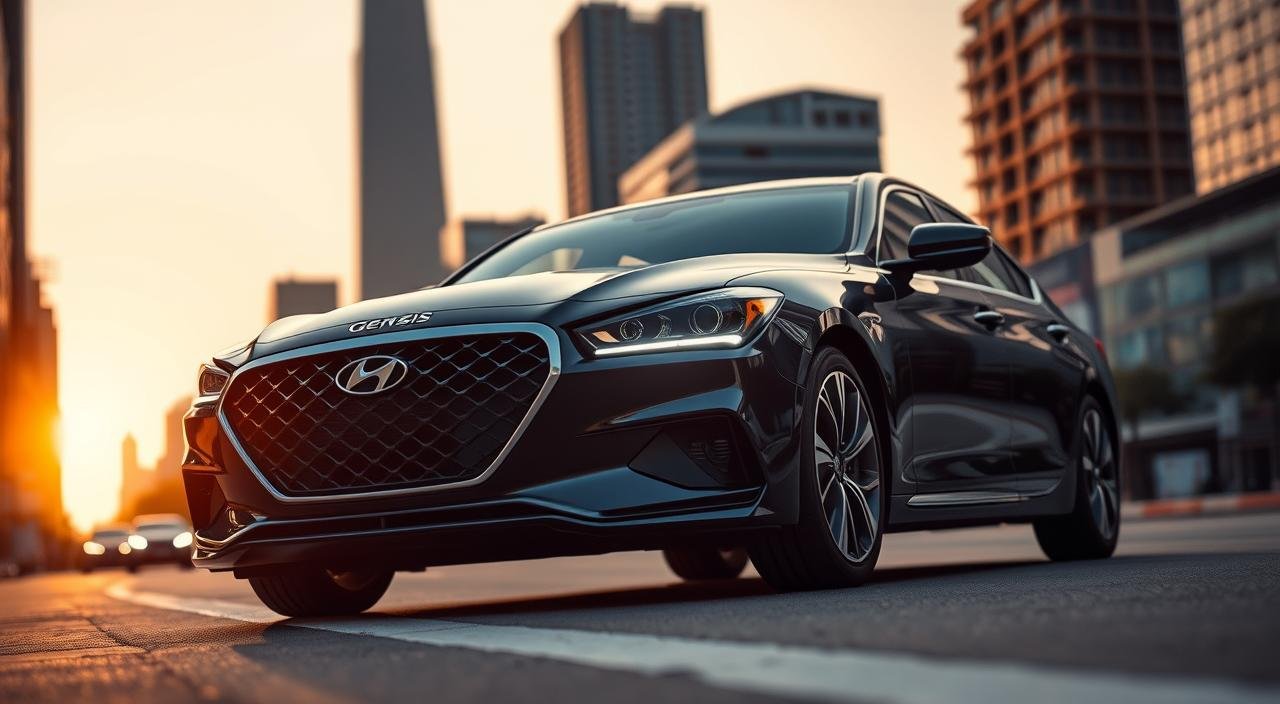
Oct
India’s luxury car market is set to boom, growing by 150% to 100,000 units by 2027. This is the perfect time for new premium brands to enter. Hyundai Motor Group has announced plans to launch Genesis in India by 2027. This marks a big step for Hyundai’s premium ambitions.
The Genesis India debut comes after years of careful planning. Hyundai’s luxury brand team studied Indian consumer habits. They want to make sure Genesis enters the market successfully.
Genesis’ move into India is part of a bigger global growth plan. The brand aims to increase Hyundai’s profits and reduce its reliance on the North American market. India’s growing rich population and desire for luxury cars make it a great place for premium brands.
Genesis will challenge big names like Mercedes-Benz, BMW, and Audi in India. It promises unique Korean design, advanced tech, and top-notch service. By setting up local assembly, Genesis shows it’s serious about making a splash in India with affordable prices.
Key Takeaways
- Genesis will officially enter the Indian luxury car market in 2027
- Local assembly operations planned for competitive pricing from launch
- India’s luxury car segment expected to reach 100,000 units annually by 2027
- Launch strategy focuses on reducing Hyundai’s dependence on US market
- Genesis aims to compete directly with German luxury brands
- Years of market research and evaluation preceded the announcement
Introduction to Genesis: A Luxury Evolution
Genesis is Hyundai’s top luxury brand, marking the Korean company’s big step into high-end cars. It has quickly become a major player in the luxury car world. In just eight years, Genesis reached one million global sales, showing it’s a hit with luxury car buyers everywhere.
Overview of Hyundai’s Luxury Division
Genesis started as its own brand in 2015, breaking away from Hyundai. It quickly made a name for itself, earning high profits in just two years. This success shows Genesis can hold its own against top luxury brands from Europe and Japan.
Significance of the Indian Market
The luxury car market in India is growing fast, at 3.3% in FY2025. Hyundai sees India as key for growth and exports. With only 1% of the car market being luxury, there’s a lot of room for Hyundai to grow in India.
Genesis’ Global Presence and Reputation
Genesis has a strong presence in North America, Europe, and Asia. Its cars have won awards for design and innovation. Genesis is known for exceptional craftsmanship and the latest technology, making it a real choice for luxury car buyers.
Genesis Models Expected in India
The Genesis brand is set to enter India with a range of luxury vehicles. They have nine models globally, including sedans, SUVs, and electric cars. These models are chosen to meet Indian tastes and needs.
Sedans: G70 and G80
The G70 and G80 sedans show Genesis’ focus on luxury and performance. The G70 is a sports sedan, while the G80 offers top-class comfort. They feature unique designs and compete with BMW and Mercedes-Benz.
SUVs: GV70 and GV80
SUVs will be a big part of Genesis news in India. The GV80 is expected to be the first model, with both standard and coupe-SUV versions. It will have three engine options:
- 2.5-liter turbo-petrol producing 304 horsepower
- 3.5-liter turbo-petrol generating 380 horsepower
- 3.5-liter mild-hybrid turbo-petrol delivering 415 horsepower
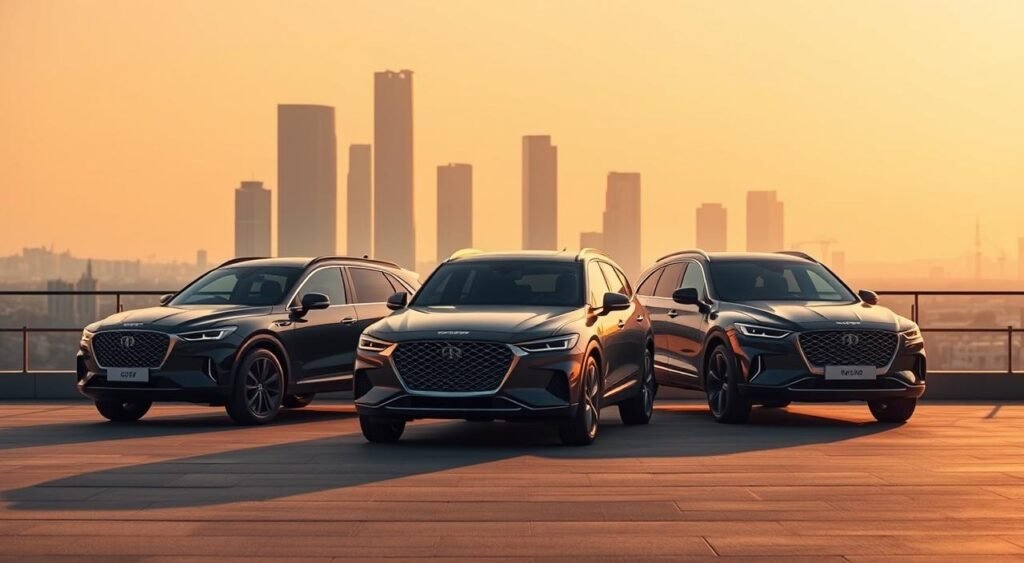
All GV80 variants will have standard all-wheel drive. The GV70 is a sportier, smaller option. SUVs are key for Genesis, making up over 70 percent of Hyundai’s sales in India.
Future Electric Vehicles
Genesis plans to bring electric models like the GV60 SUV and Electrified G80. These cars will fit India’s growing electric market. Genesis has trademarked the GV80 design in India, showing their serious commitment.
Competitive Landscape in India
The Genesis brand is entering India’s luxury car market at a great time. The demand for luxury cars has never been higher. Last year, over 51,000 premium vehicles were sold in India.
This growth is both exciting and challenging for Genesis. It’s a chance to make a mark in a market that’s always changing.
Key Competitors in the Luxury Segment
Genesis will face tough competition from German giants like Mercedes-Benz, BMW, and Audi. These brands have been leaders in India’s luxury car market for years. They have strong dealer networks and are well-known.
The Genesis GV80 and GV70 will go head-to-head with the Mercedes-Benz GLE, BMW X5, and Audi Q7. This is in the midsize luxury SUV category.
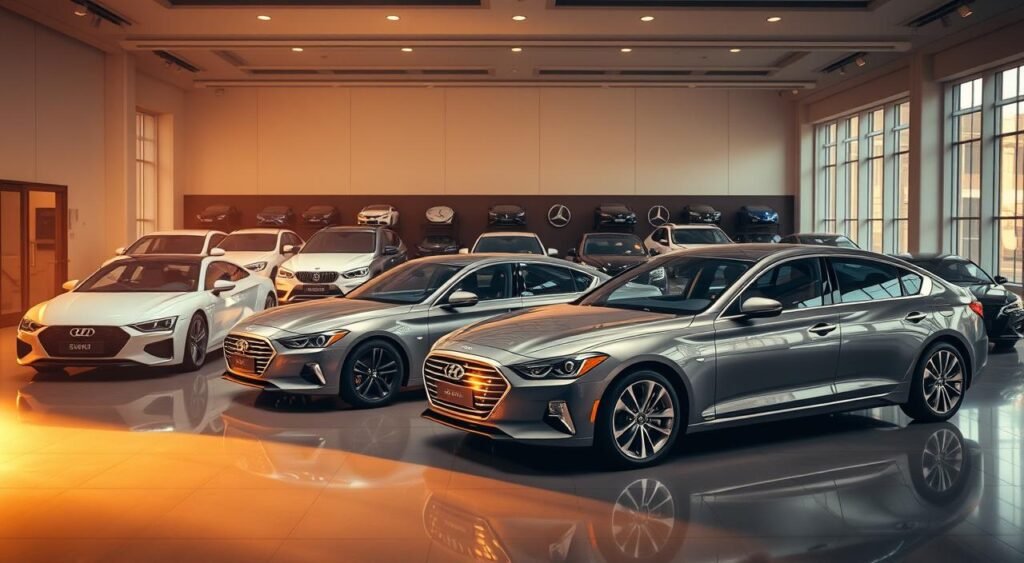
Market Positioning Strategies
Genesis aims to offer top-notch features at good prices. It plans to stand out with great warranties, personalized service, and the latest tech. Genesis wants to bring a fresh take on luxury, unlike what European brands offer.
Shifts in Consumer Preferences
Indian luxury car buyers are now looking for sustainability and the latest tech. Electric cars are becoming more popular, even among the wealthy. They want cars that are good for the planet but don’t sacrifice performance.
Genesis is ready to meet these needs with electric vehicles and advanced tech. It’s all about giving buyers a modern luxury experience.
Pricing Strategy and Market Position
The Genesis brand is set to launch in India by 2027. It will make strategic pricing decisions to change the luxury car market. Hyundai plans to make cars locally to avoid high import costs.
This move will make Genesis a strong competitor against German brands from the start.
Expected Pricing for Genesis Models
Genesis cars in India will start at ₹45-50 lakhs for the G70 sedan. They will compete with BMW 3 Series and Mercedes-Benz C-Class. The G80 sedan might cost ₹65-75 lakhs.
SUVs like the GV70 and GV80 could be priced at ₹55-85 lakhs. Making cars locally at Hyundai’s Chennai plant will save buyers 15-20%.
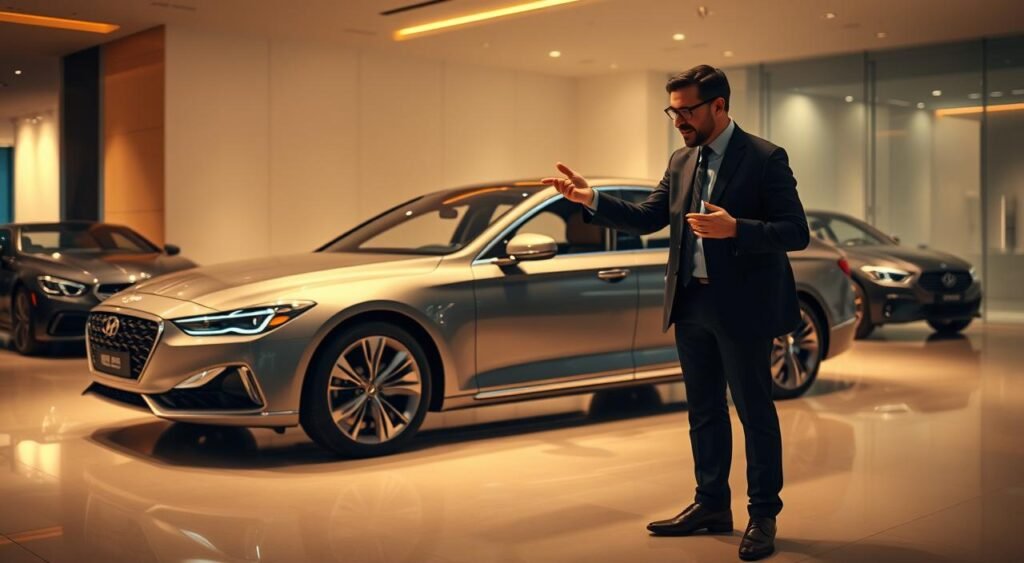
Value Proposition of Genesis Vehicles
Genesis offers great features at good prices. Their cars come with a five-year warranty and free maintenance. They also have concierge services, usually found in top luxury brands.
They include advanced tech like Highway Driving Assist II and Remote Smart Parking Assist as standard. This is not something you have to pay extra for.
Comparison with Rivals
Genesis aims to attract luxury buyers who want value. Unlike Audi, BMW, and Mercedes-Benz, Genesis focuses on modern luxury. They use sustainable materials and cutting-edge tech.
Genesis also offers a unique ownership experience. This appeals to young professionals who value innovation over tradition.
Dealership Network Expansion Plans
Genesis aims to set up a top-notch dealership network across India by 2027. They will use Hyundai’s current setup but make their showrooms unique. This way, Genesis can confidently enter the Indian market.
Launching Genesis Showrooms in Major Cities
Genesis will start by opening showrooms in big cities like Mumbai, Delhi, Bangalore, and Chennai. These showrooms will have special designs that show off Genesis’s luxury.
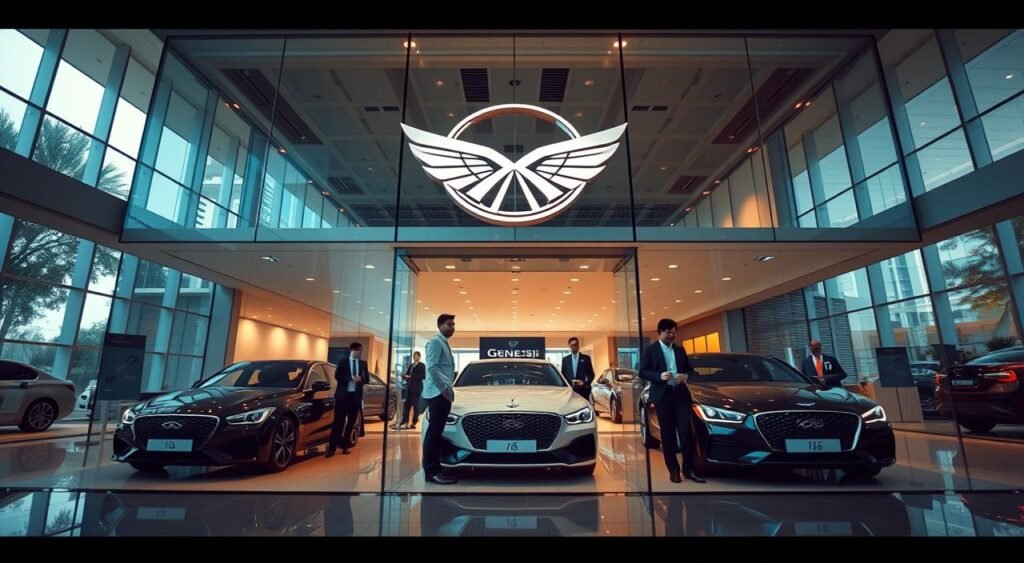
By 2028, Genesis plans to have 15 showrooms in top cities. These places will let customers see Genesis cars and learn about their features.
Training and Development for Staff
Genesis knows that well-trained staff is key to success in India’s luxury car market. They will offer training in product knowledge, customer service, and technical skills. Before the launch, staff will get certified through Genesis Academy.
Customer Experience Focus
The Genesis India debut focuses on giving customers a personalized experience. They will offer valet services, home test drives, and personal relationship managers. Genesis also has special benefits like free maintenance for three years and 24/7 roadside help. These services make Genesis cars more than just cars—they offer a luxury lifestyle in India.
Marketing Strategies for Indian Consumers
Genesis aims to grab the attention of India’s wealthy crowd with smart marketing. It wants to be known for innovation and caring for the planet. Genesis sees itself as a top choice for those who want luxury, unlike European brands.
Target Demographics and Buyer Personas
Genesis looks at successful people aged 35-55 in big cities as its main customers. They want cars that show off their success and are good for the environment. The brand also aims at tech-loving business leaders and young people who want electric cars.
Promotional Campaigns and Events
Genesis will host special preview events in Mumbai, Delhi, and Bangalore. People can try out Genesis cars at luxury resorts. The brand will also team up with luxury brands and auto shows to get noticed.
Genesis plans to sponsor golf tournaments and cultural events. This will help it connect with its target audience.
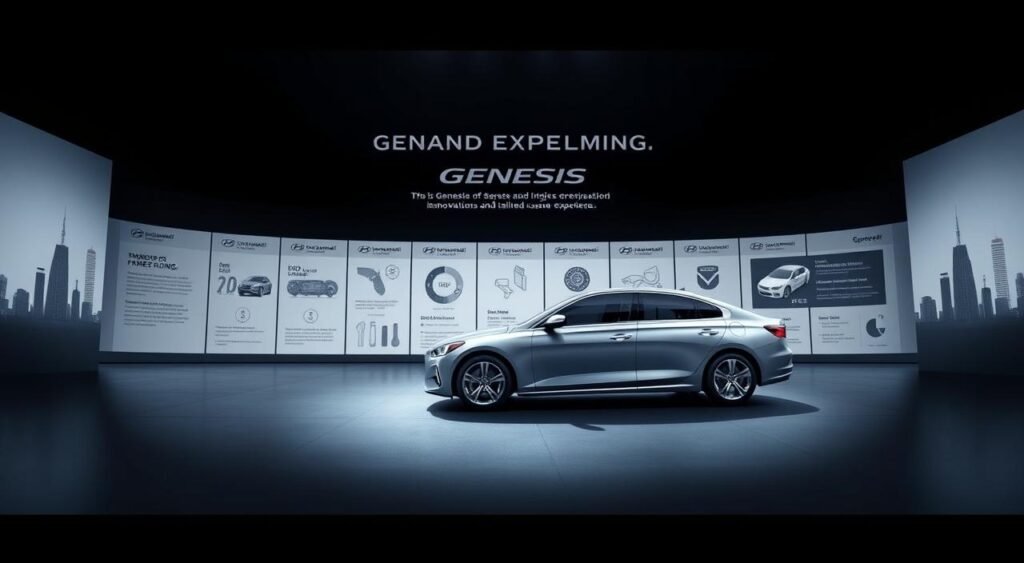
Digital Marketing Approach
Genesis will use social media and work with influencers to reach young luxury buyers. It will offer virtual showrooms and apps to show off car features. The website will let people customize cars and book online.
Genesis will also share content on blogs and YouTube. This will show off the tech in its cars.
Technological Innovations in Genesis Vehicles
Genesis is all about the latest tech, making it a leader in luxury. The new Hyundai luxury car launch in India will feature cars with cool features. These include safety, connectivity, and eco-friendly tech. Genesis is ready to take on the big names in luxury.
Advanced Safety Features
Genesis cars have top-notch safety features. They have Highway Driving Assist II for safe driving on highways. Smart Parking Assist finds parking spots and parks the car for you.
- Forward Collision-Avoidance Assist with pedestrian detection
- Blind-Spot Collision-Avoidance Assist
- Remote Smart Parking Assist via smartphone
- 360-degree surround view monitor
Enhanced Infotainment Systems
The new Hyundai luxury cars have amazing infotainment. They have a big 14.5-inch screen for controlling everything. You can connect wirelessly with Apple CarPlay and Android Auto. The navigation system uses augmented reality to show you the way.
Sustainability Efforts in Production
Genesis is going green with four electric models by 2030. They use recycled materials and make cars in a way that’s good for the planet. Solar panels and water recycling help reduce harm to the environment.
Customer Service and Support
Genesis aims to lead in premium customer service in the Genesis automotive industry India market. They know that top-notch after-sales support is key to winning over luxury car buyers. They’re building on Hyundai’s strong service network across the country. Genesis wants to offer a service experience that’s as premium as their cars.
Warranty and Maintenance Packages
Genesis cars in India will have full warranty coverage for peace of mind. The brand offers:
- 5-year unlimited mileage warranty on all models
- Complimentary scheduled maintenance for the first three years
- 24/7 roadside assistance coverage
- Extended warranty options up to 10 years
Genesis Concierge Service
The Genesis Concierge program offers personalized luxury service in India. It includes vehicle pick-up and drop-off for maintenance, so you don’t have to visit the showroom. Personal concierge managers will handle all service appointments, giving each customer the attention they deserve.
After-Sales Support Channels
As Genesis to Launch in India by 2027 gets closer, the brand is setting up various support channels. Customers can get services at Genesis service centers, through mobile apps, and on exclusive customer helplines. Genesis will also use digital tools for remote diagnostics and virtual consultations, making service more convenient for busy owners.
Contributions to the Indian Automotive Market
The Genesis India debut is a big step for the country’s car industry. This move by Hyundai luxury brand brings many benefits. It’s part of a big plan to make 26 new models by 2030, making India a major player in car making and exporting.
Employment Opportunities Through Genesis
Genesis coming to India will create thousands of jobs. They will need skilled workers for making cars, sales, and more. This will also help other industries that support car making.
Economic Impact of Launching a Luxury Brand
Hyundai’s investment in India makes it a big name in cars worldwide. Making luxury cars here will bring in foreign money and new tech. The Genesis launch will also help India sell cars abroad, boosting its economy.
| Economic Benefit | Impact Area | Projected Growth |
|---|---|---|
| Direct Employment | Manufacturing & Sales | 5,000+ jobs |
| Indirect Employment | Suppliers & Services | 15,000+ jobs |
| Annual Revenue | Domestic Sales | ₹2,500 crores |
| Export Potentia | International Markets | ₹1,500 crores |
Genesis’ Role in Promoting Electric Vehicles
Genesis aims to bring six electric cars to India. This move will help more people buy electric cars, leading to better roads and more green cars. It shows India is serious about making and selling electric luxury cars.
Conclusion: Anticipating the Impact of Genesis in India
Genesis luxury vehicles will change India’s premium car market in 2027. They will challenge Mercedes-Benz, BMW, and Audi. With local assembly, prices might be lower than for cars fully imported.
India will become a major production center for Genesis in Asia. This makes India more than just a market.
Final Thoughts on Genesis 2027 Launch
The 2027 launch is Genesis’s smart move to meet India’s luxury car demand. Tarun Garg, Hyundai’s top boss, believes Genesis will appeal to Indian buyers. Genesis will start with assembly and then increase production as demand grows.
This strategy lets Genesis test the market and build local skills. It’s a smart way to start.
Long-Term Vision for Hyundai’s Luxury Division
Hyundai luxury cars in India will include electric vehicles soon. Local production means cars can be made with features and designs for Indian tastes. Genesis aims to change what luxury means in India and globally.
By focusing on electric vehicles, Genesis will lead in luxury EVs in India. This supports India’s goal for green transport.
FAQ
When will Genesis launch in India?
Genesis will launch in India by 2027. This was confirmed at Hyundai’s Investors Day. The brand will use Hyundai’s network for its debut.
Which Genesis models will be available in India first?
The GV80 SUV and GV80 coupe-SUV will be the first Genesis models in India. The GV80 SUV has 304hp and 380hp engines. The coupe-SUV has a 415hp engine. All models have all-wheel drive.
Will Genesis vehicles be locally manufactured in India?
Yes, Hyundai plans to assemble Genesis models in India from the start. This move aims to lower costs and offer competitive prices. It also allows for better customization for Indian roads.
How will Genesis compete with established luxury brands like Mercedes-Benz, BMW, and Audi?
Genesis will compete in the midsize luxury SUV segment. It will offer futuristic tech, strong performance, and competitive prices. It will also have robust after-sales support through Hyundai’s network.
What is the current state of India’s luxury car market?
The luxury car market in India is growing fast, at 3.3% in FY2025. It reached a record 51,000 units in fiscal year 2025. This growth is faster than the overall industry.
Will Genesis offer electric vehicles in India?
Yes, Genesis plans to introduce electric vehicles in India. It has four battery electric models globally, including the GV60 SUV. This meets growing demand for eco-friendly vehicles in India.
How successful has Genesis been globally?
Genesis has been very successful globally, reaching one million sales in eight years. It has also achieved double-digit profit margins in just two years. This success sets it up for growth in emerging markets like India.
What role will Genesis play in Hyundai’s broader India strategy?
Genesis is a key part of Hyundai’s plan to launch 26 new offerings in India by FY2030. This includes 20 ICE vehicles and six EVs. Hyundai sees India as a key market for growth and exports.
How will Genesis establish its dealer and service network in India?
Genesis will use Hyundai’s network while setting up its own ecosystem. It aims to provide premium after-sales support. Genesis will have its own showrooms and trained staff for a luxury experience.
What makes the Genesis India debut significant for the automotive industry?
Genesis’s expansion is Hyundai’s strategy to boost margins and reduce US market dependence. Local manufacturing shows faith in India’s production capability. Genesis aims to offer luxury from India, possibly as an export hub.

Oct
Only 250 units of the Land Rover Defender Trophy Edition exist globally. It’s rarer than a Ferrari Roma in India. This exclusive SUV has just arrived on Indian shores at ₹1.30 crore. It brings a piece of automotive history that conquered the world’s most challenging terrains.
The Land Rover Defender 110 Trophy Edition marks a special chapter in the brand’s 2026 model year lineup. JLR India has introduced this limited-edition vehicle as a tribute to the iconic Camel Trophy expeditions. These expeditions tested man and machine across uncharted territories during the 1980s and 1990s.
This rugged luxury SUV combines modern engineering with nostalgic design cues from Land Rover’s golden era of adventure. The Land Rover Defender 110 Trophy Edition Launched at ₹1.30 Crore represents more than just another premium vehicle in the Indian market. It celebrates the spirit of exploration that made the original Defender a legend in off-road competitions worldwide.
The timing of this launch positions the Land Rover Defender 110 Trophy Edition as an exclusive offer for Indian enthusiasts. They value both heritage and capability. Each unit carries unique badges and styling elements that connect directly to the brand’s adventurous past. It delivers contemporary luxury and technology.
Key Takeaways
- Limited to 250 units worldwide with exclusive availability in India
- Priced at ₹1.30 crore ex-showroom as part of the 2026 model year range
- Pays tribute to the legendary Camel Trophy expeditions of the 1980s and 1990s
- Features unique design elements that celebrate Land Rover’s off-road heritage
- Combines rugged capability with modern luxury amenities
- Represents JLR India’s commitment to bringing exclusive models to the Indian market
Overview of the Land Rover Defender 110 Trophy Edition
The Trophy Edition Land Rover Defender 110 is a special version. It mixes tough off-road skills with stylish looks. It’s only available in the 5-door version, based on the D300 platform.
This model is perfect for those who love adventure and luxury. They want a vehicle that’s both comfortable and ready for rough terrain.
Key Features of the Trophy Edition
The Land Rover Defender 110 Trophy Edition comes with the latest tech. It has a big 13.1-inch touchscreen for controlling everything from navigation to media. It also has three-zone climate control for keeping everyone comfortable on long trips.
Here’s what you get:
- Automatic headlamps and rain-sensing wipers
- Configurable ambient interior lighting
- 360-degree camera system for parking assistance
- Multiple Terrain Response driving modes
- 20-inch gloss black alloy wheels
Distinctive Design Elements
The Trophy Edition Defender 110 has two unique paint colors: Deep Sandglow Yellow and Keswick Green. The roof, bonnet, and wheel arches are in black, making it stand out. It also has special decals on the bonnet and C-pillar.
The front and rear scuff plates are black. The side body cladding adds extra protection for off-road adventures.
Pricing and Variants of the Defender 110
The ₹1.30 Crore Land Rover Defender 110 is priced just right for the Indian luxury SUV market. It’s between the standard Defender models and the top V8 variant. This special edition is for those who want heritage and modern features.
Comparison with Other Variants
The Land Rover Trophy Edition stands out in the Defender lineup. Its price reflects its unique features and limited availability. It’s different from regular models.
| Defender Variant | Price (Ex-showroom) | Key Differentiator |
|---|---|---|
| Defender 90 | ₹97 Lakh | Entry-level three-door model |
| Defender 110 S | ₹1.05 Crore | Standard five-door configuration |
| Defender 110 Trophy Edition | ₹1.30 Crore | Heritage-inspired special edition |
| Defender 110 V8 | ₹1.95 Crore | Performance-focused flagship |
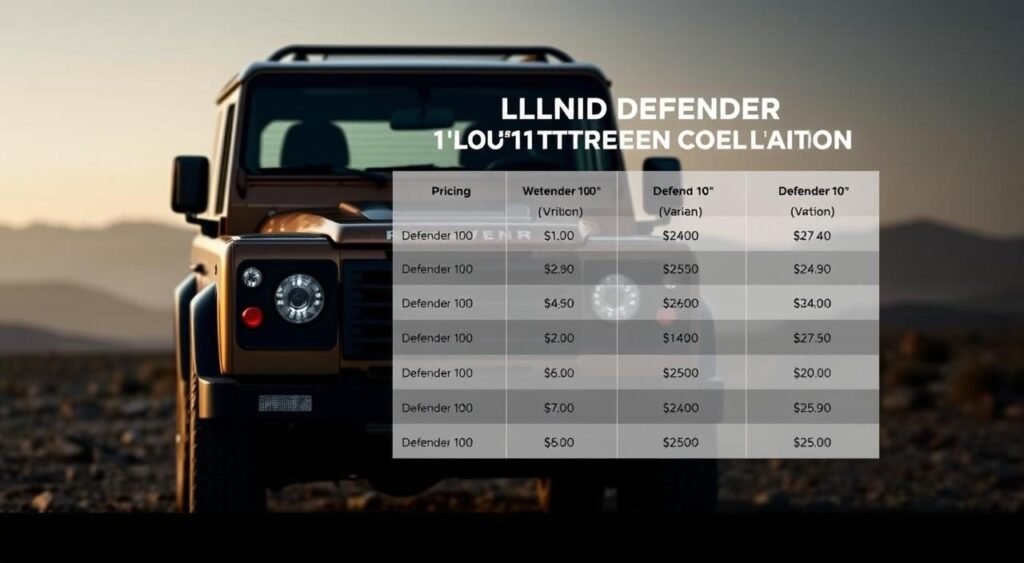
Value Proposition in the Price Range
The ₹1.30 Crore Land Rover Defender 110 Trophy Edition offers great value. It has exclusive adventure-oriented features and is made in limited numbers. It comes with unique design elements not found in standard models.
The price fits with JLR India’s 2026 model year plans. It’s priced alongside the Discovery Tempest Edition at ₹1.39 crore and the Discovery Gemini Edition at ₹1.26 crore. This special edition is perfect for those who love exclusivity and off-road adventures.
Performance Specifications
The Land Rover Defender Trophy Edition is a powerhouse in the luxury SUV world. It’s made for those who love adventure and need a vehicle that’s both smooth on the road and tough off it. This special edition combines top-notch engineering with tough durability.
Every part of its performance shows Land Rover’s dedication to making vehicles that can handle tough conditions.

Engine Power and Performance Metrics
The Land Rover Defender 110 Launch has a strong 3.0-liter inline-six twin-turbocharged diesel engine. It packs 350 horsepower and 700 Nm of torque, thanks to an 8-speed automatic transmission. The mild-hybrid tech boosts fuel efficiency without losing power.
It goes from 0 to 100 kph in 6.4 seconds and tops out at 191 kph. The four-wheel drive system keeps it stable on any road or trail.
Off-Road Capabilities
The Terrain Response 2 tech adjusts settings for different surfaces. It’s perfect for rocky paths, sandy dunes, or muddy tracks. The electronic air suspension gives great ground clearance and flexibility for overcoming obstacles.
The two-speed transfer case helps the Defender tackle steep hills and tough descents. It’s a true off-road winner and keeps comfort levels high for a premium SUV.
Interior Comfort and Technology
The Land Rover Defender 110 Trophy Edition offers luxury inside its iconic off-roader. Every detail shows careful craftsmanship and modern tech. It balances ruggedness with premium comfort, meeting high expectations.
Infotainment System Features
The heart of the Defender 110’s tech is an 11.4-inch Pivi Pro infotainment display. This touchscreen gives quick access to navigation, settings, and entertainment. It also supports Apple CarPlay and Android Auto for easy phone and music use.
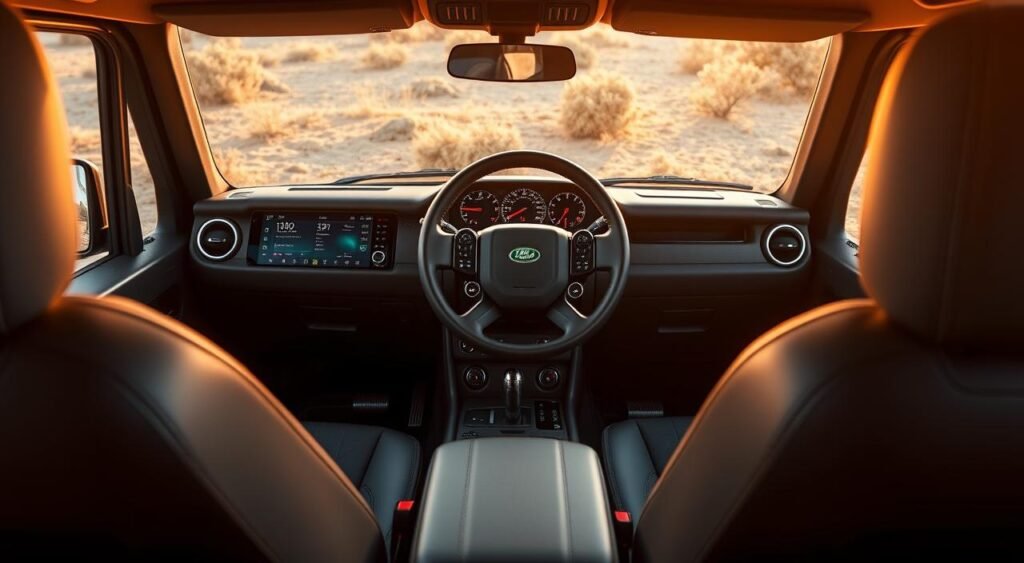
The Meridian sound system provides rich, clear audio. It’s placed in the cabin to enhance every drive. Whether in the city or on trails, it makes every journey special.
High-Quality Materials and Finishes
The Defender 110 Trophy Edition features exclusive Ebony Windsor leather on all seats. It has Trophy branding on LED sill plates, highlighting its special edition status. The dashboard’s crossbeam matches the paint color, with Trophy badges on the endcaps.
A panoramic sunroof lets in natural light. Configurable ambient lighting adds to the evening drive experience. These details make the Defender a luxurious space, rivaling top SUVs.
Safety Features and Ratings
The Land Rover Defender 110 Trophy Edition focuses on safety with advanced tech. It’s built to protect everyone, no matter where you drive. This luxury SUV combines old-school toughness with new safety features.
It has many safety tools that work together. They help keep you safe on the road and off.
Advanced Driver Assistance Systems
The Land Rover Trophy Edition has a 360-degree camera system. It gives you a full view around the vehicle. This is great for tricky off-road driving and tight spots.
The Terrain Response 2 system adjusts to the surface you’re on. It helps keep control and safety.

Electronic air suspension keeps the vehicle stable on different terrains. It also adjusts to the load. The front underbody protection shield keeps important parts safe during rough terrain.
Other safety features include:
- Blind Spot Assist with Close Vehicle Sensing
- Emergency Braking with Pedestrian Detection
- Lane Keep Assist with active steering correction
- Adaptive Cruise Control with Stop & Go functionality
- Clear Exit Monitor for passenger safety
Crash Test Ratings
The Land Rover Defender 110 has top safety ratings from big testing groups. Its strong body and airbags protect everyone inside.
| Testing Organization | Overall Rating | Adult Occupant | Child Occupant |
|---|---|---|---|
| Euro NCAP | 5 Stars | 90% | 85% |
| IIHS | Top Safety Pick | Good | Good |
| ANCAP | 5 Stars | 89% | 86% |
Customization Options Available
The ₹1.30 Crore Land Rover Defender 110 Trophy Edition lets buyers personalize their vehicle. Land Rover offers a range of exterior and interior options. This way, owners can create a unique vehicle that fits their lifestyle and preferences.
Exterior Color Choices
There are two exclusive paint finishes to choose from. The Deep Sandglow Yellow honors classic expedition vehicles. On the other hand, Keswick Green adds a sophisticated touch to the outdoors. Both colors come with a matte protective film to protect against scratches and stone chips during off-road adventures.
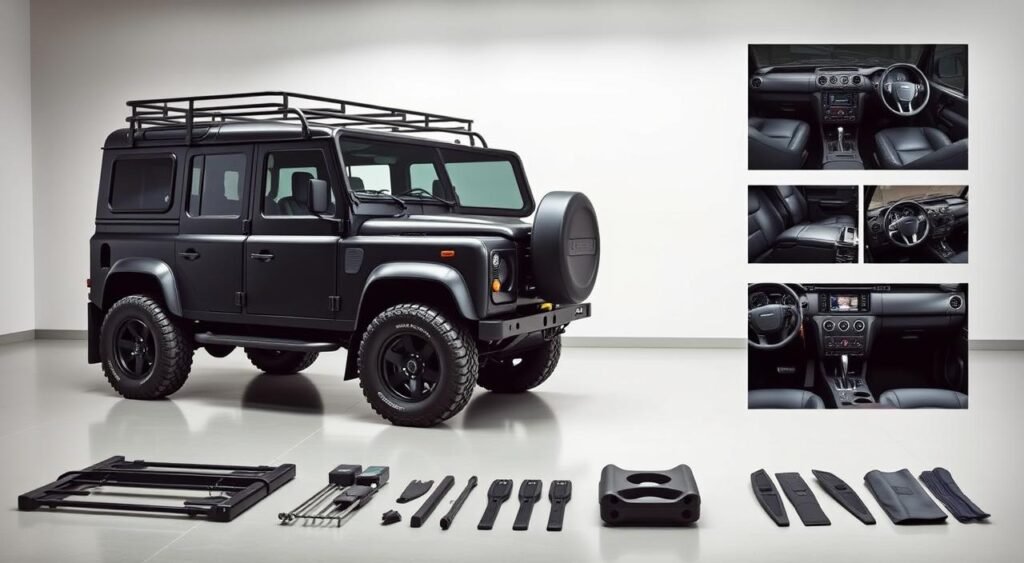
The Land Rover Defender 110 Launch comes with practical exterior accessories for serious expeditions:
- Heavy-duty roof rack system for extra gear storage
- Black deployable side ladder for roof access
- Side panniers providing additional cargo capacity
- Protective mud flaps
- Black-finished snorkel for water crossings
Interior Personalization
The ₹1.30 Crore Land Rover Defender 110 features 20-inch gloss black wheels. Buyers can choose between all-season or all-terrain tires. The cabin offers rugged capability and premium comfort, supporting both daily driving and weekend adventures. Each customization option fits seamlessly with the Trophy Edition’s design philosophy.
Upcoming Launch Events and Promotions
Jaguar Land Rover India is excited to introduce the Land Rover Defender Trophy Edition. This marks a big step for the brand’s 2026 lineup. It shows their commitment to luxury SUVs in India.
Launch Event Highlights
The Land Rover Defender 110 Trophy Edition will launch in major Indian cities. Events will be held in Mumbai, Delhi, and Bangalore. Here, people can see the vehicle up close.
Each event will have interactive displays that connect the vehicle to the Camel Trophy. Attendees will also get to try virtual reality. It will take them through the Amazon Basin and other tough terrains.
There will be test drives on obstacle courses. This will show off the Defender Trophy Edition’s off-road skills.
Promotions for Early Buyers
Early buyers of the Land Rover Defender 110 Trophy Edition will get special perks. These include:
- Complimentary five-year service package
- Priority delivery within 60 days
- Exclusive Trophy Edition merchandise collection
- Invitation to Land Rover Experience drives at premium locations
The first 100 buyers will get a limited-edition scale model. It’s a special keepsake for this launch in India.
Comparison with Competitors
The luxury SUV market in India is very competitive. The Land Rover Defender 110 faces tough competition. It aims to stand out by combining capability and prestige.
Rivals in the Luxury SUV Segment
The Mercedes-Benz G-Class G 450d is a main rival. It’s priced like the Defender 110. Both are known for being tough and great off-road.
- BMW X7 xDrive40i – focuses on luxury and on-road comfort
- Audi Q7 – emphasizes technology and refined driving experience
- Volvo XC90 – prioritizes safety and Scandinavian design
Factors that Set Defender 110 Apart
The Land Rover Defender 110 has a special Camel Trophy heritage. It reminds us of epic adventures. The Sandglow color is a nod to classic expedition vehicles, creating a unique bond with buyers.
The Terrain Response 2 system makes the Defender 110 excel off-road. It adjusts settings for different terrains, helping drivers of all levels. While the G-Class is also capable, the Defender offers modern tech and a better price.
Customer Reviews and Feedback
The ₹1.30 Crore Land Rover Defender 110 has made a big splash in the luxury SUV world. People who bought it and car experts have shared their thoughts. They talk about how it performs in real life and its worth.
Initial Impressions from Customers
Those who bought the Land Rover Trophy Edition love its bold look and design. Its unique shape and tall stance make it stand out. They also like the special badges and features that make their vehicle unique.
Here’s what customers have said:
- Exceptional build quality with premium materials throughout
- Impressive off-road capability matching its expedition heritage
- Spacious interior accommodating seven adults comfortably
- Strong emotional connection to the Camel Trophy legacy
Expert Reviews and Ratings
Car critics give the Land Rover Trophy Edition high marks for its luxury and power. They give it scores from 4.2 to 4.6 out of 5 stars. The ₹1.30 Crore Land Rover Defender 110 is praised for its advanced off-road system and smooth driving.
Experts say the Trophy Edition is a great mix of new tech and classic adventure spirit. Its rarity adds to its appeal, making it a top pick in India’s luxury SUV market.
Conclusion: Is the Trophy Edition Worth the Price?
The Land Rover Defender Trophy Edition costs ₹1.30 crore. It’s for serious off-road fans and collectors. It has 350 horsepower diesel power and special styling inspired by Camel Trophy.
The price shows it’s a rare model with collector value. It’s not just about its power, but its rarity and appeal.
Final Thoughts on Value and Features
The Land Rover Defender 110 Launch has features that make it worth more. It comes with top-notch off-road tech and luxury. This makes it stand out in the luxury SUV world.
The Trophy Edition has real off-road power. It has systems for different terrains, locking differentials, and wade sensing. It also has premium materials and modern tech inside.
Target Audience for the Defender 110 Trophy Edition
The Land Rover Defender Trophy Edition is for those who love heritage and modern tech. It’s perfect for those who want off-road power and comfort. It’s also great for collectors who value Land Rover’s history.
Business leaders, outdoor fans, and car collectors are its main audience. This model connects the past and present of the Defender lineup.
FAQ
What is the price of the Land Rover Defender 110 Trophy Edition in India?
The Land Rover Defender 110 Trophy Edition costs ₹1.30 crore (ex-showroom). This price is before adding any extra accessories. It’s more than the standard Defender but less than the high-performance Defender V8.
What engine powers the Trophy Edition Land Rover Defender 110?
It has a 3.0-litre, inline-six, twin-turbocharged diesel engine. This engine makes 350hp and 700Nm of torque. It comes with an 8-speed automatic transmission and standard four-wheel drive. It goes from 0-100kph in 6.4 seconds and has a top speed of 191kph.
What are the exclusive color options available for the Trophy Edition?
You can choose from two special colors: Deep Sandglow Yellow and Keswick Green. Both colors have black finishes on the roof, bonnet, and more. They also have Trophy Edition decals on the bonnet and C-pillar.
How does the ₹1.30 Crore Land Rover Defender 110 compare with competitors?
The Trophy Edition faces off against the Mercedes-Benz G-Class G 450d. It stands out with its Camel Trophy heritage, unique styling, and off-road tech like Terrain Response 2.
What special features justify the Trophy Edition’s premium pricing?
It comes with Ebony Windsor leather seats and an exposed crossbeam. It also has an 11.4-inch Pivi Pro infotainment system and Meridian sound system. You can add a heavy-duty roof rack, deployable side ladder, side panniers, and a black-finished snorkel.
Is the Land Rover Defender 110 Launch part of a larger range?
Yes, it’s part of JLR India’s 2026 model year range. This range also includes the Discovery Tempest Edition at ₹1.39 crore and Discovery Gemini Edition at ₹1.26 crore. This shows Land Rover’s commitment to the Indian luxury SUV market.
What is the significance of the Camel Trophy connection?
The Trophy Edition honors the legendary Camel Trophy expeditions from 1980 to 2000. These events showcased Land Rover’s off-road prowess in extreme conditions worldwide. They helped establish the brand’s reputation for adventure and capability.
What advanced safety and off-road features does the Land Rover Defender Trophy Edition include?
It has a 360-degree camera system and front underbody protection. It also has electronic air suspension and Terrain Response 2 technology. It includes a configurable ambient lighting system, three-zone climate control, and driver assistance systems for safety and off-road navigation.
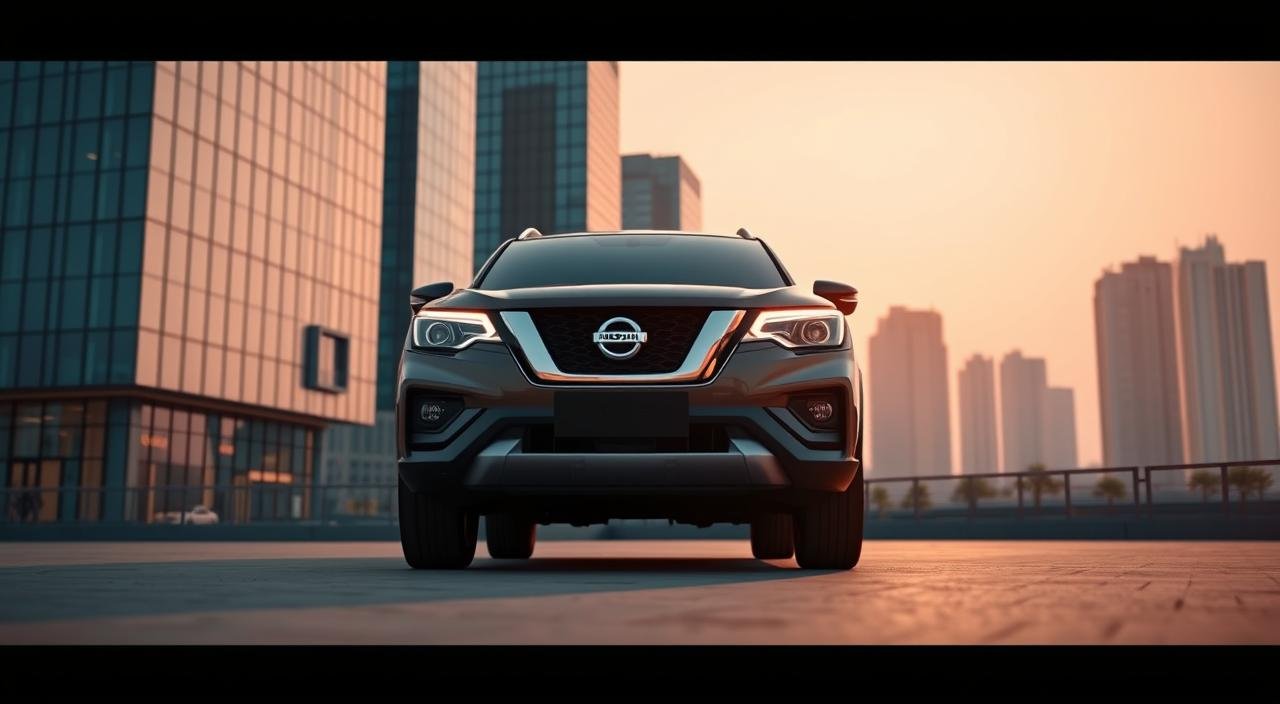
Oct
Nissan’s share in India’s car market has plummeted by 93% in ten years. Now, they have less than 0.5% of the market. This is a critical moment for Nissan in India.
The Tekton is more than just a new car. It’s a chance for Nissan to regain its footing in India’s competitive market. Set to launch in 2026, it draws inspiration from the Nissan Patrol, known for its ruggedness.
Nissan’s Chennai plant will make the Tekton for both Indian buyers and those abroad. The name, inspired by Greek words for craftsman, shows Nissan’s focus on quality. This car is part of Nissan’s plan to connect global markets while meeting local tastes.
Saurabh Vatsa, Nissan’s India head, sees the Tekton as key to their comeback. Nissan faces tough competition from Hyundai, Maruti Suzuki, and Tata Motors. The compact SUV market is where they can show they’re relevant to Indian buyers.
Key Takeaways
- The Tekton compact SUV launches in 2026 as Nissan’s flagship model for market recovery
- Manufacturing happens at Chennai facility for both domestic and export markets
- Design inspiration comes from the legendary Nissan Patrol SUV
- The vehicle represents Nissan’s second product under its One Car One World strategy
- Nissan currently holds less than 0.5% market share in India after years of decline
- The Tekton name means craftsman in Greek, reflecting engineering excellence
Overview of Nissan’s Current Situation in India
Nissan is at a key moment in India’s car market. It was once a hit with the Micra and Sunny. Now, it’s facing a drop in Nissan India market share and needs to boost its presence in this booming market.
Recent Challenges Faced by Nissan India
Nissan has faced tough times in India. Sales fell after it stopped making the Terrano and Kicks. The number of dealerships went from over 270 in 2018 to about 140 in 2023. Customers are upset because service centers can’t get parts.
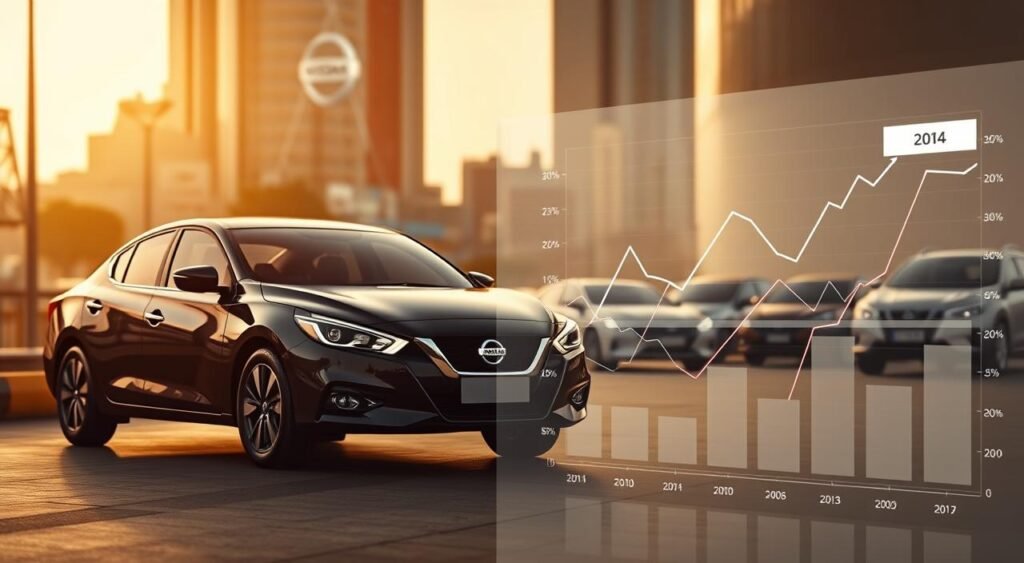
Market Position and Competition
Nissan now has less than 1% of India’s car market. The Magnite SUV is its main seller, with 3,000 units sold each month. Hyundai and Maruti Suzuki lead with over 60% of the market. The X-Trail SUV is pricey at ₹49.92 lakh but sells very few units.
Consumer Sentiment and Brand Perception
Indian car buyers have mixed views on Nissan. They like the Magnite but are worried about service. People are concerned about costs and resale value. The Tekton impact on Nissan could change things if Nissan fixes service issues and offers better support.
Introduction to the Nissan Tekton
Nissan has entered the SUV market with the Tekton. This vehicle aims to boost the brand’s image in the automotive industry in India. It combines bold looks with practical features for Indian buyers. The Tekton takes inspiration from Nissan’s Patrol but fits local tastes and prices.
Specifications and Features of the Tekton
The Tekton looks powerful, thanks to its Patrol-inspired design. Its front has a sculpted bonnet and unique C-shaped LED lights. The front bumper makes it stand out from other SUVs.
The side view shows a strong stance and clean lines. The Double-C door design nods to mountain ranges, like the Himalayas. The rear has a red light bar and C-shaped tail-lamps with the Tekton name on the tailgate. Alfonso Albaisa calls it imposing and stylish, aiming to set new standards in the automotive industry in India.
Target Audience for the Tekton
The Tekton is for urban families wanting a premium SUV without a high price. Young professionals and growing families are its main audience. This shows Nissan’s new approach to meet India’s growing middle class.
Comparison with Nissan’s Previous Models
The Tekton is built on the Renault Duster platform, like the Terrano. Its interior looks more premium than the Duster’s third generation. This shows Nissan’s effort to improve and gain more market share in India’s SUV market.
The Role of Electric Vehicles in Nissan’s Strategy
Electric vehicles are key to Nissan’s plan to turn things around in India. The company is changing its lineup to meet the demand for cleaner, more efficient cars. The Tekton might come with different powertrain options to attract various buyers.
Electrification Trends in India
India’s car market is quickly moving towards electric and hybrid vehicles. Sales of these cars jumped by 49% in 2023. People want cars that save fuel and cost less to run. Cities like Delhi, Mumbai, and Bangalore are leading this change.
The Tekton could lead the way with advanced powertrain options. This would put Nissan ahead of its competitors.
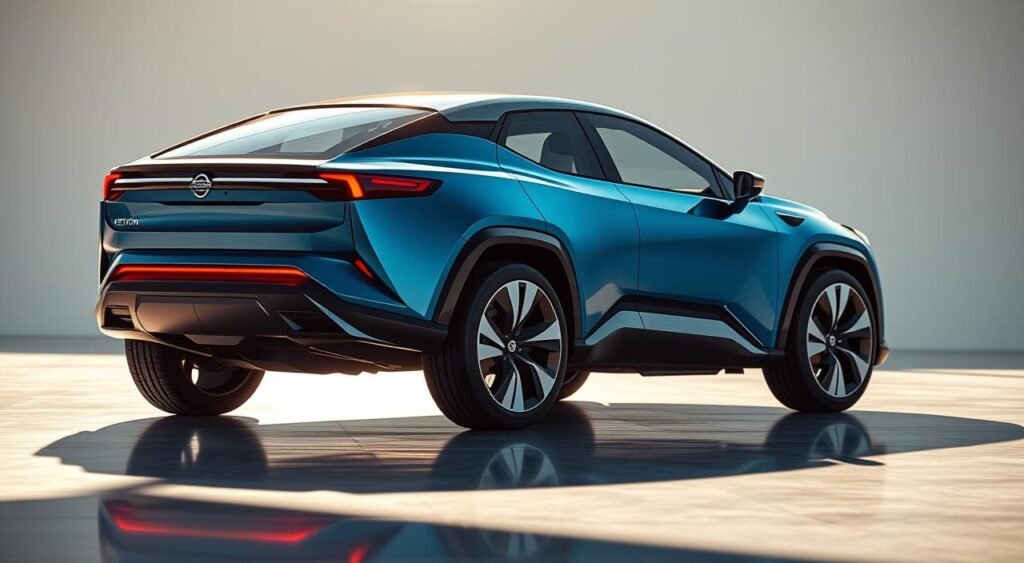
The Tekton as an Electric Vehicle
The Tekton might have a petrol engine or a hybrid system. A hybrid version would make Nissan competitive with Maruti Suzuki Grand Vitara and Toyota Urban Cruiser Hyryder. This approach could help Nissan attract both traditional and eco-friendly buyers.
Government Policies Supporting EV Adoption
The Indian government is making electric cars more appealing. The FAME II scheme offers up to ₹1.5 lakh in incentives for electric cars. State governments also offer benefits like waived registration fees and lower road taxes.
These policies are great for the Tekton’s success in the market. If Nissan introduces electric variants, it could really benefit.
Competitive Landscape in the Indian Automobile Market
The compact SUV segment is a hot spot for car makers in India. People want cars that are good for city driving and comfortable on highways. Tekton Nissan India is joining the fray, but it faces tough competition from established brands.
Key Competitors for Nissan India
Several big names lead the compact SUV market. The Hyundai Creta tops the list, selling over 15,000 units every month. The Kia Seltos is close behind, known for its premium features and style.
Maruti Suzuki Grand Vitara uses its wide service network to its advantage. Honda Elevate and Toyota Hyryder focus on reliability.
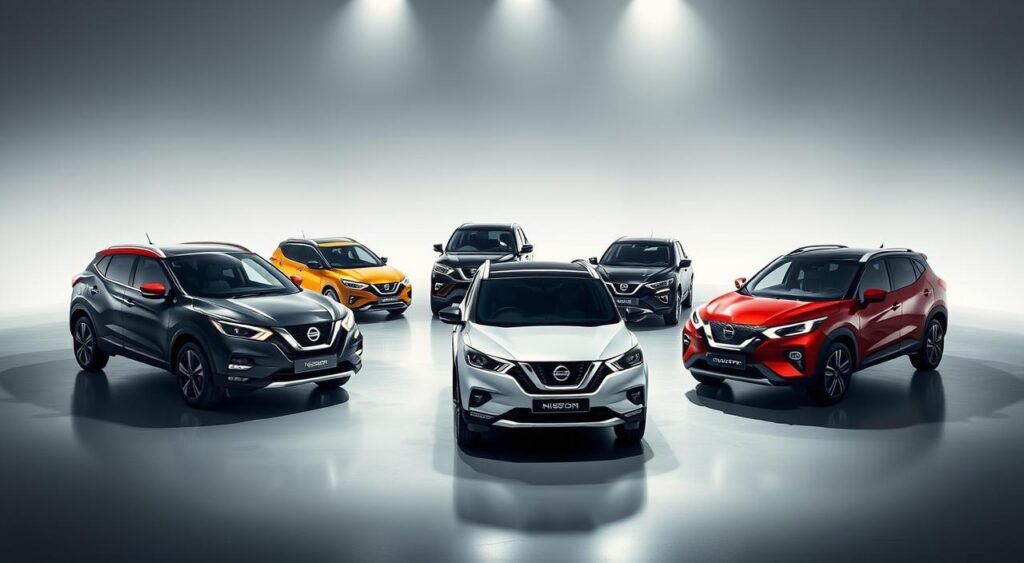
Strategies Employed by Rivals
Competitors use different strategies to attract buyers. Hyundai and Kia offer cars with lots of features like panoramic sunroofs and ventilated seats. Maruti Suzuki focuses on saving money on fuel and maintenance.
Toyota appeals to those who care about the environment with hybrid powertrains.
How the Tekton Stands Against Competitors
The Tekton Nissan India stands out with its true SUV design. It has a strong build and lots of room inside. It’s priced well, making it a good deal compared to others.
But, it doesn’t have a sunroof, which might hurt its sales. Sunroofs are very popular in India.
Marketing Strategies for the Tekton Launch
Nissan aims to make a big splash in India’s C-SUV market with the Tekton. They want to show off their rich history and meet the needs of ambitious buyers. These strategies focus on what Indian customers want, while keeping Nissan’s global image in mind.
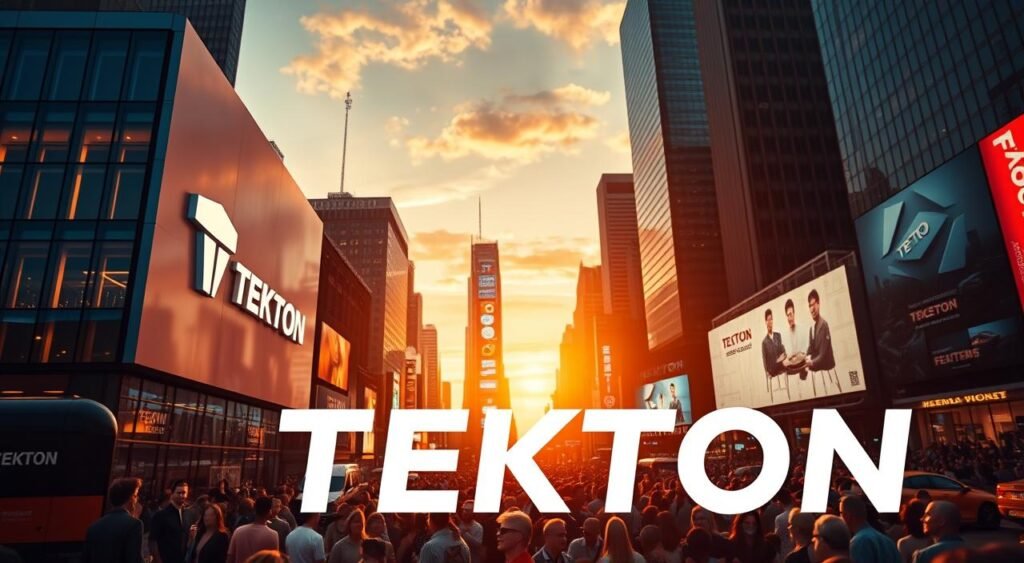
Approaches to Reach Target Consumers
The Tekton’s marketing campaign leans on its Patrol legacy to attract buyers. Nissan is looking at creative professionals and young families. They highlight the car’s global standards, made for Indian roads.
Utilizing Digital Marketing Channels
Digital marketing is key for Nissan’s Tekton. They use:
- Social media campaigns on Instagram and YouTube to show off design
- Virtual showrooms for online exploration
- Targeted ads for urban 25-45 year olds
- Interactive configurators on Nissan India’s website
Collaborations and Partnerships
Strategic partnerships boost the Tekton’s appeal. Nissan teamed up with Renault for cost-effective production in Chennai. This partnership helps keep costs down while keeping quality high.
Nissan also plans to expand its dealer network. They aim to reach more buyers in tier-1 and tier-2 cities. This strategy targets both the domestic market and select export markets.
Customer Feedback and Expectations
Customer feedback is key to the success of new cars. For the Tekton to increase Nissan India market share, it must meet buyer expectations. People have clear ideas about what they want in a car, including features and price.
Insights from Potential Buyers
Indian buyers want top-notch interior features. They look for:
- 10.1-inch infotainment touchscreen with wireless Android Auto and Apple CarPlay
- 7-inch digital instrument cluster for a modern look
- Wireless charging for easy use
- Premium materials and finishes inside
They also like personalizing their cars. The Tekton bonnet lettering is a hit as a way to make the car unique.
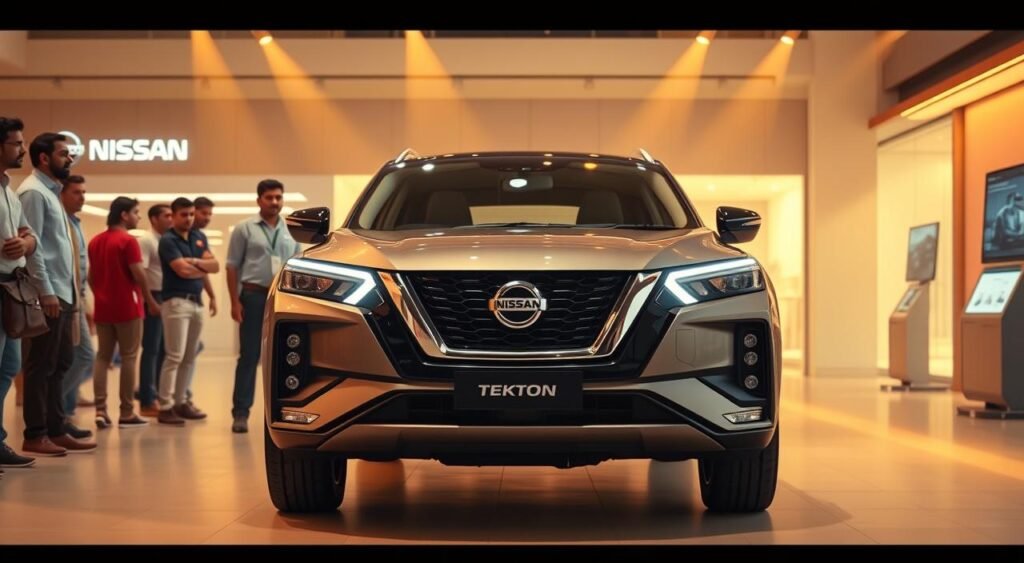
Importance of Customer Reviews
Online reviews and word of mouth are big in India’s car market. What early buyers say about the Tekton will shape opinions. Good feedback on quality, features, and value can help it gain acceptance.
Addressing Common Concerns
Buyers worry about how the Tekton compares to Hyundai Creta and Kia Seltos. It must be seen as a premium car to match its price. Also, making sure there are enough service centers and affordable spare parts is key to growing Nissan India market share.
Dealership Network and Availability
Nissan India aims to strengthen its dealership network across the country. The launch of Tekton in 2026 will need a wider reach to serve tier-2 and tier-3 cities. Chennai will continue to be the main hub for both domestic sales and exports.
Expansion Plans for Nissan in India
Nissan plans to grow its dealership count from 270 to 350 by 2026. The auto industry in India is booming, with smaller cities becoming key markets. New showrooms will open in states like Uttar Pradesh, Gujarat, and Karnataka.
The company is focusing on areas with a growing middle class. These people are looking to buy modern vehicles.
Importance of Service and Maintenance
Service quality is key to keeping customers loyal in India’s competitive auto market. Nissan is addressing service center shortages by opening 100 new workshops. Each will have certified technicians trained in Chennai.
Regular maintenance packages start at ₹15,000 a year for basic coverage.
Strategies to Improve Customer Experience
Digital booking systems let customers schedule service appointments via mobile apps. Pick-up and drop services are available within 15 kilometers of dealerships. Nissan’s turnaround includes 24/7 roadside assistance and extended warranties.
| Service Feature | Current Status | 2026 Target |
|---|---|---|
| Dealership Count | 270 | 350 |
| Service Centers | 180 | 280 |
| Mobile Service Vans | 25 | 75 |
| Customer Response Time | 48 hours | 24 hours |
Financial Implications for Nissan India
The launch of Tekton Nissan India is a big deal for the company. The price of the new model will decide if it can increase Nissan India market share. This is important for Nissan to get back on track in a tough market.
Expected Costs and Benefits of Tekton Launch
The Magnite showed that Nissan can sell well in India with the right price. The Tekton needs to be affordable but also have top features. Making it in Chennai with Renault-Nissan Alliance cuts costs by 15-20%.
Impact on Sales and Revenue Targets
Tekton Nissan India aims to sell 3,000-4,000 units a month to hit revenue targets. This goal is reachable, thanks to the X-Trail’s lesson on pricing. The Tekton could double Nissan India market share to 2.5% in two years.
Long-term Financial Outlook
Setting the Tekton’s price between ₹8-12 lakhs makes it a strong competitor. This price helps Nissan keep profits high while drawing in more buyers. Working with Renault also cuts costs by 30%, making the investment pay off in under three years.
Environmental Impact and Sustainability
The car industry is under pressure to cut its environmental harm. Nissan’s Tekton shows the company’s dedication to green driving. It’s not just about selling cars; it’s about being responsible in India.
Tekton’s Environmental Credentials
The Tekton might have a hybrid engine, which cuts down on emissions. This makes it a leader in car innovation. It’s all about being fuel-efficient and powerful. The Tekton has:
- Less carbon emissions with hybrid tech
- High fuel economy, aiming for 25+ km/l
- Light materials to make the car lighter
- Systems that capture energy through braking
Nissan’s Commitment to Sustainability
Building the Tekton in Chennai shows Nissan’s local focus. It cuts down on emissions and supports the local economy. The factory also uses water recycling and solar power.
Consumer Awareness and Eco-Friendly Practices
Indian buyers are now more aware of the environment. The Tekton’s green features attract them. Nissan teaches people about the benefits of eco-friendly cars, like saving money and being kind to the planet.
Conclusion: Can the Tekton New Success for Nissan India?
The Tekton is a big moment for Nissan India. It enters a market full of rivals like Hyundai Creta and Kia Seltos. Nissan must offer good prices, a strong network, and reliable service to stand out.
A hybrid powertrain could make the Tekton special. This could help it beat other cars.
Summary of Key Points
Nissan India’s future depends on many things. The Tekton has bold design and luxury inside to draw in buyers. Saurabh Vatsa thinks it will help Nissan grow in India.
The SUV has a strong look and wants to challenge the top cars. Alfonso Albaisa says it shows Nissan’s best SUV qualities. Success needs good pricing, positioning, and service.
Final Thoughts on Nissan’s Future
Nissan has a tough fight in India’s car market. It needs to win back trust and beat strong rivals. The Tekton aims to be premium and different with its design.
Nissan wants to give what today’s buyers want without high prices. Success will show in how well Nissan does at every step.
The Road Ahead for the Tekton
The Tekton’s journey in India will test Nissan’s dedication. Early feedback and sales will show if Nissan can turn things around. The SUV must stand out against other cars and find its own place.
Nissan’s growth depends on more dealers and better service. The Tekton is a chance for Nissan to shine in India again.
FAQ
What is the Nissan Tekton and when will it launch in India?
The Nissan Tekton is a compact SUV coming in 2026. It’s part of Nissan’s plan to come back strong in India. This SUV is inspired by the legendary Nissan Patrol and is the second car under Nissan’s One Car One World plan. It will be made in Chennai for both Indian buyers and some exports.
How does the Tekton fit into Nissan’s turnaround strategy for the Indian market?
The Tekton is key to Nissan India’s comeback, says Managing Director Saurabh Vatsa. After losing ground by stopping popular models like the Micra and Terrano, Nissan sees the Tekton as a game-changer. The plan includes more dealerships, better service, and good prices to win back customers.
What are the key design features and specifications of the Tekton?
The Tekton has a bold design inspired by the Patrol. It has a sculpted bonnet, C-shaped LED lights, and a strong front bumper. Its side looks upright with Double-C door accents, and the back has a red light bar and C-shaped tail-lamps.
It will have a big 10.1-inch screen for infotainment, a 7-inch digital display, and wireless charging.
Which competitors will the Tekton face in the Indian automotive industry?
The Tekton will compete in the compact SUV market. It will go up against the Hyundai Creta, Kia Seltos, and others. Its design is more like a traditional SUV, which might appeal to some buyers.
Will the Tekton offer hybrid or electric powertrain options?
Details on the Tekton’s engine are not out yet. But, it might have a petrol engine or a hybrid option. This could make it more appealing to buyers who want efficient cars and care about the environment.
What is Nissan’s current market share and position in India?
Nissan India’s market share is small. The Magnite is doing okay, but the X-Trail is too pricey. Nissan needs to improve its service network to win back customers and boost its reputation.
How will pricing impact the Tekton’s success in India?
Pricing is very important for the Tekton’s success. The Magnite shows that being affordable can help. But, the X-Trail’s high price didn’t work. Nissan needs to find the right price to compete well.
What role does the Renault partnership play in the Tekton’s development?
Nissan’s partnership with Renault helps in making the Tekton. It uses the Renault Duster platform, like the Terrano. This partnership lets Nissan make a premium car without spending too much.
What are the main challenges facing the Tekton launch?
The Tekton faces tough competition and might not have all the features buyers want. It lacks a sunroof, which is popular. Nissan needs to work on its service, pricing, and marketing to succeed.
How does Tekton leadership in the automotive sector view the vehicle’s ?
Alfonso Albaisa sees the Tekton as bold, stylish, and a new standard. Saurabh Vatsa believes it will lead Nissan’s growth in India. It has a strong look, premium interior, and aims to disrupt the market.
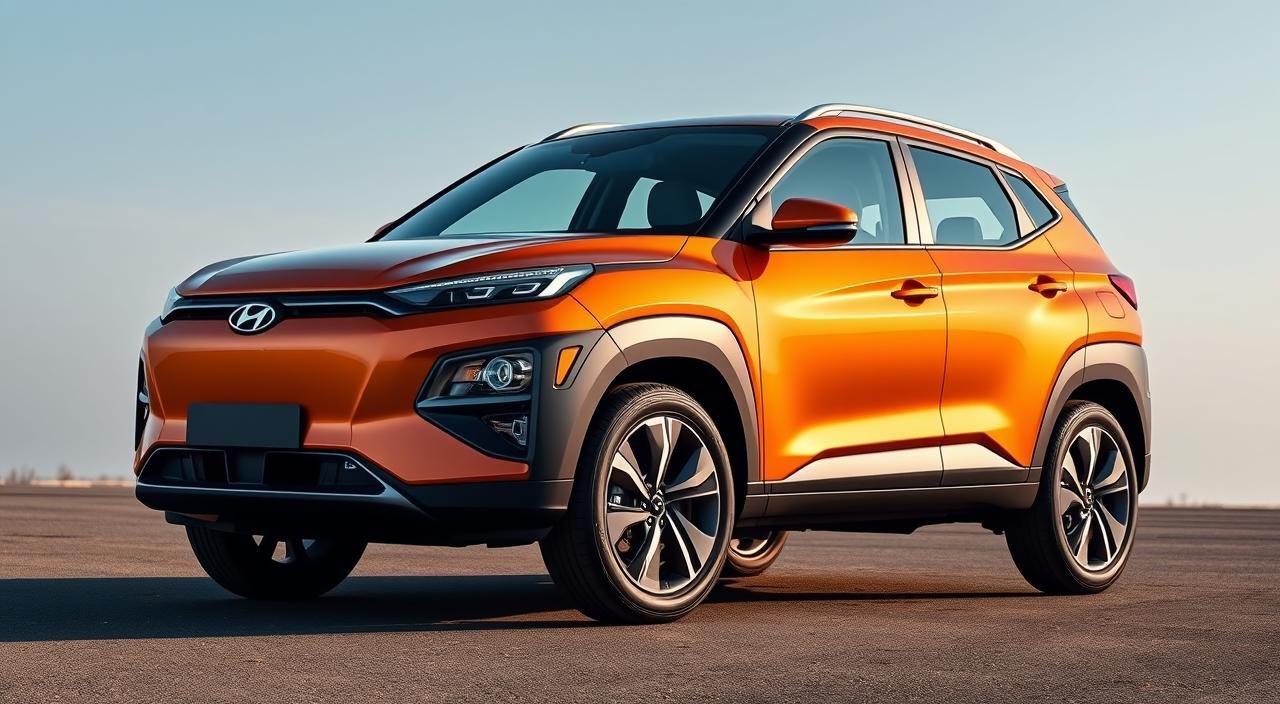
Oct
India’s electric vehicle market is set to explode, growing from 1.5 million units in 2023 to 10 million by 2030. Hyundai sees this as a chance to make a big splash with its new electric SUV. It’s designed for those who want to go green but don’t want to spend a lot.
Hyundai’s electric SUV is a big move for the company in India. It’s priced lower than the Creta Electric, aiming at middle-class families. The car will be made mostly in India to keep costs low while keeping quality high.
Hyundai is set to release this SUV between late 2026 and early 2027. It’s part of a plan to bring seven new models to India by 2030. The car is built to be perfect for city driving and long weekend trips.
The team behind the SUV has focused on making it fit India’s roads and parking spots. It will go head-to-head with Tata Motors and MG Motor in the affordable electric car market. Early signs suggest it will have features usually found in pricier models.
Key Takeaways
- Hyundai’s compact EV SUV will launch in India between late 2026 and early 2027
- The vehicle sits below the Creta Electric in Hyundai’s lineup for better affordability
- High localization levels will help reduce manufacturing costs and final pricing
- Part of Hyundai’s plan to introduce 26 products in India by 2030
- Designed for Indian urban environments and highway conditions
- Will compete with Tata Motors and MG Motor in the affordable EV segment
Overview of the Hyundai Compact EV SUV
The Hyundai SUV launch in India is a big deal for electric cars. This small electric SUV is Hyundai’s way to meet the growing need for cheap electric cars in India. It’s built with the latest EV tech, making it both useful and high-tech.
What Makes It Unique?
This electric car is special because of its Connected Car Navigation Cockpit. It uses NVIDIA tech and has two big screens. These screens make the car feel like a digital world. It also has over 70 smart car features and can understand more than 400 voice commands in five languages, including Hindi, English, and Tamil.

Key Features to Anticipate
This small EV SUV has top-notch features. You can expect:
- Level 2 Advanced Driver Assistance Systems for better safety
- Over-the-air updates for easy software fixes
- A big sunroof for a fresh feel
- Ventilated seats for comfort in India’s weather
- Wireless phone charging
- Ambient lighting for a fancy look
- A digital instrument cluster with customizable screens
| Feature Category | Specifications |
|---|---|
| Display System | Dual 12.3-inch panoramic screens |
| Voice Commands | 400+ commands in 5 languages |
| Connected Features | 70+ smart connectivity options |
| Safety Technology | Level 2 ADAS suite |
Hyundai’s Commitment to Sustainability
Hyundai is leading the way in making cars better for the planet. It’s making electric vehicles in India. This shows the company cares about the environment and wants to meet the growing demand for green cars.
The Role of Electric Vehicles
Hyundai sees electric cars as key to cutting down on pollution in India. It plans to launch eight hybrid models by 2030. This move aims to make cities cleaner and greener.
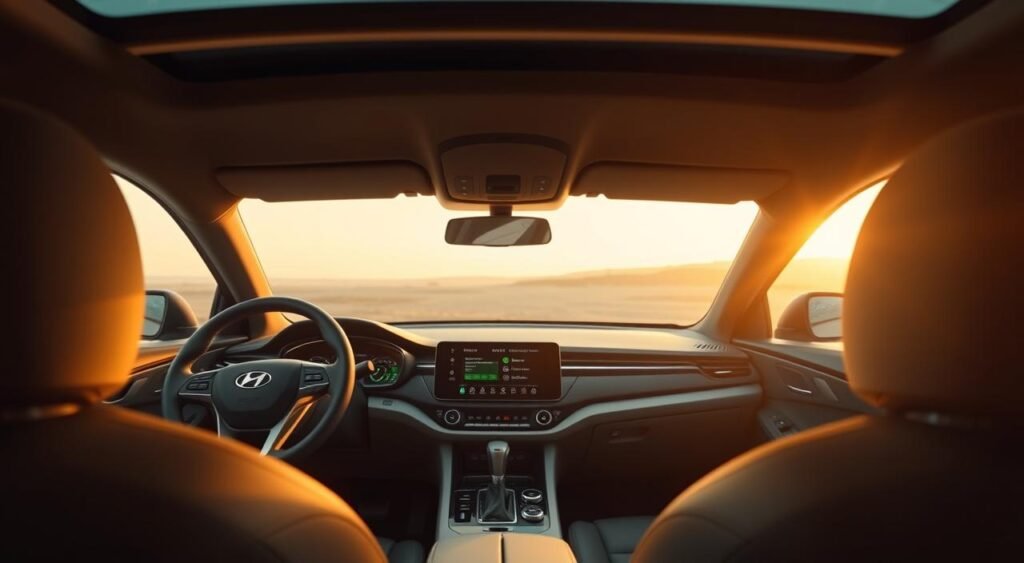
The Hyundai EV program focuses on making cars in India. This helps reduce pollution from shipping. The cars also use recycled materials, keeping them eco-friendly without losing comfort.
Eco-Friendly Production Processes
Hyundai’s factories use new methods to save energy and waste. The new SUVs will be made with 71% high-strength steel. This makes them strong yet lighter, saving energy.
- Recycled materials integrated into interior components
- High-strength steel construction reduces overall weight
- Localized production cuts transportation emissions
- Solar panels power manufacturing facilities
Hyundai’s factories run on solar power and recycle water. These steps make the Hyundai EV a smart choice for those who care about the planet.
Target Market for the Compact EV SUV
The Made-in-India Hyundai Compact EV SUV is for those who want an electric car but don’t want to spend a lot. It’s priced between Rs 10-18 lakh, making it perfect for middle-class families and young professionals. Its compact size is great for city driving, yet it has enough room for weekend trips.
Understanding Indian Consumer Preferences
Indian buyers look for value for money and practical features. Hyundai has carefully studied these preferences. They want electric cars that are reliable, have low running costs, and enough range for daily use. Space is also important, as one car often serves the whole family.

- Affordable pricing under Rs 18 lakh
- Minimum range of 300 kilometers
- Spacious interiors despite compact dimensions
- Strong service network coverage
- Low maintenance requirements
Competing Models in the EV Segment
The electric SUV market in India is competitive. The Tata Nexon EV leads with its good price and reliability. The MG ZS EV caters to those who want a premium option. The upcoming Maruti eVX and Kia Syros EV will add to the competition. Each model has its own strengths, giving buyers a wide range of choices.
Design Innovations in the New SUV
The new Hyundai electric SUV is designed for Indian roads and tastes. It’s based on the global Inster EV platform but has big changes for local markets. The design team removed quirky elements from international versions, making it look clean and sophisticated for Indian buyers.
Exterior Features and Aesthetics
The Indian Hyundai EV is small and perfect for city streets. Its sleek design is both modern and practical. The front has a closed grille and sharp LED headlights, making it stand out.
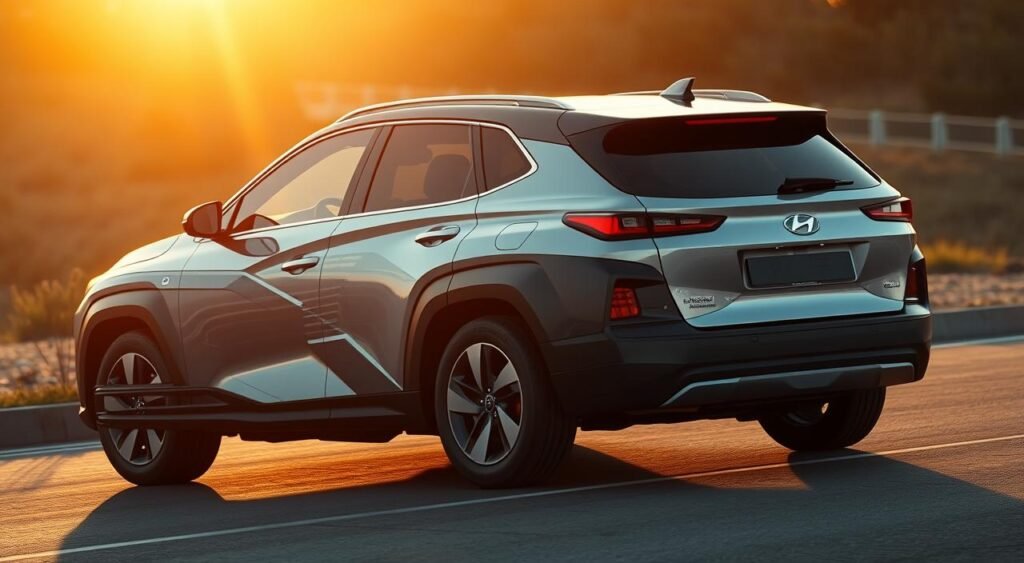
The sides have sculpted lines for better aerodynamics and a strong look. The designers added flush door handles and special alloy wheels for style and efficiency.
Interior Layout and Technology
Inside, the SUV feels luxurious with premium materials. You can pick from navy and dove grey upholstery with Moon White ambient lighting. This creates a calm mood for evening drives.
The tech highlight is the dual 12.3-inch curved displays. They merge the infotainment system with the digital driver cluster. This setup makes controlling the car and navigation easy. A Bose 8-speaker system is standard, making every drive a great audio experience.
Performance Specifications
The upcoming Hyundai SUV launch in India is set to impress with its performance. It offers efficient power and practical range options. This makes it perfect for city and highway driving. Plus, it stays up-to-date with remote updates, ensuring continuous improvements.
Powertrain Details
The electric motor in this SUV produces 100 to 120 PS of power. It provides smooth acceleration for daily drives and long trips. This setup means instant torque, lower costs, and better performance in all driving conditions.
Battery Range and Charging Options
Customers can pick from Standard Range or Long Range battery packs. The range is 300 to 350 kilometers per charge, depending on the battery. This choice lets buyers match their needs with their budget.
The Hyundai electric vehicle also comes with over-the-air (OTA) updates. These updates can enhance performance, add new features, and boost security. This means the SUV gets better and safer without needing a service visit.
Safety Features and Ratings
The India-made Hyundai EV is loaded with the latest safety tech. It’s designed to keep passengers safe in all driving scenarios. This electric SUV leads in safety with over 65 features built into its platform.
Advanced Driver Assistance Systems
The Hyundai compact SUV boasts a SmartSense ADAS Level 2 suite with 16 features. It has Smart Cruise Control for safe following distances. Forward Collision-Avoidance Assist can apply emergency brakes when needed.
Lane Keeping Assist helps prevent unintentional lane changes. It gently corrects steering.

All variants come with 33 essential safety features. They have six airbags for full protection. Electronic Stability Control keeps the vehicle stable during emergencies.
Hill-start assist prevents rollback on slopes. All-wheel disc brakes ensure confident stopping in various conditions.
Crash Test Ratings Expected
The India-made Hyundai EV has 71% high-strength steel construction in its body. This strong build is expected to perform well in crash tests. The blind spot view monitor shows camera feeds when turning.
A voice-enabled electric sunroof includes anti-pinch technology. Experts think this SUV will get top safety ratings. This is due to its advanced protection systems and sturdy construction for Indian roads.
Pricing Strategy and Variants
The Made-in-India Hyundai Compact EV SUV Coming Soon has a pricing plan made just for Indian buyers. The electric car market in India wants prices that are fair but not cheap. Hyundai aims to find this sweet spot by using more local parts and planning different models carefully.
Anticipated Price Range
The new electric SUV will start under Rs 10 lakh for the basic model. The top models with extra features and longer range will cost up to Rs 18 lakh. This pricing makes electric cars more affordable for many Indian families.
There will be two main battery options: Standard Range and Long Range. Each option will have different trims with various features and tech.
Comparison with Competing Models
The pricing in the compact electric SUV market is quite interesting:
| Model | Starting Price (Rs) | Top Variant (Rs) | Battery Range (km) |
|---|---|---|---|
| Hyundai Compact EV | 9.99 lakh | 18 lakh | 350-450 |
| Tata Nexon EV | 14.74 lakh | 19.94 lakh | 325-465 |
| Mahindra XUV400 | 15.49 lakh | 19.39 lakh | 375-456 |
| MG ZS EV | 21.99 lakh | 25.75 lakh | 419-461 |
The Made-in-India Hyundai Compact EV SUV Coming Soon is priced to compete well. Making it in India saves a lot of money compared to importing parts.
Distribution and Availability
The upcoming Hyundai electric SUV will be available across India. Hyundai plans to use its current dealership network. This way, customers can find the new Indian Hyundai EV in major cities and towns.
With over 550 showrooms and 1,350 service points, finding a place for test drives, purchases, and maintenance is easy. This makes buying and maintaining the vehicle convenient for everyone.
Launch Timeline in India
The Indian Hyundai EV is set to arrive between late 2026 and early 2027. Customers can book by paying Rs 25,000 at authorized dealerships. This timing fits with Hyundai’s plans to electrify the Indian market.
- Online reservations through Hyundai’s official website
- Offline bookings at dealership locations
- Priority delivery based on booking sequence
- Flexible payment options including EMI schemes
Expansion Plans Beyond India
After India, the Hyundai electric SUV will go to Southeast Asia and Africa. Hyundai’s Chennai plant will be the export hub. Genesis, Hyundai’s luxury brand, will also come to India in 2027.
This move will make Hyundai a major player in the global EV market. It will also make India a key production center for new markets.
Customer Experience and After-Sales Service
The new Hyundai SUV launch in India comes with top-notch customer support. It sets a high bar for electric vehicles. You’ll find extensive service coverage through Hyundai’s wide network of dealerships and service centers across the country.
Hyundai has trained its technicians well for the electric vehicle release. This ensures your vehicle gets the best maintenance.
Hyundai’s Service Network
Hyundai has over 530 dealerships and 1,350 service points in India. Each place is equipped for electric vehicle servicing. They also offer over-the-air (OTA) updates to boost your SUV’s performance without needing a visit to the dealership.
The vehicle supports voice commands in five regional languages: Hindi, English, Tamil, Telugu, and Bengali. This makes the technology easy for many Indian customers to use.
Warranty and Maintenance Plans
Hyundai has great warranty packages for its electric SUV:
| Coverage Type | Duration | Kilometers |
|---|---|---|
| Vehicle Warranty | 3 years | Unlimited |
| Battery Pack | 8 years | 160,000 km |
| Roadside Assistance | 3 years | Unlimited |
| Free Maintenance | 3 years | 40,000 km |
The SUV comes with premium comfort features. These include an electric 4-way driver seat adjustment with ventilation, rear window sunshades, and reclining rear seats. These features make the SUV a great choice for Indian families looking for luxury in an electric vehicle.
Conclusion: The Future of Hyundai in India
Hyundai is set to change India’s electric vehicle market with its smart plan for affordable electric cars. The company aims to launch seven new models by 2030. This shows Hyundai knows what Indian buyers want and can afford.
The India-made Hyundai EV will focus on the growing middle class. They want cars that are good for the planet.
Predictions for Market Impact
The new Hyundai compact SUV is made to fill a gap in India’s EV market. It will have a name that shows it’s made for India. Experts think it will compete with Tata Nexon EV and MG ZS EV.
Hyundai plans to keep prices low by making more of the car in India. This will also help it meet India’s emission rules.
Final Thoughts on the Compact EV SUV
Hyundai is also working on more SUVs, including family movers and off-road vehicles. The company is all about making cars that are good for the planet and made locally. With a strong service network and good reputation, Hyundai is ready to take a big share of the market.
The compact EV SUV is just the start of Hyundai’s electric journey in India.
FAQ
When will the Made-in-India Hyundai Compact EV SUV launch?
The Hyundai electric SUV is set to hit the Indian market between late 2026 and early 2027. It’s part of Hyundai’s plan to introduce seven new models in India by 2030.
What is the expected price range for the Indian Hyundai EV?
The electric SUV is expected to start at under Rs 10 lakh for the base model. The top model could go up to Rs 18 lakh ex-showroom. This pricing aims to compete with the Tata Nexon EV and Kia Syros EV.
Which platform will the Hyundai SUV launch India model use?
The SUV will likely use the Hyundai Inster EV platform or a Venue EV variant. It’s been modified for the Indian market, focusing on cleaner looks and removing quirky designs.
What are the key features of the Hyundai electric vehicle release?
The SUV boasts Level 2 ADAS with 16 driver assistance features. It has dual 12.3-inch displays and a premium sound system by Bose. It also features a panoramic sunroof, ventilated seats, and wireless charging. The system supports over 400 voice commands in five languages.
What battery options and range will the Hyundai compact SUV details include?
The EV will have Standard Range and Long Range battery packs. It’s expected to have a range of 300-350 km. The electric motor produces 100-120 PS for fast performance, with OTA updates for continuous improvement.
How does the India-made Hyundai EV support sustainability?
Hyundai uses recycled materials in the interior and focuses on environmental goals. The SUV is built with 71% high-strength steel for durability. Hyundai plans to launch eight hybrid models by FY2030.
What safety features are included in the Hyundai upcoming SUV news?
The SUV has over 65 safety features, with 33 standard across all models. It includes six airbags, ESC, and hill-start assist. It also has a blind spot view monitor and voice-enabled electric sunroof. The Hyundai SmartSense ADAS Level 2 system offers Smart Cruise Control and more.
How can customers book the new Hyundai electric SUV in India?
Bookings are available through Hyundai’s nationwide network with a Rs 25,000 token. Customers will enjoy Hyundai’s service infrastructure and OTA updates for continuous improvement. This enhances the ownership experience.
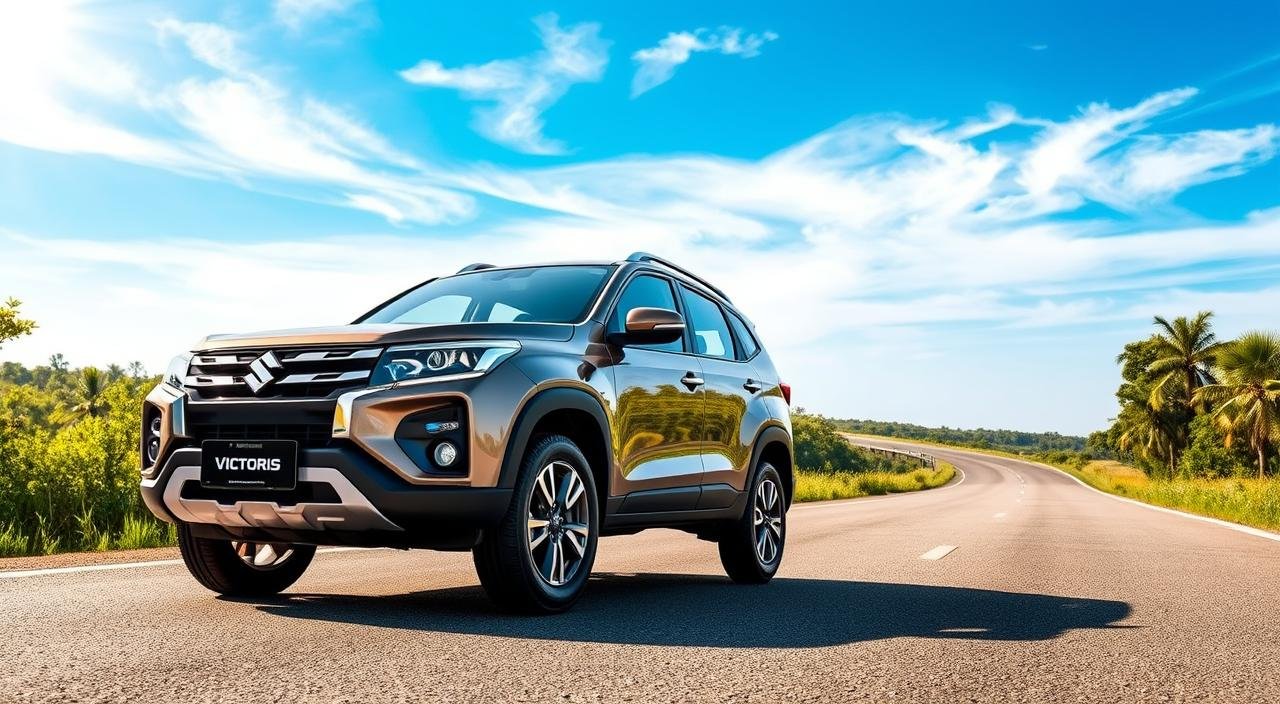
Oct
The Maruti Victoris is a big change in India’s compact SUV market. It’s affordable but doesn’t skimp on safety tech. It’s built on the Grand Vitara platform, making it a premium choice at a good price.
There are three engine choices for the Maruti Victoris. The base model has a 1.5-liter mild hybrid engine, making 103 PS and 139 Nm of torque. For those who want to save on fuel, there’s a CNG version. The top model is a strong hybrid, combining electric and petrol for 116 PS.
This SUV stands out for its safety in India. It got 5-star ratings from Global NCAP and Bharat NCAP. It has 210mm ground clearance and seats five, making it great for Indian roads. You can choose between front-wheel drive and all-wheel drive.
There are seven paint options, including Eternal Blue and Sizzling Red. Some models come in dual-tone colors for a unique look. The Maruti Victoris shows that you can get advanced features and safety without spending a lot in the compact SUV market.
Key Takeaways
- The Maruti Victoris offers three powertrain choices including mild hybrid, CNG, and strong hybrid options
- 5-star safety ratings from Global NCAP and Bharat NCAP establish class-leading protection
- 210mm ground clearance ensures capability on varied Indian road surfaces
- Seven color options with select dual-tone combinations provide personalization choices
- Available in both FWD and AWD configurations to match different driving needs
- Sold through Maruti Arena showrooms for widespread accessibility across India
Introduction to the Maruti Victoris
The Maruti Victoris is a big change in India’s compact SUV market. It offers advanced technology and safety at a low price. This car combines Maruti’s reliability with the latest ADAS features. It’s perfect for those who want modern features without spending a lot.
What is ADAS?
ADAS stands for Advanced Driver Assistance Systems. It’s a set of electronic safety features to prevent accidents and reduce stress while driving. The Victoris has Level 2 ADAS, with features like lane keep assist and adaptive cruise control.
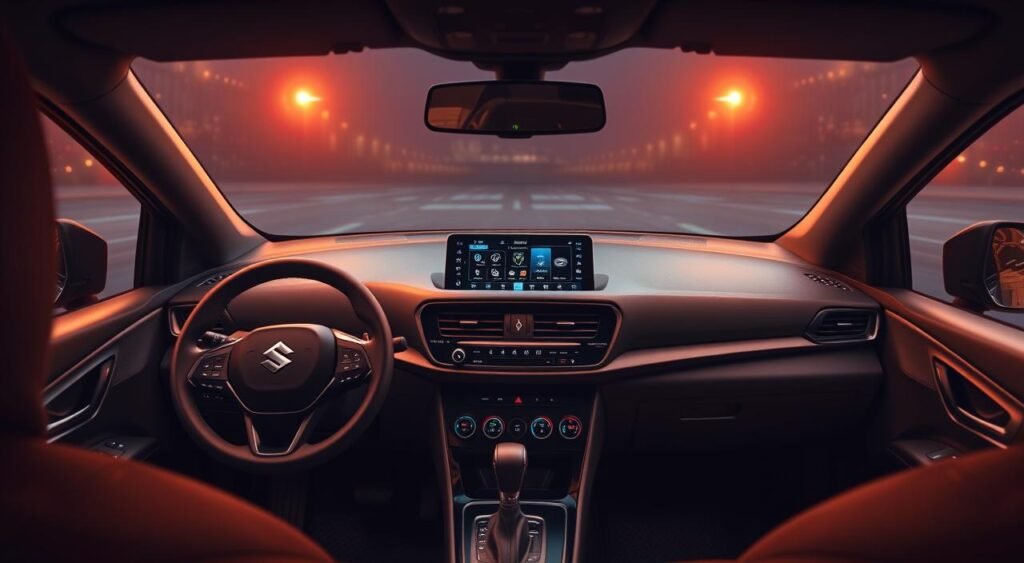
Level 2 ADAS lets the car control steering and speed in certain situations. But the driver must stay alert and ready to take over. This tech is only in the 6-speed automatic mild-hybrid petrol version of the Victoris.
Key Features of Maruti Victoris
The Victoris has many new features for Maruti:
- 10.1-inch touchscreen – India’s largest Maruti display with wireless Android Auto and Apple CarPlay
- 10.25-inch fully digital instrument cluster
- 8-speaker Infinity sound system with Dolby Atmos
- Panoramic sunroof and ventilated front seats
- 360-degree camera with blind view monitor
- Powered tailgate with gesture control
- Cooled wireless phone charger
These features make the Victoris a great choice for families. It offers modern tech without a high price tag.
Why Choose the Maruti Victoris?
The Maruti Victoris is a top choice in India’s SUV market. It offers great value proposition in all its models. From the Lxi to the Zxi+ with sunroof, there’s a trim for every budget. It combines premium tech and efficiency at a cost-effective price.
Excellent Value for Money
The Lxi model is packed with features that beat more expensive SUVs. It comes with six airbags, push-button start, and keyless entry. It also has automatic climate control and a 7-inch touchscreen for entertainment.
The tilt-telescopic steering wheel fits any driver. These high-end features are usually found in pricier SUVs. This makes the Victoris a great deal for those watching their budget.

Fuel Efficiency Comparison
The Victoris is known for its fuel economy. It has various powertrains for Indian roads. Its mileage depends on how you drive, but it’s top in its class.
| Variant Type | Certified Mileage | City Driving | Highway Driving |
|---|---|---|---|
| Mild Hybrid Manual | 21.18 kmpl | 12-13 kmpl | 17-18 kmpl |
| Mild Hybrid Automatic | 21.06 kmpl | 12-13 kmpl | 17-18 kmpl |
| CNG Variant | 27.02 km/kg | 22-23 km/kg | 25-26 km/kg |
| Strong Hybrid | 28.65 kmpl | 20+ kmpl | 24-25 kmpl |
The CNG option is best for those who drive a lot. It’s the cheapest to run but doesn’t sacrifice performance. The strong hybrid is great for city driving, thanks to its EV mode.
Advanced Driver Assistance Systems (ADAS)
The Maruti Victoris brings top-notch driver assistance tech to the affordable SUV market in India. Its ADAS features are a big step up for those on a budget. Now, advanced safety tech isn’t just for expensive cars.
Safety Features of ADAS
The Victoris has many safety systems to keep you safe. All models come with:
- Six airbags for full protection
- ABS with EBD for better braking
- Electronic Stability Program (ESP) and traction control
- Hill hold assist and rear parking sensors
- ISOFIX child seat anchors
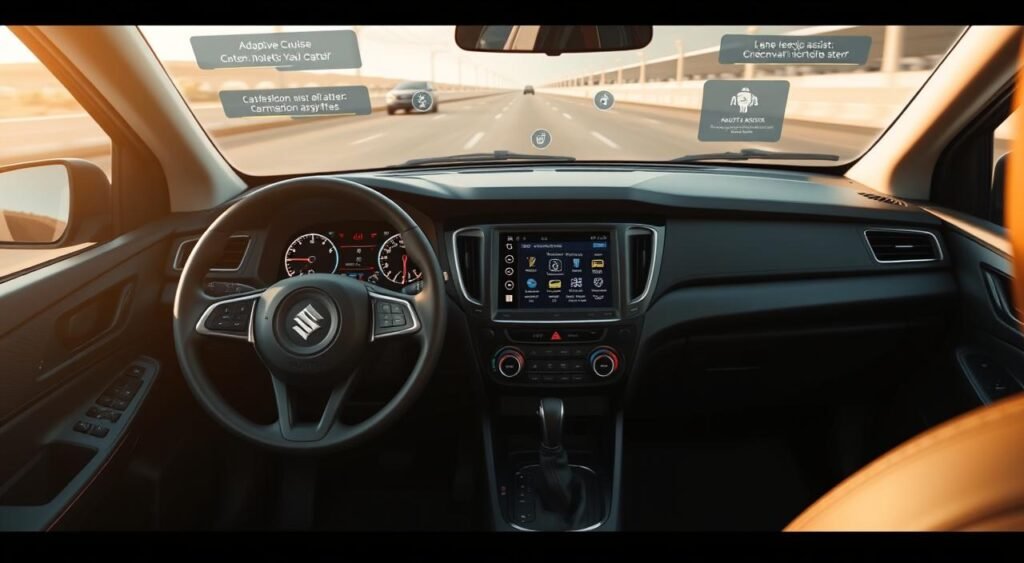
Top models add more safety tech. This includes a tire pressure monitor, front parking sensors, hill descent control, and a 360-degree camera. The Victoris got 5-star ratings from Bharat NCAP and Global NCAP. It’s one of the safest in its class.
How ADAS Enhances Driving Experience
Level 2 autonomous features make driving smarter. Lane keep assist stops you from drifting out of your lane. Autonomous emergency braking stops for you if it sees a crash coming.
High beam assist changes your headlights for better visibility. Adaptive cruise control keeps a safe distance without you pressing the gas. These features are only in the 6-speed automatic mild-hybrid model. This makes advanced safety tech affordable in India.
Design and Comfort of Maruti Victoris
The Maruti Victoris impresses with its interior design and exterior styling. It’s an affordable SUV in India that balances style and practicality. The cabin space is well-thought-out, making it feel like a premium vehicle at a lower price.
Interior Specifications
The Victoris has a dual-tone color scheme with black and off-white surfaces. It also has silver accents throughout. The seats, dashboard, and steering wheel are covered in leatherette.
The Strong Hybrid variants have an all-black interior with gold accents. This makes them stand out.

Front passengers get a lot of comfort, including an adjustable driver’s seat. The cabin has enough headroom for adults and features a sliding armrest. There’s also plenty of footwell space.
Rear passengers enjoy adjustable headrests and underthigh support. Three adults can fit comfortably, with good legroom. But, the panoramic sunroof reduces rear headroom slightly.
Exterior Styling and Aesthetics
The Victoris has modern styling with sharp lines and an upright front. The bonnet meets sleek lighting units, and the grille adds width. It comes with 17-inch alloy wheels, with dual-tone finishes on higher models.
The rear has connected LED tail lamps and a flat boot design. This creates a contemporary SUV look that catches the eye in traffic.
Performance and Handling
The Maruti Victoris offers strong engine performance in its lineup. It has three powertrain options for different driving styles and fuel needs. Each model strikes a balance between power and fuel efficiency, fitting well on Indian roads.
Engine Specifications
The Victoris comes with three engine types. The 1462cc mild hybrid petrol engine makes 102 bhp and 139 Nm torque. You can choose from a 5-speed manual or 6-speed automatic transmission.
The CNG version has the same 1462cc engine but makes 87 bhp and 121.5 Nm torque on CNG.
The 1490cc strong hybrid is special with its electric motor help. It combines a 91 bhp petrol engine with an electric motor for 116 PS total power and 141 Nm torque. It uses an eCVT transmission for smooth power.
An AWD system is only available with automatic transmission models.
Driving Dynamics and Comfort
Driving in the city is lively with the mild hybrid’s linear power. The strong hybrid offers quick torque from its electric motor, making city driving smooth. On highways, it cruises well, but the mild hybrid needs downshifts for quick passing.
The ride quality is soft over bumps and rough spots. It handles corners well, showing confident handling. The suspension does a good job of absorbing road bumps. Some tire and road noise is present at high speeds, but it’s not too bad for this class.
Technology Integration
The Maruti Victoris is a top choice for affordable SUVs, thanks to its advanced technology. It offers a range of smart features that match those found in more expensive cars. The car’s infotainment and connectivity options make driving more enjoyable without being too complicated.
Infotainment Systems
The Victoris comes with a 10.1-inch touchscreen that runs Maruti’s latest software. It works fast and supports wireless Android Auto and Apple CarPlay. This means you can connect your phone without cables, keeping your car tidy.
The car’s sound system is also impressive. It has an 8-speaker Infinity setup with Dolby Atmos surround sound. This turns the car into a mini concert hall. The digital driver’s display shows two layouts, and a head-up display shows important info on the windshield.
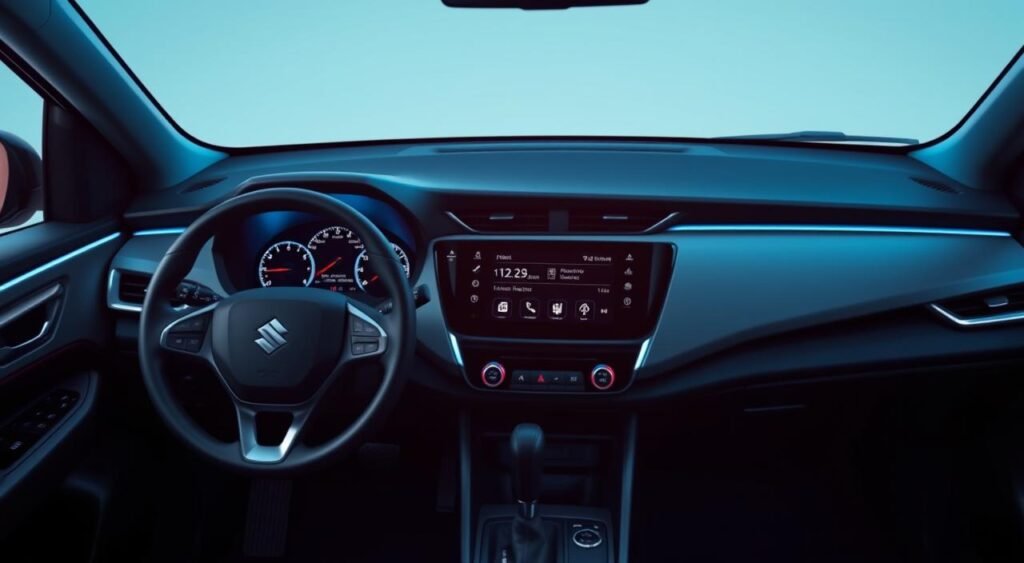
Connectivity Features
The Victoris also has smart features for staying connected. It has a cooled wireless phone charger to keep your phone’s battery cool. There are two USB Type-C ports for everyone to charge their devices. The car also has 12V sockets in the cabin and boot for extra power.
It has voice assistant integration and automatic climate control. There’s also a PM 2.5 air filter for cleaner air. Higher trims come with electric ORVMs and an electronic parking brake.
Comparison with Competitors
The Maruti Victoris enters a competitive market filled with established segment rivals. This competitor comparison looks at how the Victoris compares to other popular top SUVs in India. We focus on key factors like price, fuel efficiency, features, and value.
Maruti Victoris vs. Honda HR-V
The Honda HR-V is a strong market alternative to the Victoris. Both aim to please budget-conscious buyers with practical SUVs and modern features. The Victoris stands out with its exceptional fuel efficiency, reaching 28.65 kmpl with a hybrid system. The HR-V, on the other hand, has a conventional petrol engine that gets around 16 kmpl.
The Victoris is priced lower, starting about ₹2 lakhs below the HR-V’s base model. The Honda offers diesel and turbo-petrol engines for more power options. Buyers have different design preferences, with the HR-V being sportier and the Victoris more practical.
Maruti Victoris vs. Tata Nexon
The Tata Nexon is priced to compete but lacks in some areas. The Victoris has better fuel economy and a more refined cabin with premium materials. It also scores higher in safety, with a 5-star rating and a full ADAS suite.
| Feature | Maruti Victoris | Tata Nexon | Honda HR-V |
|---|---|---|---|
| Starting Price | ₹10.5 lakhs | ₹8.1 lakhs | ₹12.5 lakhs |
| Fuel Economy | 28.65 kmpl | 17.5 kmpl | 16 kmpl |
| ADAS Features | Comprehensive | Basic | Standard |
| Engine Options | Petrol, Hybrid | Petrol, Diesel | Petrol, Turbo |
Customer Feedback and Reviews
The Maruti Victoris has made a big splash in India’s compact SUV market. Automotive journalists and early users have shared their thoughts. They say it’s great for daily driving but has some trade-offs due to its price.
Positive Reviews Overview
Customer reviews often talk about the Victoris’s ride quality. Owners love how comfortable it is on India’s rough roads. They also mention it handles corners well.
The hybrid version gets lots of praise for its fuel efficiency. It helps save money on fuel costs.
CarDekho’s experts say the Victoris has a lot of features. Expert opinions highlight ventilated seats, panoramic sunroof, and a gesture-controlled tailgate. These are rare at this price.
It also has top safety ratings, making it great for families.
Critiques and Areas for Improvement
Owner experiences show some areas that need work. Taller people find the sunroof cuts down on headroom, making long trips uncomfortable. Road noise is also a problem at high speeds.
- Interior plastics feel budget-oriented on door panels
- Climate control buttons lack premium tactile feedback
- Ventilation system produces noticeable noise at maximum setting
- Boot space compromised by raised floor in hybrid variant
- ADAS features missing from the strong hybrid model
Not having a diesel engine is a letdown for some. They miss the extra torque and efficiency. Yet, most agree the Victoris offers great value without major drawbacks.
Pricing and Availability
The Maruti Victoris is a top choice in the Indian SUV market. It has a price that fits many budgets. Knowing the cost analysis helps buyers decide if it’s right for them. Maruti aims to make safety tech affordable for more people.
Cost Analysis of the Maruti Victoris
The Victoris comes in many variants to meet different needs. The Lxi starts at Rs. 10.50 Lakh, great for those watching their budget. The Zxi Plus (O) eCVT variant goes up to Rs. 19.99 Lakh, with top features and tech.
CNG models offer great fuel savings, priced from Rs. 11.50 Lakh to Rs. 14.72 Lakh for the Zxi dual-tone. Hybrid tech starts at Rs. 16.38 Lakh for the Vxi. The AWD system is only in Zxi Plus automatics, priced from Rs. 18.64 Lakh to Rs. 19.37 Lakh. Adding dual-tone paint costs Rs. 15,000 extra.
Where to Buy in the U.S.
The Maruti Suzuki Arena dealership network is wide across India. You can book online at www.marutisuzuki.com, using many payment methods. Each booking gets a unique number for tracking. Cancellations within 90 days get refunds in 25-30 days.
Dealerships give specific delivery times based on stock. This makes buying easy and convenient.
Conclusion: Is the Maruti Victoris Worth It?
The Maruti Victoris is a great choice for Indian car buyers. It has advanced safety features, various engine options, and good prices. Its 5-star safety rating and ADAS technology make it stand out.
Each version of the Victoris has its own perks. The mild hybrid model is both powerful and fuel-efficient. The CNG option saves money on gas, and the strong hybrid gets up to 28.65 kmpl.
Final Thoughts on Affordability and Features
The Victoris offers features usually found in pricier cars. CarDekho says the Zxi variant is the best for style and features. The Lxi trim is affordable and has the basics.
The Zxi+ is for those who want luxury features like AWD. Maruti’s wide service network in India adds to its value.
Recommendations for Future Buyers
This SUV is great for families who want comfort, good fuel economy, and reliability. It’s recommended for those who value safety and features over speed.
It’s perfect for first-time SUV buyers or those upgrading from older cars. But, if you want diesel power or a sunroof, you might need to look elsewhere. The Victoris is a smart choice for Indian families looking for value.
FAQ
What are the price ranges for the Maruti Victoris in India?
The Maruti Victoris starts at Rs. 10.50 Lakh for the base Lxi. The top Zxi Plus (O) eCVT variant costs up to Rs. 19.99 Lakh. CNG models range from Rs. 11.50 Lakh to Rs. 14.72 Lakh. Hybrid models start at Rs. 16.38 Lakh. AWD models, with automatic transmission, cost between Rs. 18.64-19.37 Lakh.
Which variants of the Maruti Victoris come with ADAS features?
The 6-speed automatic mild-hybrid petrol variant has Level 2 ADAS features. Unfortunately, the strong-hybrid variant, despite being pricier, doesn’t have this technology. The ADAS package includes lane keep assist, autonomous emergency braking, high beam assist, and adaptive cruise control.
What fuel efficiency can buyers expect from different Maruti Victoris variants?
The Maruti Victoris offers great fuel efficiency. The mild hybrid petrol gets 21.18 kmpl (manual) and 21.06 kmpl (automatic). The CNG variant gets 27.02 km/kg. The strong hybrid gets 28.65 kmpl.
In real-world city driving, the mild hybrid gets 12-13 kmpl. The strong hybrid gets over 20 kmpl in EV mode.
How safe is the Maruti Victoris compared to other compact SUVs in India?
The Maruti Victoris has 5-star safety ratings from Global NCAP and Bharat NCAP. It’s among the safest in its segment. It comes with 6 airbags, ABS with EBD, ESP, traction control, and ISOFIX child seat anchors on all variants.
What are the key technology features in the Maruti Victoris?
The SUV has India’s largest Maruti touchscreen at 10.1 inches. It supports wireless Android Auto and Apple CarPlay. It also has a 10.25-inch digital instrument cluster and an 8-speaker Infinity sound system with Dolby Atmos.
Other features include a panoramic sunroof, ventilated front seats, and a cooled wireless phone charger. It also has a powered tailgate with gesture control and a 360-degree camera with blind view monitor.
How does the Maruti Victoris compare to top SUVs in India like the Hyundai Creta and Kia Seltos?
The Victoris has better fuel efficiency, with its strong hybrid variant getting 28.65 kmpl. The Hyundai Creta and Kia Seltos offer diesel and turbo-petrol options not found in the Victoris. But the Maruti offers better value, 5-star safety ratings, and extensive ADAS features at competitive prices.
The Creta’s N-Line variant offers sportier dynamics. The Seltos has sharper styling but higher fuel consumption.
What are the main engine options available in the Maruti Victoris?
The Victoris has three engine options. A 1.5-litre mild hybrid petrol makes 103 PS and 139 Nm torque. A CNG variant delivers 87.8 PS in CNG mode and 100 PS in petrol mode. A 1.5-litre strong hybrid petrol generates 116 PS combined power with eCVT transmission.
Both FWD and AWD configurations are available.
Is the Maruti Victoris available as an affordable SUV outside India?
The Maruti Victoris is only available in India through Maruti Suzuki Arena dealerships. It’s designed for Indian road conditions and consumer preferences. There are no plans for international markets, including the United States.
What are the most common criticisms of the Maruti Victoris according to expert reviews?
Expert reviews mention limited headroom with the panoramic sunroof and average cabin insulation. They also point out plasticky door and climate control buttons, no diesel engine option, and ADAS unavailability on the expensive strong hybrid variant.
Boot space limitations with raised floor in hybrid variants are also concerns. But reviewers praise its features, fuel efficiency, and safety ratings.
Which Maruti Victoris variant offers the best value for money?
CarDekho experts say the Zxi variant offers the best value. It combines styling and features at a reasonable price. The base Lxi is good for budget buyers with essential features.
The Zxi+ is recommended for those wanting premium features like ventilated seats or AWD capability.

Oct
Can October 2025 become the most exciting month for car enthusiasts in India with over 68 new models set to hit the market?
The Indian automotive market is set for a big change this October. Car launch updates show a wide range of vehicles coming just in time for the festive season. This is perfect timing, as buyers look for new options with GST-based price adjustments.
October 2025 new car releases show the industry’s wide range. The month will see 50 SUVs, 9 sedans, 4 hatchbacks, 2 coupes, 1 pickup truck, 1 MUV, and 1 luxury vehicle. This variety shows manufacturers’ dedication to meeting all drivers’ needs.
Premium brands are leading with exciting launches. BMW will unveil the iX 2025 at Rs. 1.45 Crore on October 14. Mahindra will introduce the Bolero Neo at Rs. 11.40 Lakh on October 15. Audi will launch the Q6 e-tron at Rs. 1 Crore on the same day. Skoda will unveil the Octavia RS at Rs. 45 Lakh on October 17.
These upcoming car launches in India highlight a move towards electric and hybrid technology. The market is showing strong interest in eco-friendly mobility solutions. Buyers now have more choices than ever in every segment and price range.
Key Takeaways
- 68 new vehicles scheduled for launch in India during October 2025
- SUVs dominate the lineup with 50 models across various price segments
- BMW iX 2025 arrives October 14 at Rs. 1.45 Crore for luxury buyers
- Mahindra Bolero Neo launches October 15 at Rs. 11.40 Lakh
- Audi Q6 e-tron debuts October 15 with advanced electric technology
- Festive season timing creates ideal buying conditions with GST benefits
Overview of October 2025 Car Launches
October 2025 is set to bring a thrilling lineup of cars to India’s roads. This month is a big deal for car shoppers, with 16 new models hitting the market in just three months. These latest cars show how tastes and tech are changing in the car world.
Key Trends in the Automotive Industry
The car world is changing fast this season. New GST rates have led to price cuts in showrooms. This shows how car makers are adjusting to tax changes while keeping prices fair.
October will see three big car launches:
- Mini Countryman JCW ALL4 – October 14
- Skoda Octavia RS – October 17
- Citroen Aircross X – Late October
Significance of October Launches
The festive season in October gets people excited about buying cars. With special deals and discounts, these cars are even more appealing. Sales data shows a 35% jump in bookings in October compared to other months.
Car makers plan their launches to coincide with festivals. They know that many Indians see buying a car as lucky during these times. With new models, lower prices, and festive deals, it’s a great time for both new and seasoned car buyers.
Major Brands Launching New Models
October 2025 is packed with car debut news India has been eagerly waiting for. Big names in the auto world are ready to show off their latest models. These new cars will have cool features and prices that will attract many buyers.
Hyundai’s Latest Offerings
Hyundai is leading the charge with the Venue 2025 facelift, priced at Rs. 8 Lakh. It’s set to hit the market on November 5. This updated Venue boasts a new look and advanced tech, perfect for city dwellers.
Hyundai also has the Palisade SUV and the sleek IONIQ 6 coupe in the works. These models aim to capture the high-end market in India.
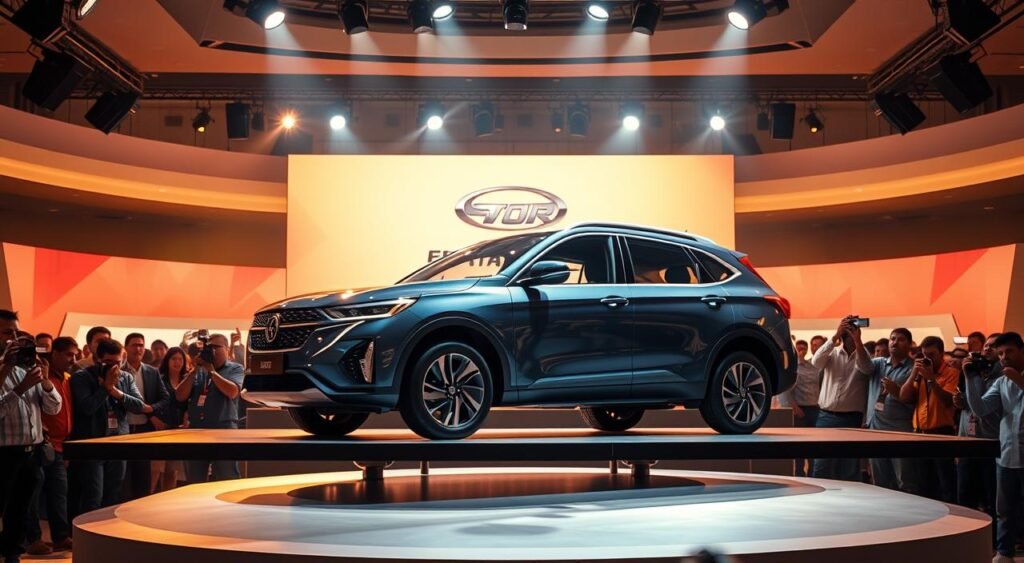
Toyota’s New Innovations
Toyota is set to boost its SUV lineup with a new three-row vehicle. It will cost Rs. 14 Lakh and is expected to arrive in January 2026. This move is a response to the growing need for roomy family cars in India.
The Japanese brand is all about reliability and affordability. It wants to make top-notch features available to more people, not just the wealthy.
Mahindra’s Exciting Updates
Mahindra is making waves in October with updates to its popular models. The Thar three-door and the Bolero siblings are getting major makeovers. These changes show Mahindra’s dedication to keeping its bestsellers in the game.
| Model | Key Updates | Interior Features |
|---|---|---|
| Thar Three-Door | New grille, dual-tone bumpers | Front armrest, cup holders, reverse parking camera |
| Bolero Refresh | Updated grille, air dam, alloy wheels | Black/brown theme, fabric upholstery, 10.25-inch touchscreen |
Electric Vehicles Set to Debut
The electric vehicle segment is growing fast in India this month. Two top German brands are introducing their latest electric cars. These cars mark a big change in India’s car market, as people want cleaner ways to travel.
Popular EVs Launching This Month
BMW’s updated iX electric SUV hits the market on October 14, starting at Rs. 1.45 crore. It has better batteries and new interior features. Audi’s Q6 e-tron comes out on October 15, priced at Rs. 1 crore. Both cars aim to offer luxury and zero emissions.
More exciting EVs are coming in late 2025 and early 2026. Maruti’s e Vitara will debut in December at Rs. 17-22.50 lakh. Mercedes-Benz’s CLA Electric will cost Rs. 65 lakh. Leapmotor’s T03 will be the most affordable at just Rs. 8 lakh.
Benefits of Electric Cars
- Zero tailpipe emissions reduce air pollution
- Lower running costs compared to petrol vehicles
- Quieter operation enhances driving comfort
- Instant torque delivery provides smooth acceleration
- Reduced maintenance requirements save money long-term
Charging Infrastructure in India
India’s EV charging network is growing fast, with over 12,000 public stations. Most are in Delhi, Mumbai, and Bangalore. Fast-charging can fill up to 80% of a battery in just 30 minutes.
SUVs Making a Splash in October
October 2025 is exciting for SUV fans in India. Three new SUVs will hit the market, each with special features. They offer top-notch engineering, comfort, and good prices to appeal to many buyers.
Best SUVs to Watch For
The Mini Countryman JCW ALL4 is first to arrive on October 14. It packs a 300-horsepower engine and goes from 0 to 100 km/h in 5.4 seconds. Its 7-speed transmission and all-wheel drive make it fast and agile.
Citroen’s Aircross X is already taking bookings, starting September 16. The Nissan C-SUV will debut on October 7. It’s a new model that will compete with big names like the Maruti Grand Vitara and Hyundai Creta.
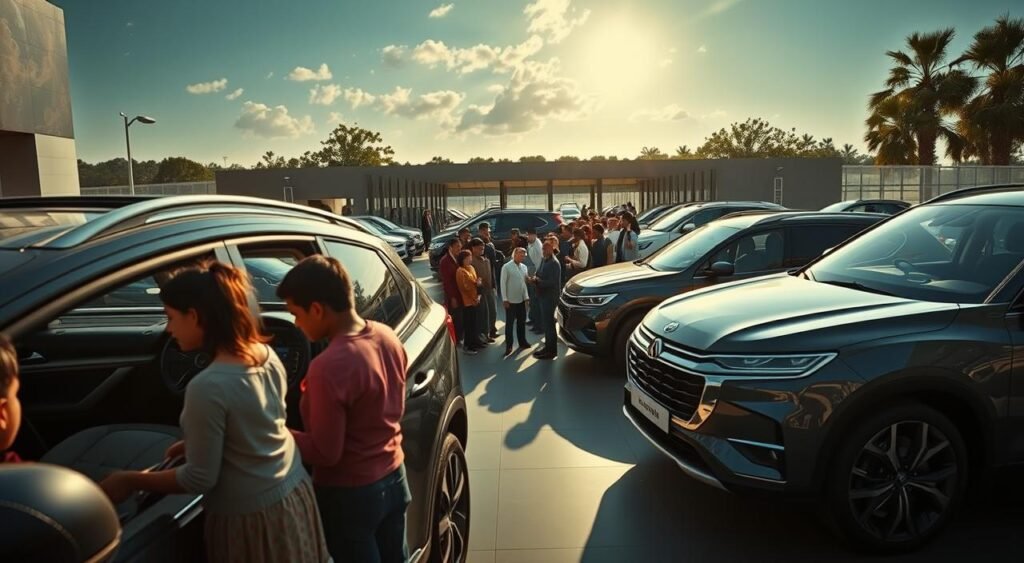
Features of Upcoming SUV Models
The latest SUVs bring cool tech and luxury features. The Citroen Aircross X stands out with:
- New green paint option with all-LED lighting system
- Ventilated front seats with fresh upholstery design
- Cara AI voice assistant for hands-free control
- 360-degree camera system for enhanced visibility
Pricing and Availability
| Model | Launch Date | Expected Price Range | Key Competitors |
|---|---|---|---|
| Mini Countryman JCW ALL4 | October 14 | ₹45-50 lakhs | BMW X1, Mercedes GLA |
| Citroen Aircross X | Mid-October | ₹12-18 lakhs | Hyundai Creta, Kia Seltos |
| Nissan C-SUV | October 7 | ₹11-16 lakhs | Maruti Grand Vitara, Honda Elevate |
Compact Cars Hitting the Market
The compact car segment is getting a fresh boost with new models. These cars are designed for city living and first-time buyers. They come with the latest tech, better fuel efficiency, and stylish looks at good prices.
Overview of New Compact Models
India is set to see a wave of new compact cars. Nissan is working on a new Terrano, and Volkswagen’s Tera will start at Rs. 8 Lakh in January 2026. These cars promise a lot for their price.
Electric cars are also making a big splash. The Maruti WagonR Electric will cost around Rs. 8.50 Lakh. Leapmotor’s T03 is another affordable EV at Rs. 8 Lakh. The MG 4 EV and the updated Maruti Baleno 2026 are also on the horizon.
Design Changes and Improvements
Recent updates show a big leap in compact car design. The Tata Punch 2025 facelift starts at Rs. 6 Lakh. Cars now have more room inside and sleek looks outside. LED lights, aerodynamic shapes, and bold grilles are the new trends.
Target Audience for Compact Cars
These cars are perfect for young professionals, small families, and those who care about the environment. They’re affordable and easy to maintain. City folks love them for being easy to park and drive in tight spaces.
Sedans to Look Out For
The sedan segment is drawing in buyers who want comfort and performance. In October 2025, several car makers will unveil special editions and performance models. These cars will mix classic sedan style with the latest tech. The Indian market will see a mix of luxury and sports sedans this quarter.
Notable Sedan Launches
Skoda is leading with the Octavia RS on October 17. This sedan packs 265 horsepower from a 2.0-liter turbo-petrol engine. It comes with a 7-speed DSG automatic transmission. Only 100 units will be available for India, and pre-bookings start on October 6.
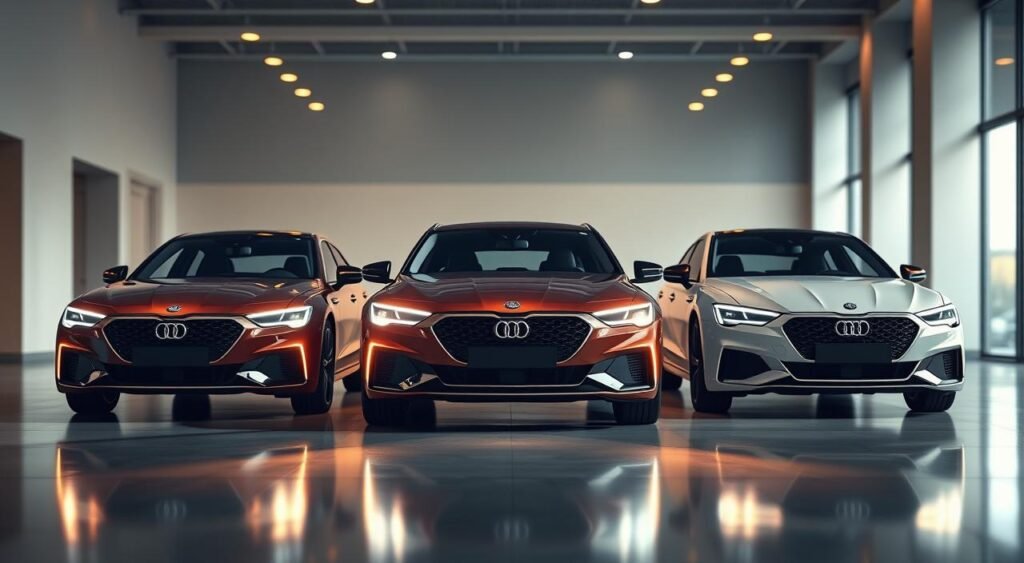
Audi will introduce the A5 sedan on December 15 at Rs. 50 Lakh. Skoda will launch the new Superb on December 13 at the same price. Nine sedans are set to be released by 2026.
Key Specifications and Features
The Octavia RS impresses with its performance:
- 0-100 kph in 6.4 seconds
- Top speed of 250 kph
- Front-wheel drive
- Advanced safety systems
Market Positioning
These sedans aim at car lovers and premium buyers. The Octavia RS celebrates Skoda’s 25 years in India. The Audi A5 and Skoda Superb compete in the executive segment. They offer advanced features and a smooth drive at good prices.
Luxury Cars Arriving in October
October 2025 is set to bring a thrilling lineup of premium vehicles. These cars showcase the latest in electric technology and fine craftsmanship. They blend sleek designs with top-notch features, appealing to those who value exclusivity and performance.
High-End Models Coming Soon
The BMW iX 2025 electric luxury SUV hits the market on October 14, starting at Rs. 1.45 crore. It highlights BMW’s dedication to electric cars while maintaining luxury. The Audi Q6 e-tron arrives on October 15, priced at Rs. 1 crore, bringing German engineering to the electric SUV scene.
Mini fans will be excited about the Countryman JCW ALL4 launch. This car packs 300 horsepower, marking a new entry in the compact luxury segment. Bookings opened on September 22 at 11 dealerships across the country.
Technology and Comfort Features
These luxury cars are packed with cutting-edge tech. The BMW iX boasts a curved display and the latest iDrive system. The Audi Q6 e-tron features virtual cockpit tech and premium sound systems. Both offer advanced driver assistance and connected car features for safety and convenience.
Brand Experiences and Test Drives
Luxury brands are setting up special experiences for buyers. BMW and Audi offer personalized test drives at their centers. Mini combines virtual reality tours with traditional visits, giving customers various ways to explore these new cars.
Performance Cars to Get Excited About
October 2025 is here, and car fans in India are buzzing with excitement. This month, we see cars that are all about speed, power, and new tech. From sleek European sports sedans to stunning Italian supercars, the lineup is packed with amazing new models.
Upcoming Sports Models
The Skoda Octavia RS is a standout with its 261 horsepower engine. It’s a performance sedan with a seven-speed automatic, making it fast and smooth. Mini also brings the Countryman JCW ALL4, a small but mighty car with 300 horsepower and 400 Newton-meters of torque.
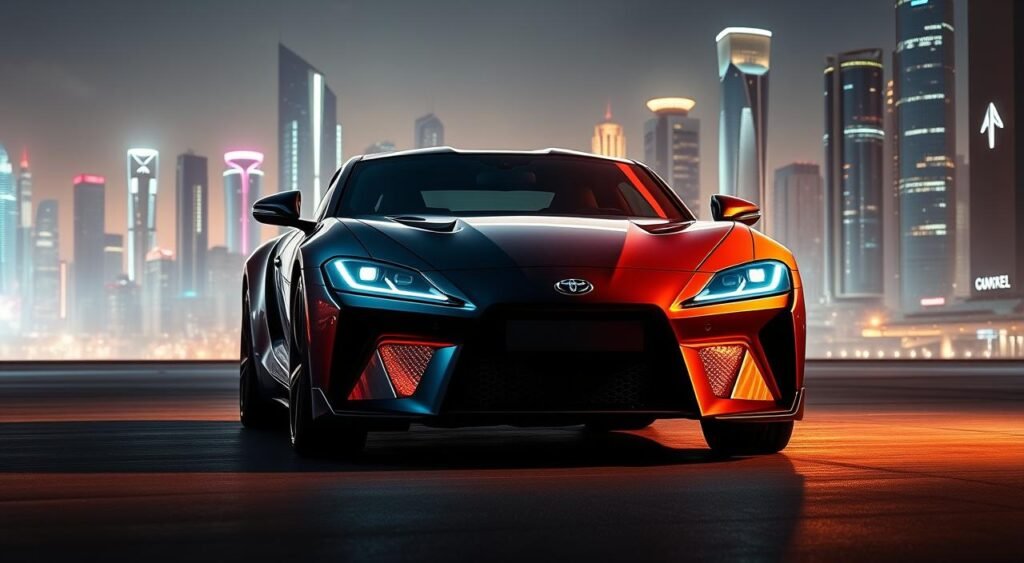
Ferrari introduces the 12Cilindri coupe, showing off Italian design and engineering. Only 100 Skoda Octavia RS units will be available in India, making them rare and special.
Innovations in Performance Technology
These new cars come with advanced tech, like dual-clutch transmissions and smart all-wheel-drive. The Mini Countryman’s seven-speed dual-clutch system makes quick shifts. Its traction management helps keep the car stable during fast driving.
Pricing and Expectations
Get ready for high prices, starting at Rs. 45 Lakh for the sports models. The luxury segment is even pricier, showing the value of top-notch engineering and unique features.
Hybrid Vehicles Launching This Month
The Indian car market is changing in October 2025. Now, more cars are using electric power. But, car makers are also getting ready to launch hybrid models soon. This change shows more people in India want cars that are good for the planet and save fuel.
Benefits of Hybrid Cars
Hybrid cars are great for Indian drivers. They mix a gasoline engine with an electric motor. This combo gives exceptional fuel economy and gets rid of worries about running out of charge.
They also save money on gas. Plus, they don’t need to find charging spots on long trips. The car’s regenerative braking system captures energy when you slow down. This energy helps charge the battery.
Highlighted Hybrid Models
The Hyundai IONIQ 6 is a top pick in the electrified coupe segment. It shows off the latest in hybrid tech with great performance. Toyota is also adding new hybrid versions of the Camry and Corolla for 2026.
Maruti Suzuki is working on hybrid versions of the Baleno and Swift. These will be more affordable, making hybrid cars available to more people in India.
Environmental Impact
Hybrid cars cut down on carbon emissions a lot. They are 25-35% cleaner than regular cars but are just as easy to refuel. The Indian car market is moving towards cleaner cars with stricter rules on emissions.
Anticipated Tech Features in New Models
The October 2025 new car releases bring cutting-edge technology. This technology changes how we drive. From advanced safety systems to smart connectivity features, these vehicles show the industry’s commitment to innovation. Let’s look at the exciting tech upgrades coming this month.
Latest Technology Trends
The latest cars launching in India have impressive tech. The Mahindra Thar facelift has LED headlights featuring C-shaped DRLs and a new 3-spoke steering wheel. It also has a 10.25-inch infotainment touchscreen for better visibility and easier use.
The Citroen Aircross X takes connectivity further with its Cara AI voice assistant. This allows drivers to control functions without their hands.
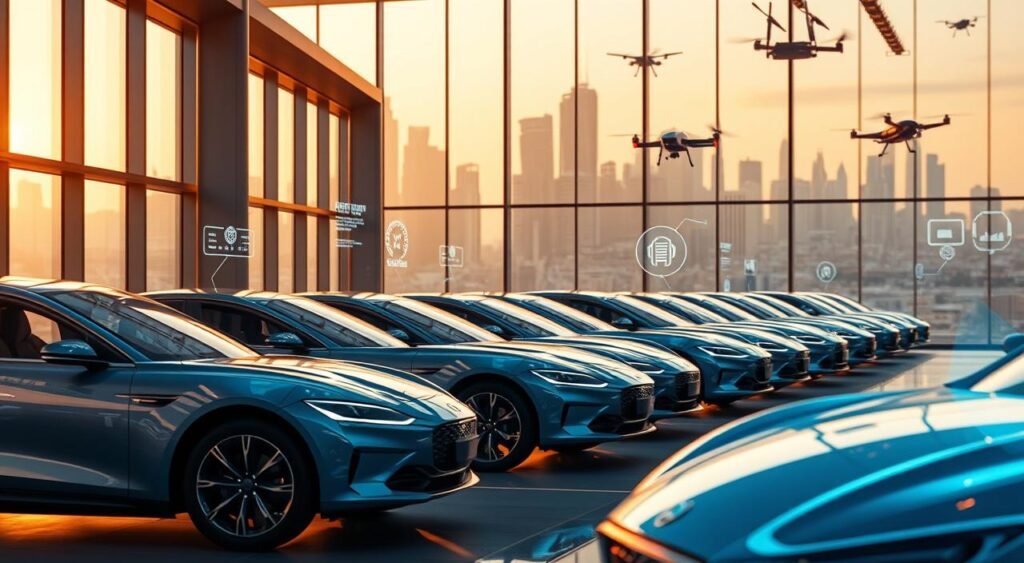
Safety Features to Expect
Safety is a big focus in the October 2025 new car releases. The Citroen Aircross X has a 360-degree camera system to remove blind spots. Reverse parking cameras are now standard in many models.
There are also new connectivity options. These enable real-time tracking and emergency response systems.
In-Car Entertainment Updates
Entertainment systems get big upgrades in the latest cars. The Mahindra Bolero Neo has a new 10.25-inch touchscreen with better resolution and speed. The Mini Countryman JCW ALL4 combines performance tech with DCT transmission for a fun drive.
These systems support wireless smartphone connectivity and multiple streaming platforms.
| Model | Screen Size | Special Features |
|---|---|---|
| Mahindra Thar | 10.25 inches | LED headlights, C-shaped DRLs |
| Citroen Aircross X | Standard | Cara AI assistant, 360° camera |
| Mahindra Bolero Neo | 10.25 inches | Enhanced connectivity |
Special Editions and Collaborations
October 2025 is packed with special editions and partnerships that make car launches in India exciting. Automakers are celebrating big milestones and creating unique models for collectors and car lovers. These exclusive cars offer something special beyond the usual models.
Unique Models Being Released
Skoda is celebrating 25 years in India with the Octavia RS. This special edition is limited to just 100 units. It has sport-tuned suspension, bold styling, and a premium interior, making it truly special.
Citroen is introducing the ‘X’ derivative strategy with three models. The C3 X, Basalt X, and Aircross X offer more features at good prices. They come with better infotainment, premium seats, and extra safety features, all without breaking the bank.
Brand Collaborations
Nissan and Renault are teaming up with the new C-SUV on the Renault Duster architecture. This partnership cuts costs and lets customers choose from different styles and features across both brands.
Limited-Time Offers
The festive season brings great deals on these car updates. Mini is making the Countryman JCW ALL4 available in just 11 dealerships across India. It’s a rare find for car enthusiasts.
| Model | Units Available | Special Features |
|---|---|---|
| Skoda Octavia RS | 100 | Sport suspension, RS badges |
| Mini Countryman JCW | Limited allocation | ALL4 system, JCW tuning |
| Citroen X variants | Regular production | Enhanced features, competitive pricing |
Conclusion: What to Expect from October 2025
October 2025 is a big deal for car news in India. There’s a wide range of cars, from affordable to luxury electric vehicles. This shows the industry’s focus on variety and innovation in the Indian market.
Final Thoughts on Upcoming Launches
October will see exciting new models from top brands. BMW is launching the iX 2025 in the luxury electric segment. Mahindra is updating the Bolero Neo for those on a budget.
Audi is entering the premium EV market with the Q6 e-tron. Skoda is targeting performance lovers with the Octavia RS. Mini is adding fun with the Countryman JCW ALL4. This is great news for the festive season in India.
How to Stay Updated on New Cars
Want to know about these new cars? Check manufacturer websites and dealer networks. You can also pre-book online without going to the showroom.
November will see more new cars, like the Hyundai Venue 2025 and Tata Sierra. With 68 new cars coming in 2025 and 2026, keep up with official news to not miss out.
Inviting Reader Engagement and Feedback
What do you think about these new cars? Share your thoughts. Your opinions help us understand what people want and what’s trending.
Join car forums and social media groups to talk about cars. Your feedback helps shape future car news in India. It also helps manufacturers know what customers want.
FAQ
What are the confirmed car launches in India for October 2025?
In October 2025, several cars will hit the market. The BMW iX 2025 will cost Rs. 1.45 Crore on October 14. The Mahindra Bolero Neo will start at Rs. 11.40 Lakh on October 15. The Audi Q6 e-tron will be priced at Rs. 1 Crore on the same day.
The Mini Countryman JCW ALL4 will launch on October 14. The Skoda Octavia RS will cost Rs. 45 Lakh on October 17. The Citroen Aircross X will arrive in October.
How many new car models are expected to launch in India during 2025-2026?
India expects 68 new cars from 2025 to 2026. This includes 50 SUVs, 9 sedans, and 4 hatchbacks. There will also be 2 coupes, 1 pickup truck, 1 MUV, and 1 luxury vehicle.
In the next three months, 16 cars will hit the market.
What electric vehicles are launching soon in the Indian car market?
Several electric cars are coming soon. The BMW iX 2025 will launch on October 14. The Audi Q6 e-tron will debut on October 15.
The Maruti e Vitara will start at Rs. 17-22.50 Lakh in December. The Mercedes-Benz CLA Electric will cost Rs. 65 Lakh. The MG 4 EV hatchback will be priced at Rs. 30 Lakh.
The Leapmotor C10 will cost Rs. 45 Lakh, and the T03 will start at Rs. 8 Lakh. The Tesla Model 3 will arrive in January 2026 at Rs. 60 Lakh.
What are the specifications of the Skoda Octavia RS launching in October?
The Skoda Octavia RS has a 265hp engine. It goes from 0-100kph in 6.4 seconds. The top speed is 250kph.
Only 100 units will come to India at Rs. 45 Lakh. Pre-bookings start on October 6. Deliveries will begin on November 6.
What are the latest cars launching in India with performance-focused features?
The Mini Countryman JCW ALL4 has a 300hp engine. It accelerates to 100kph in 5.4 seconds. The Skoda Octavia RS has 265hp and sporty dynamics.
The Ferrari 12Cilindri coupe is a top performance car.
Which upcoming car models are targeting budget-conscious buyers?
For those on a budget, the Tata Punch 2025 facelift will cost Rs. 6 Lakh in January 2026. The Volkswagen Tera will start at Rs. 8 Lakh in January 2026.
The Maruti WagonR Electric will be priced at Rs. 8.50 Lakh. The Leapmotor T03 will cost Rs. 8 Lakh. The Hyundai Venue 2025 facelift will launch on November 5 at Rs. 8 Lakh.
What technology features are included in the October 2025 new car releases?
The Mahindra Thar facelift will have LED headlights and a 10.25-inch screen. The Citroen Aircross X will feature Cara AI and a 360-degree camera. The Mahindra Bolero Neo will have a 10.25-inch touchscreen.
The Mini Countryman JCW ALL4 will have advanced transmission and all-wheel drive.
How has the GST revision affected car launch updates and pricing?
The GST revision has led to lower prices for cars. This has made the market more positive. The festive season and these price cuts are boosting sales.
What is the Nissan C-SUV car debut news, and when will it launch?
The Nissan C-SUV will debut on October 7. It’s the spiritual successor to the Terrano. It will compete with popular SUVs like the Maruti Grand Vitara and Kia Seltos.
The C-SUV will launch in early 2026. It has already been spotted testing in India.
Which luxury and premium upcoming car models are unveiling this October?
This October, luxury cars include the BMW iX 2025 at Rs. 1.45 Crore. The Audi Q6 e-tron will cost Rs. 1 Crore. The Mini Countryman JCW ALL4 is available for booking.
The MG Majestor premium SUV will launch on November 18 at Rs. 46 Lakh.
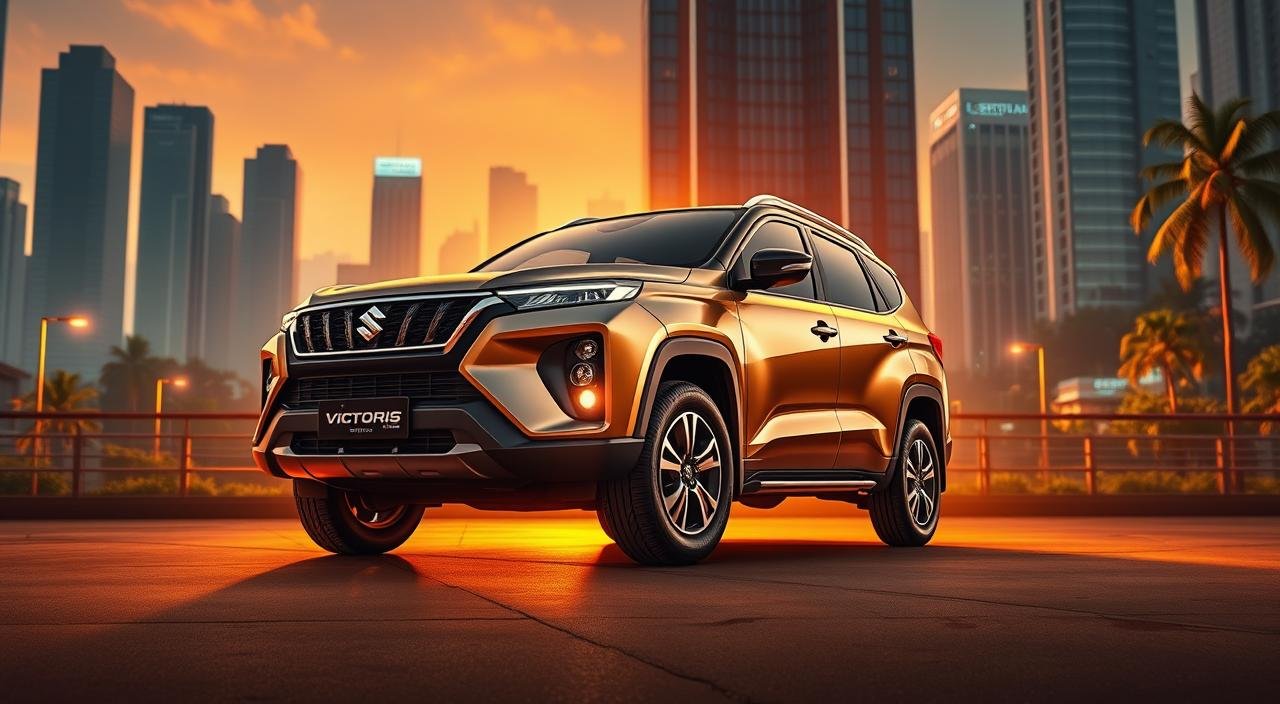
Oct
Can a new SUV priced lower than its sibling deliver more value? The Maruti Suzuki Victoris SUV aims to shake up the Indian compact SUV market. It promises to do so with a bold approach.
The flagship Arena SUV starts at Rs. 10.50 lakh for petrol variants. CNG models cost Rs. 11.50 lakh, and strong hybrid versions are Rs. 16.37 lakh. It’s built on the same platform as the Grand Vitara. This makes it more premium but cheaper than its Nexa counterpart.
The Victoris challenges top players like Hyundai Creta and Kia Seltos. It also faces off against Skoda Kushaq, Volkswagen Taigun, MG Astor, and Honda Elevate. It’s positioned above the Brezza in the Arena lineup, making it a bridge between sub-four-meter SUVs and the Nexa-exclusive Grand Vitara.
Safety is a key focus with 5-star ratings from BNCAP and GNCAP crash tests. This SUV introduces Level 2 ADAS technology for Maruti. Buyers can choose from mild hybrid, strong hybrid, and CNG variants. Each option aims to meet different needs in the Indian market while keeping prices competitive.
Key Takeaways
- Starting price of Rs. 10.50 lakh positions the Victoris competitively against established rivals
- First Maruti model equipped with Level 2 ADAS technology for enhanced safety
- 5-star safety ratings from both BNCAP and GNCAP crash tests
- Multiple powertrain options include mild hybrid, strong hybrid, and CNG variants
- Shares platform with Grand Vitara while providing more premium features at lower prices
- Targets segment leaders like Hyundai Creta and Kia Seltos in the compact SUV space
Introduction to the Maruti Suzuki Victoris
The Maruti Suzuki Victoris is a new addition to the Arena lineup. It offers premium features at affordable prices. Built on the Grand Vitara platform, it aims to meet the needs of families who want space, comfort, and technology without spending too much.
Overview of the SUV’s Concept
The Victoris is the top model in the Arena lineup. It’s designed to challenge Korean SUVs like the Hyundai Creta and Kia Seltos. Even though it’s based on the Grand Vitara platform, it has its own special features.
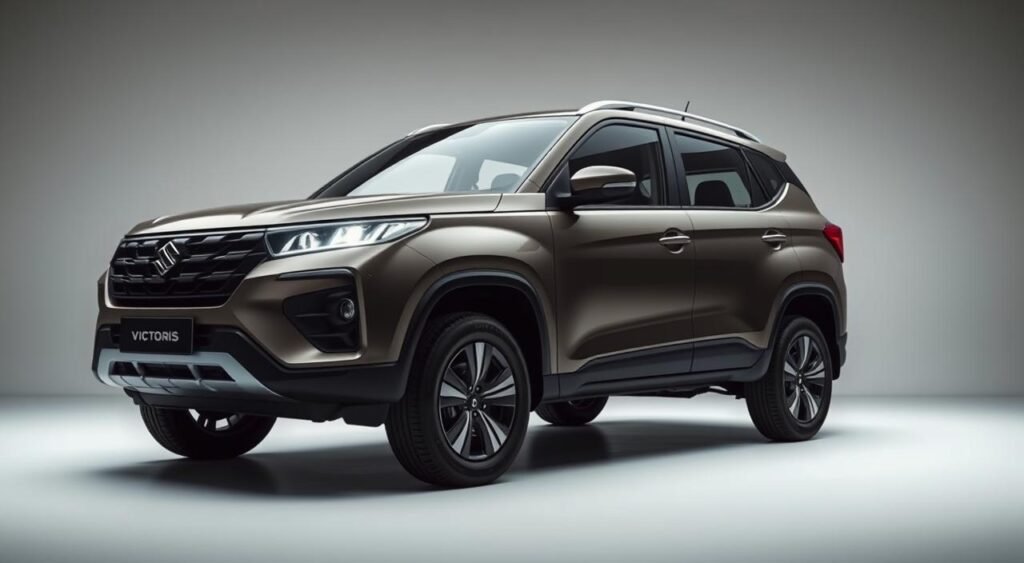
- Width: 1,795mm for stable road presence
- Wheelbase: 2,600mm creating generous interior space
- Full-digital instrument cluster
- 360-degree camera system
- Panoramic sunroof
Key Goals for the Victoris
Maruti had specific goals for the Victoris. They aimed to include premium features in an affordable package. The Victoris comes with features like powered driver seats and a gesture-controlled tailgate, making it a great value for Indian families.
Stylish Exterior Design
The Maruti Suzuki Victoris offers a fresh take on SUV styling. Its estate-wagon look stands out in a crowded market. The design shows off the vehicle’s character and capability.
Design Philosophy and Inspiration
The Victoris has a premium design that’s both elegant and bold. Its front fascia is clean, with sharp DRLs that run along the bonnet. This design is sophisticated and appeals to modern buyers.

The side profile shows off the estate character with its large glasshouse and squared-off wheel arches. The Victoris has a commanding presence on the road. Its clean lines and 17-inch alloy wheels add to its performance look.
Color Options and Customizations
There are seven striking color options for the Victoris:
- Eternal Blue – available in monotone and dual-tone
- Sizzling Red – available in monotone and dual-tone
- Mystic Green – monotone only
- Blueish Black – monotone only
- Magma Grey – monotone only
- Splendid Silver – available in monotone and dual-tone
- Arctic White – monotone only
The rear design is sleek, with connected taillamps and a thin light bar. This design is bold yet elegant, fitting the overall look.
Interior Features and Comfort
The Maruti Suzuki Victoris interior is a step up in comfort and tech. It has a dual-tone black and off-white theme for a fancy feel. Silver accents and textured gloss black on the dashboard make it look great.
Strong hybrid models have an all-black interior with gold accents. This gives them a unique look.
Spacious Cabin Design
The cabin is great for both the front and back seats. Front seats are comfy with firm support and side bolstering. The driver gets electric seat adjustment, and both front seats have ventilated options for hot weather.
The rear bench has plenty of space, with a 60:40 split. It has enough knee and legroom and a middle headrest. There are rear AC vents, a center armrest, and a big sunroof for natural light.

Tech-savvy Infotainment System
The infotainment system is centered around a 10.1-inch SmartPlay Pro X touchscreen. It supports OTT apps, video playback, and Alexa AI for voice commands. Mobile tethering and OTA updates keep it up-to-date without needing a dealership visit.
The audio system is impressive, with an eight-speaker Infinity setup by Harman. It offers bass-rich sound with Dolby Atmos support. The 10.25-inch digital instrument cluster and head-up display add to the tech features.
Safety Features
The Victoris comes with six airbags, ABS with EBD, ESP, and traction control. It also has hill hold assist to prevent rolling back on hills. ISOFIX anchors secure child seats well.
The Level 2 ADAS includes lane-keep assist and adaptive cruise control. These features make driving on highways safer.
Engine Performance and Fuel Efficiency
The Maruti Suzuki Victoris offers three powertrain options. Each one balances engine power with great fuel efficiency. This meets the needs of various drivers on Indian roads.
Engine Specifications
The Victoris has a 1.5-liter K15C petrol engine. It makes 103PS and 139Nm of torque. You can pick from a 5-speed manual or a 6-speed automatic transmission.
The petrol model gets 21.18 kmpl with manual and 21.06 kmpl with automatic.
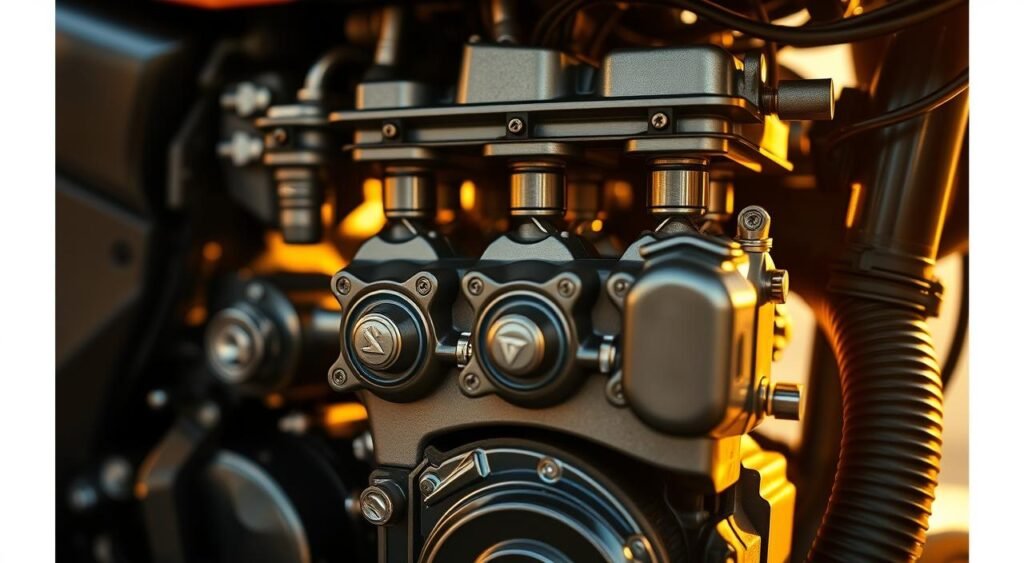
The CNG version has 87.8PS on CNG and 100PS on petrol. The hybrid model has 116PS combined output and 141Nm torque. It comes with an eCVT transmission.
This hybrid gets 28.65 kmpl. The CNG version gets 27.02 km/kg.
Driving Experience and Handling
The petrol engine is smooth at low speeds. It gets more powerful in second and third gears. On highways, it feels confident but gets a bit rough when accelerating hard.
The six-speed automatic transmission shifts smoothly. Sport mode makes it respond quicker.
All variants impress with real-world fuel efficiency. City driving gets 12-13 kmpl for petrol and over 20 kmpl for hybrids. On highways, petrol gets 17-18 kmpl, and hybrids get 24-25 kmpl.
The hybrid runs silently in EV mode in cities. Its self-charging system means no range anxiety.
Off-road Capabilities
The Maruti Suzuki Victoris impresses with its off-road skills. It’s built with advanced tech and engineering. This SUV can handle tough terrains with ease.

Terrain Management System
The AllGrip AWD system is available with the 6-speed automatic petrol. It offers a fuel economy of 19.07 kmpl. This system ensures the best grip on different surfaces.
The Victoris excels on off-road courses. It moves smoothly over sand, gravel, and mud. The four-wheel disc brakes help stop safely and confidently.
Ground Clearance and Suspension
The Victoris has 210mm of ground clearance. This keeps it safe from rocks and rough paths. Its suspension is great on highways and smooth on bumpy roads.
| Feature | Specification | Benefit |
|---|---|---|
| Ground Clearance | 210mm | Adequate protection on rough terrain |
| Wheel Size | 17 inches | Balance between style and comfort |
| Brake Type | 4-wheel disc | Superior stopping power |
| Fuel Economy (AWD) | 19.07 kmpl | Efficient despite capability |
The Victoris handles twisty roads well. Its 17-inch wheels look good and feel comfortable. Wider tires could improve grip for those who love extreme off-roading.
Comparison with Competitors
The Maruti Suzuki Victoris 2022 enters a crowded SUV market. It faces tough competition from the Hyundai Creta and Kia Seltos. This analysis shows how Maruti positions the Victoris to stand out.
How the Victoris Stands Out
The Victoris has features that its rivals don’t. It’s the only SUV in its segment with factory-fitted CNG and full boot space. Its hybrid variant offers great fuel efficiency without losing performance.
Maruti’s wide service network in India gives it an advantage. The Victoris is available in more places than its competitors. It also has a top-notch ADAS suite at an affordable price.
Price Point Analysis
The Victoris starts at Rs. 10.50 lakh, making it cheaper than many rivals. Its top hybrid variant at Rs. 19.98 lakh is also a good deal.
| Model | Starting Price | Top Variant Price |
|---|---|---|
| Maruti Suzuki Victoris | Rs. 10.50 lakh | Rs. 19.98 lakh |
| Hyundai Creta | Rs. 11.00 lakh | Rs. 20.15 lakh |
| Kia Seltos | Rs. 10.90 lakh | Rs. 20.30 lakh |
The Victoris doesn’t have diesel or turbo-petrol options. It also doesn’t have a spare wheel, which might worry some buyers. Yet, it offers great value with its price and wide availability.
Customer Feedback and Reviews
Real-world customer reviews show the Maruti Suzuki Victoris in a new light. It has an average rating of 4.7 out of 5 stars from early owners. People share both good points and areas for improvement of this affordable SUV. Let’s look at what drivers say about their choices.
Highlighting User Experiences
Many owners love the Victoris for its high-end features at a low Maruti Suzuki Victoris price. The CNG version gets great fuel mileage, from 23 to 27 kilometers per kilogram. Families like the push-button start in the base models.
The cooling system works well in India’s hot summers. The sound system is also a hit for its quality at this price.
Common Praises and Criticisms
Owners often talk about the same things:
| Positive Feedback | Areas for Improvement |
|---|---|
| Striking exterior design | Engine noise at high speeds |
| Comfortable driving position | Average headlamp brightness |
| Low maintenance costs | Basic infotainment system |
| Value for money features | Light upholstery needs care |
| Excellent fuel efficiency | Road noise intrusion |
Some find the driving not exciting, but many see it as reliable and affordable. The Victoris is seen as a smart choice for families looking for value and dependability.
Maruti Suzuki’s Commitment to Sustainability
The Maruti Suzuki Victoris Review shows a strong focus on the environment. The company uses eco-friendly technologies to make driving green easy for Indian buyers. This doesn’t mean they sacrifice performance or affordability.
Eco-friendly Manufacturing Practices
Maruti Suzuki’s factories are very careful about the environment. They use methods to reduce waste and control emissions better than most. Each Victoris meets strict emission standards, showing the company’s commitment to being green.
Future of Electric and Hybrid Options
The Victoris introduces new hybrid technology with three green options. The strong hybrid model gets up to 28.65 kmpl, thanks to its self-charging battery. The CNG version gets 27.02 km/kg, with a safe, factory-installed system.
Even the mild hybrid petrol models have start-stop and regenerative braking. This boosts their fuel efficiency.
| Powertrain Type | Fuel Efficiency | Key Technology |
|---|---|---|
| Strong Hybrid | 28.65 kmpl | Self-charging battery system |
| CNG | 27.02 km/kg | Factory-fitted dual fuel system |
| Mild Hybrid Petrol | 22.89 kmpl | Start-stop with regenerative braking |
Maruti Suzuki aims to grow its hybrid offerings and look into full-electric cars. This move helps meet India’s emission goals. It also makes green driving more affordable than high-end electric cars.
Final Thoughts on the Maruti Suzuki Victoris
The Maruti Suzuki Victoris SUV is a big step for the brand in the SUV market. It has a practical design and modern features that Indian families love. The Victoris has different engine options, a big cabin with new features, and a price that’s easy on the wallet.
It also has a 5-star safety rating and engines that save on fuel. This makes it a great choice for those who care about safety and want to save money on gas.
Summary of Key Takeaways
The Victoris stands out in many ways that SUV buyers look for. Its interior is packed with advanced tech and comfort features, all at a great price. It rides smoothly over Indian roads, balancing comfort with stability.
It gets a 7.9 out of 10 rating, showing it’s a solid choice despite some small issues. The interior might need cleaning often, and there’s no diesel engine. If you’re looking for fast acceleration, the Victoris might not be for you.
Is the Victoris Worth Your Investment?
If you’re looking for a reliable SUV with lots of features at a good price, the Victoris is worth it. It fills a gap left by the Grand Vitara, competing well with Korean rivals like Hyundai Creta and Kia Seltos. Its looks, usability, and Maruti Suzuki’s service network make it a great choice.
Some might miss the lack of a spare wheel and diesel engine. But the Victoris is one of Maruti’s best offerings in years. It’s perfect for those who value brand reputation, fuel efficiency, and practicality over speed.
FAQ
What is the price range of the Maruti Suzuki Victoris?
The Maruti Suzuki Victoris starts at Rs. 10.50 lakh for the base model. The CNG variants cost Rs. 11.50 lakh. The top hybrid model is priced at Rs. 19.98 lakh. This makes it a good deal compared to the Hyundai Creta and Kia Seltos.
What are the engine options and specifications available?
The Victoris comes with three engine options. A 1.5-liter K15C petrol engine makes 103PS/139Nm. It has 5MT/6AT transmissions. There’s also a 1.5-liter petrol+CNG variant and a strong hybrid system.
The hybrid system produces 116PS combined output. An AllGrip AWD system is available with the 6AT petrol variant.
What are the standout features of the Victoris interior?
The interior of the Maruti Suzuki Victoris is premium. It has a powered driver seat and ventilated front seats. There’s also a 10.1-inch SmartPlay Pro X touchscreen and a 10.25-inch digital instrument cluster.
Other features include a heads-up display, 360-degree camera, and wireless charger. It has a panoramic sunroof and gesture-controlled powered tailgate. The sound system is an eight-speaker Infinity system with Dolby Atmos support.
How does the Victoris perform in terms of fuel efficiency?
The Victoris is fuel-efficient. The strong hybrid variant gets 28.65kmpl. The CNG variant gets 27.02km/kg. Petrol variants get 21.18kmpl (manual) and 21.06kmpl (automatic).
In real-world city driving, petrol variants get 12-13kmpl. Hybrid variants get over 20kmpl.
What safety features does the Victoris offer?
The Victoris has many safety features. It comes with 6 airbags as standard. It also has a Level 2 ADAS suite, adaptive cruise control, and lane-keep assist.
It has ABS with EBD, ESP, traction control, and hill hold assist. There are ISOFIX anchors and TPMS. The SUV has 5-star safety ratings from BNCAP and GNCAP crash tests.
When is the Maruti Suzuki Victoris launch date?
The Maruti Suzuki Victoris has already been launched. It is Arena’s flagship model. Its market introduction in 2022 makes it a premium option in the compact SUV segment.
How does the Victoris compare to the Grand Vitara?
The Victoris and Grand Vitara share a platform and dimensions. But the Victoris is more premium and costs less. It’s designed to offer better value in Arena space, not as a replacement.
What do customer reviews say about the Victoris?
Early owners give the Victoris a 4.7/5 rating. They love its looks, comfortable drive, affordable maintenance, and fuel economy. Some say the engine noise is high at high speeds, and the headlamps are not bright enough.
But the base variant is a hit with middle-class families. They call it the “Base Model King”.
Is the Victoris suitable for off-road driving?
Yes, the Victoris is good for off-road driving. It has 210mm ground clearance and an AllGrip AWD system. It handles off-road well, but sometimes lacks torque.
The suspension is stable on rough terrain and twisty roads.
What are the main competitors of the Maruti Suzuki Victoris?
The Victoris competes with the Hyundai Creta, Kia Seltos, Skoda Kushaq, Volkswagen Taigun, MG Astor, and Honda Elevate. It has Maruti’s wide service network, proven reliability, and unique CNG option.
It also has a strong hybrid variant and advanced ADAS at a good price. But it doesn’t have diesel or turbo-petrol options like some rivals.

Oct
What new cars hit the Indian market in September 2025? This month was big for car buyers. Many car makers brought out new models at different prices.
The new cars in September 2025 offered something for everyone. The Volvo EX30 electric SUV was priced at Rs. 39.99 Lakh. On the other end, the Citroen Basalt X started at just Rs. 7.95 Lakh. Maruti Suzuki introduced the Victoris at Rs. 10.50 Lakh. VinFast also made its debut with the VF 6 and VF 7.
These new cars are just the start of a big change in India’s car market. By 2026, 68 new cars will hit the roads, including 50 SUVs. Each car comes with new features and tech to meet what buyers want.
Key Takeaways
- Volvo EX30 electric SUV launched on September 23, 2025, priced at Rs. 39.99 Lakh
- Maruti Suzuki Victoris debuted on September 15, 2025, at Rs. 10.50 Lakh
- VinFast entered India with VF 6 (Rs. 16.49 Lakh) and VF 7 (Rs. 20.89 Lakh) models
- Citroen Basalt X launched as the most affordable option at Rs. 7.95 Lakh
- 68 new vehicles scheduled for 2025-2026, with SUVs dominating at 50 models
- September launches covered all segments from budget to luxury vehicles
Overview of September 2025 Car Launches
September 2025 was a big month for cars in India. Car makers brought out a wide range of vehicles. Prices started at Rs. 7.95 Lakh for the Citroen Basalt X and went up to Rs. 39.99 Lakh for the Volvo EX30. This shows how the market is changing to meet different needs and budgets.

Significance of New Launches
The new cars in September highlight a big move towards electric and SUVs. *Volvo’s entry into the premium EV segment* shows a push for green transport. With 16 new models coming in the next three months, the industry is feeling optimistic about India’s growth.
For those watching their wallets, there’s the Citroen Basalt X. And for those looking for luxury, there’s the Volvo. This variety means there’s something for everyone, no matter their budget.
Key Trends in the Automotive Market
SUVs are all the rage, with 50 models on the way. Electric cars are also getting more attention, thanks to eco-friendly goals and government rules. Prices range from Rs. 7.95 Lakh to Rs. 39.99 Lakh, showing a smart strategy to reach various customers. These updates show the industry is ready to meet new demands and prepare for the future.
Major Brands and Their Releases
The upcoming cars in September 2025 show a big fight among India’s top car makers. Each brand has something special for everyone, from those on a tight budget to those wanting the best. The latest cars highlight the need for good prices, new tech, and more choices.
Tata Motors: Innovations and Updates
Tata Motors is growing fast with four big new cars. The Tata Sierra is back as a modern SUV, priced between Rs. 15-25 Lakh. It’s perfect for those who love adventure.
The Harrier and Safari get big updates. The Harrier costs between Rs. 14-25.25 Lakh, and the Safari from Rs. 14.66-25.96 Lakh. The Punch 2025 starts at just Rs. 6 Lakh, making it very affordable.
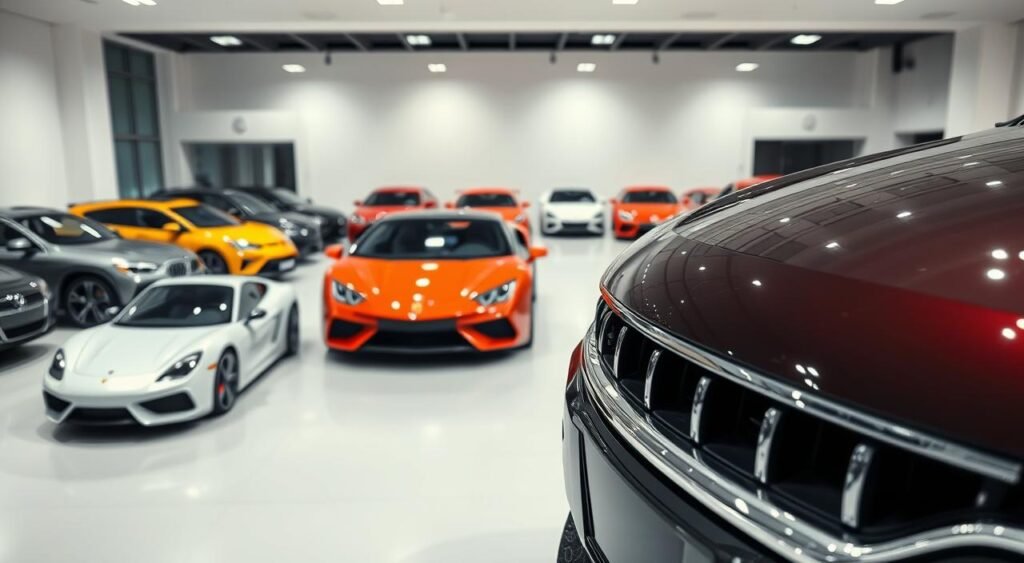
Hyundai: Exciting New Models
Hyundai is bringing a variety of cars in September. The Venue 2025 starts at Rs. 8 Lakh, aiming for the compact SUV market. The Tucson 2025, priced at Rs. 30 Lakh, offers high-end features.
The Palisade, priced between Rs. 40-50 Lakh, shows Hyundai’s move into luxury. It’s a big step for the brand.
Maruti Suzuki: The Affordable Option
Maruti Suzuki is getting stronger with the Victoris at Rs. 10.50 Lakh. They also have the updated Brezza 2025 at Rs. 8.50 Lakh and the Grand Vitara at Rs. 14 Lakh. The e Vitara is their first electric car, priced between Rs. 17-22.50 Lakh.
Electric Vehicles Introduced in September 2025
The electric vehicle segment was a big hit in September 2025. India saw many new EVs, from affordable models to luxury ones. This shows more people want green cars in India.
Leading EVs in the Lineup
Volvo’s EX30 electric was a highlight, priced at Rs. 39.99 Lakh. It shows the push for high-end electric cars. There are also cheaper options like the Leapmotor T03 at Rs. 8 Lakh and the Maruti WagonR Electric at Rs. 8.50 Lakh. These make electric cars more affordable for everyone.
| Electric Vehicle Model | Price Range (Rs.) | Market Segment |
|---|---|---|
| Leapmotor T03 | 8 Lakh | Budget |
| Maruti WagonR Electric | 8.50 Lakh | Budget |
| Mahindra XEV 4e | 13 Lakh | Compact |
| Maruti e Vitara | 17-22.50 Lakh | Mid-Range SUV |
| MG 4 EV | 30 Lakh | Premium |
| Tesla Model 3 | 60 Lakh | Luxury |
| BMW iX 2025 | 1.45 Crore | Ultra-Luxury |
Government Initiatives for EV Adoption
The Indian government is helping by giving FAME-II subsidies and lowering GST rates. States also offer perks like free registration and special parking. These moves make electric cars more appealing to all buyers.
Compact Cars: A Growing Segment
The compact car segment is booming in India. Many new cars are coming out, aiming at budget-friendly buyers. These cars are great for city driving, saving money, and using less fuel.
They offer a perfect mix of space, features, and price. This makes them ideal for Indian roads and parking spots.
Best Compact Cars Launched
Citroen introduced the Basalt X for Rs. 7.95 Lakh on September 5, 2025. Its price makes it a great choice for new buyers. The Maruti Swift is also popular, priced from Rs. 5.79 to 8.80 Lakh. It’s known for its reliability and wide service network.
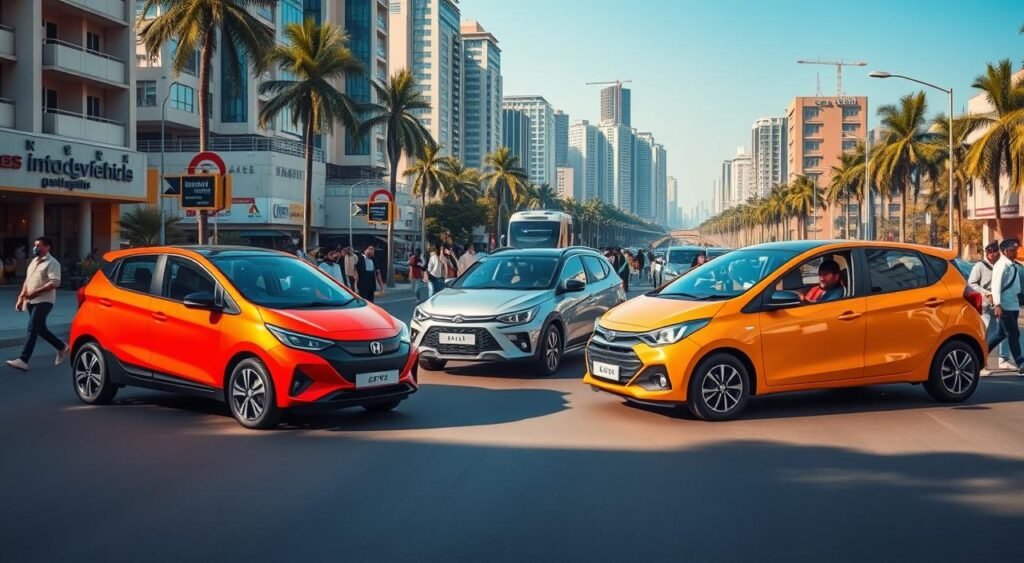
Several new models are expected to change the compact car scene. The Tata Punch 2025 facelift will cost around Rs. 6 Lakh. Volkswagen’s Tera will start at Rs. 8 Lakh. VinFast’s VF 3 will be priced between Rs. 7.50 and 10 Lakh. Honda’s WR-V is expected to cost between Rs. 9 and 12 Lakh.
Consumer Preferences and Trends
People looking for compact cars want good value, fuel efficiency, and low upkeep. Renault answered with new KWID models priced from Rs. 4.30 to 5.90 Lakh. The upcoming Maruti Baleno 2026 and MG 4 EV show a shift towards electric cars. They keep the compact size but add modern tech features.
SUVs and Crossovers: Dominating the Market
The SUV segment is leading the way on Indian roads with exciting new launches in 2025. September saw big unveilings from both well-known brands and new players. These launches set new benchmarks for design and performance.
The latest car models in India show a growing need for versatile vehicles. They must offer family comfort and be ready for adventure.
Popular SUV Models Unveiled
VinFast introduced their VF 6 and VF 7 electric SUVs, priced at Rs. 16.49 Lakh and Rs. 20.89 Lakh. The Mahindra Thar arrived in October, starting at Rs. 9.99 Lakh. It’s a hit with off-road fans across the country.
More exciting launches are on the horizon. We can expect:
- Hyundai Palisade – Rs. 40-50 Lakh
- Maruti Brezza 2025 – Rs. 8.50 Lakh
- Tata Sierra – Rs. 15-25 Lakh
- Volkswagen Tayron – Rs. 50 Lakh
- Renault New Duster – Rs. 12-20 Lakh
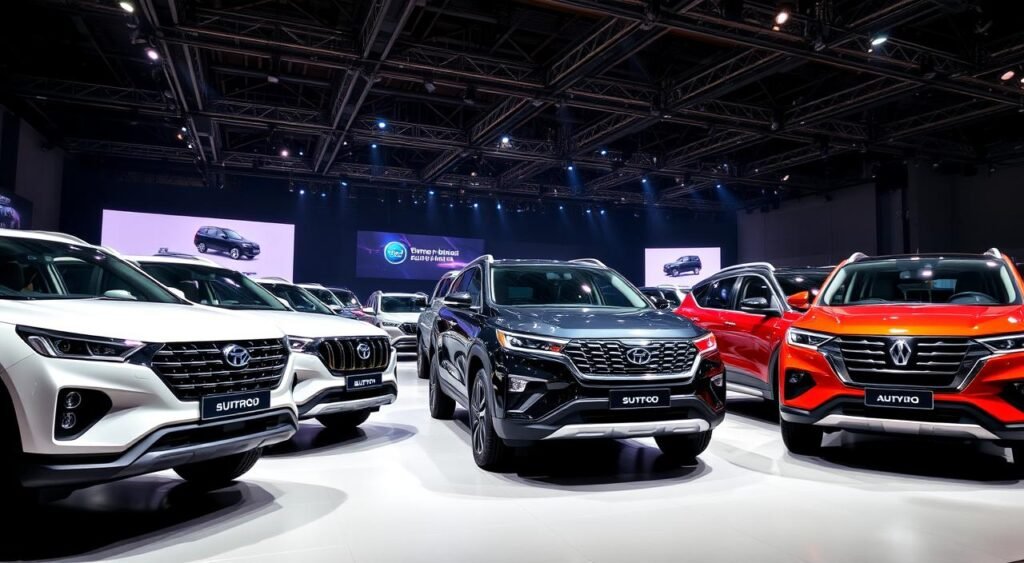
Features That Attract Buyers
Today’s SUV buyers look for advanced safety systems, roomy interiors, and good fuel economy. The latest models offer ADAS technology, panoramic sunroofs, and connected car features. They also have three-row seating options from Toyota and Maruti Grand Vitara for families.
Premium options like the MG Majestor at Rs. 46 Lakh add luxury to the segment. By 2026, nearly 50 SUVs will hit the market. Each will bring its own mix of tech, comfort, and value to Indian buyers.
Luxury Vehicles: Premium Offerings
September 2025 is a big month for luxury car buyers in India. The luxury car segment welcomes new models. These cars combine the latest technology with top-notch craftsmanship.
High-End Brands and Their New Arrivals
*Volvo* starts with the EX30, a premium electric vehicle, launched on September 23, 2025, at Rs. 39.99 Lakh. It brings Scandinavian design to India. Mercedes-Benz also makes a splash with the AMG CLE, priced at Rs. 1.28 Crore.
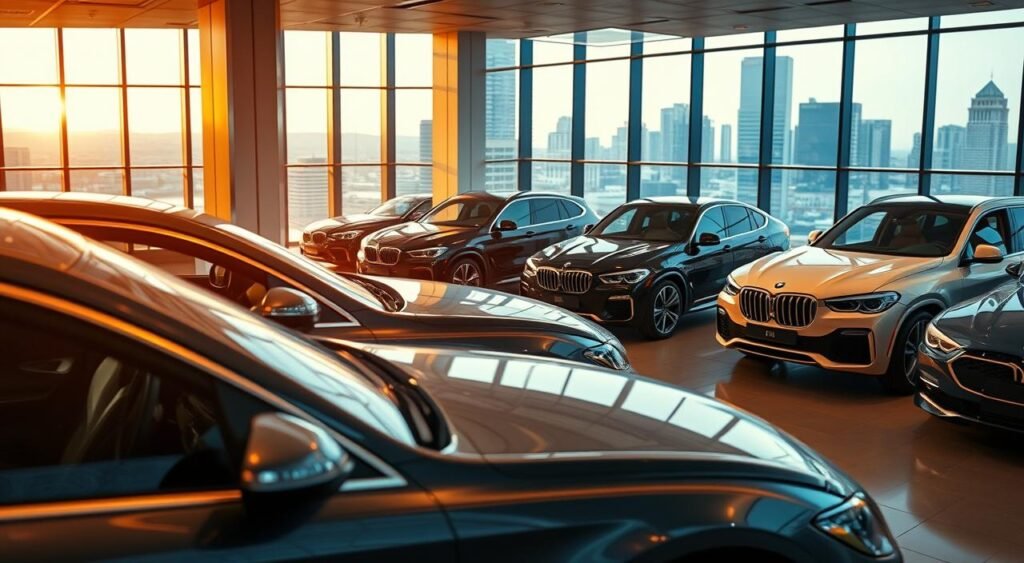
More excitement is coming. BMW is set to introduce the iX 2025 at Rs. 1.45 Crore. Audi will launch two models: the Q6 e-tron at Rs. 1 Crore and the A5 at Rs. 50 Lakh. Skoda is targeting the premium sports sedan market with the Octavia RS, expected between Rs. 45-55 Lakh.
Unique Selling Points of Luxury Cars
These premium vehicles stand out for several reasons:
- Advanced autonomous driving capabilities
- Sustainable luxury with electric powertrains
- Personalized digital cockpits
- Handcrafted interiors using premium materials
- Exclusive ownership experiences and services
Ferrari introduces the 12Cilindri coupe, while Maserati brings the MCPura at Rs. 5.12 Crore. These updates show a focus on performance and environmental care.
Technology and Features in New Cars
September 2025 is a big moment for the India car market. Cars now come with the latest tech, from electric power to smart connectivity. The newest models mix safety with fun tech, pleasing tech lovers at all price points.
Advanced Safety Features
New cars focus on safety first. The BMW iX 2025 has Level 2 driving, helping with steering and speed. Tesla Model 3 brings Autopilot to Indian roads, making driving easier in traffic.
The Maruti e Vitara offers six airbags and stability control for less money. Volvo EX30 keeps up its safety promise with a top-notch collision system. These features show India’s push for safer cars for everyone.
Infotainment and Connectivity Options
Digital cockpits are changing how we drive. Mercedes-Benz CLA Electric has a top-notch MBUX system, understanding Hindi and English voice commands. Hyundai IONIQ 6 has two big screens and supports Apple CarPlay and Android Auto without wires.
The Audi Q6 e-tron shows off with a virtual cockpit and real-time charging station info. These features highlight India’s move toward cars that connect well with phones and homes.
Pricing Trends and Market Analysis
The car market in September 2025 saw a variety of prices for new cars. Prices ranged from affordable compact cars to high-end luxury vehicles. This shows how the Indian car market is changing and what buyers want.
Comparison of Launch Prices
New cars in September 2025 offer a wide price range for different buyers. The cheapest models are priced to be affordable, while the most expensive ones are in the luxury category.
| Car Model | Segment | Price (Rs. Lakh) |
|---|---|---|
| Tata Punch 2025 | Budget | 6.00 |
| Citroen Basalt X | Compact | 7.95 |
| Volkswagen Tera | Budget | 8.00 |
| Leapmotor T03 | Electric Budget | 8.00 |
| Maruti Victoris | Mid-Segment | 10.50 |
| VinFast VF 6 | Electric SUV | 16.49 |
| VinFast VF 7 | Electric SUV | 20.89 |
| Volvo EX30 | Luxury Electric | 39.99 |
| Audi Q6 e-tron | Premium Electric | 100.00 |
| BMW iX 2025 | Ultra-Luxury | 145.00 |
Economic Factors Influencing Pricing
Many economic factors affect the prices of new cars in September 2025. Rising raw material costs and changes in the supply chain increase production costs. Electric cars range from Rs. 8 Lakh to Rs. 65 Lakh, showing how manufacturers aim for different price points. Government support for electric vehicles also plays a big role in setting prices. Changes in currency value impact the cost of imported parts, affecting high-end brands like BMW and Audi.
Customer Reactions and Reviews
The latest car releases in September 2025 have started big talks in car forums and dealerships everywhere. People are sharing their thoughts on new cars, helping others make up their minds. This feedback is key for millions of people thinking about buying a car.
Feedback on Latest Models
The Mahindra Thar’s launch in October at Rs. 9.99-16.99 Lakh caught everyone’s attention. Early buyers loved its tough look and how well it handles off-road. The Maruti Victoris, launched on September 15 at Rs. 10.50 Lakh, got good feedback for its gas mileage and roomy inside.
VinFast’s arrival in India with the VF 6 and VF 7 models made a big splash. People liked the brand’s good prices and cool features. The Volvo EX30 electric car, priced at Rs. 39.99 Lakh, drew in fans of eco-friendly luxury cars.
The Role of Social Media in Reviews
Instagram and YouTube channels focused on cars got a lot of attention in September 2025. Videos about the Maruti Swift (Rs. 5.79-8.80 Lakh) and Tata Nexon (Rs. 7.32-14.05 Lakh) were watched by millions. Twitter talks about the Tata Punch (Rs. 5.50-9.30 Lakh) and Maruti FRONX (Rs. 6.85-11.98 Lakh) helped shape buying choices in big cities.
Online groups are now very important in forming opinions about new cars. Quick feedback on social media helps car makers fix problems and make customers happier.
Conclusion: What’s Next for the Indian Automotive Market?
The Indian car market is on the verge of a big change. By 2026, 68 new models will hit the roads. SUVs will lead with 50 models, while sedans, hatchbacks, and electric vehicles will also be available.
September 2025 will see a wide range of cars. Prices will start at Rs. 6 Lakh for the Tata Punch 2025. The Maserati MCPura will be at the high end, priced at Rs. 5.12 Crore.
Future Predictions
The next 18 months will bring many new cars to India. Mahindra will launch the new Bolero in March 2026. Hyundai will introduce the New Venue in November 2025 and the Palisade in March 2026.
Electric cars will become more common, with over 12 models debuting. This includes the Tesla Model 3 and Maruti WagonR Electric. There will also be specialized vehicles like the Mahindra Global Pik Up and Nissan Compact MPV.
Implications for Consumers and Manufacturers
Car buyers in India will have more choices than ever. The September 2025 list shows a wide range of options. Manufacturers must balance price and innovation to meet customer needs.
The move towards electric vehicles and SUVs marks a new era. Companies must quickly adapt to these changes. They also need to keep prices affordable in the Indian market.
FAQ
Which cars were launched in India in September 2025?
In September 2025, India saw five big car launches. The Volvo EX30 electric SUV was launched on September 23 at Rs. 39.99 Lakh. The Maruti Suzuki Victoris was launched on September 15 at Rs. 10.50 Lakh. VinFast VF 6 and VF 7 SUVs were launched on September 6 at Rs. 16.49 Lakh and Rs. 20.89 Lakh respectively. The Citroen Basalt X was launched on September 5 starting at Rs. 7.95 Lakh.
What are the price ranges for new car launches in September 2025?
The new car launches in September 2025 offered a wide range of prices. The Citroen Basalt X started at Rs. 7.95 Lakh. The Volvo EX30 electric SUV was priced at Rs. 39.99 Lakh. The Maruti Suzuki Victoris was priced at Rs. 10.50 Lakh. The VinFast models were priced at Rs. 16.49-20.89 Lakh.
Which electric vehicles are coming to India in 2025-2026?
Over 12 electric vehicles are coming to India. The BMW iX 2025 will cost Rs. 1.45 Crore. The Audi Q6 e-tron will cost Rs. 1 Crore. The Maruti e Vitara will cost between Rs. 17-22.50 Lakh. The Mercedes-Benz CLA Electric will cost Rs. 65 Lakh. The MG 4 EV will cost Rs. 30 Lakh. The Tesla Model 3 will cost Rs. 60 Lakh. The Mahindra BE 07 will cost Rs. 29 Lakh. The Maruti WagonR Electric will cost Rs. 8.50 Lakh. The Leapmotor T03 will cost Rs. 8 Lakh.
How many upcoming cars are scheduled for launch in India?
India has 68 upcoming cars scheduled for 2025-2026. This includes 50 SUVs, 9 sedans, 4 hatchbacks, 2 coupes, 1 pickup truck, 1 MUV, and 1 luxury vehicle.
What are the top car releases expected in September 2025 and beyond?
Some key releases include the Maruti Brezza 2025 at Rs. 8.50 Lakh. The Hyundai Venue 2025 will cost Rs. 8 Lakh. The Tata Sierra will cost between Rs. 15-25 Lakh. The Hyundai Palisade will cost between Rs. 40-50 Lakh. The Maruti Grand Vitara 3-row will cost Rs. 14 Lakh. The Volkswagen Tayron will cost Rs. 50 Lakh. The Mahindra XUV700 Facelift will cost Rs. 15 Lakh.
Which budget cars under Rs. 10 Lakh are launching soon?
Soon, we’ll see budget-friendly cars like the Tata Punch 2025 facelift at Rs. 6 Lakh. The Volkswagen Tera will cost Rs. 8 Lakh. The VinFast VF 3 will cost between Rs. 7.50-10 Lakh. The Leapmotor T03 electric will cost Rs. 8 Lakh. The Maruti WagonR Electric will cost Rs. 8.50 Lakh. The Hyundai Venue 2025 will cost Rs. 8 Lakh.
What luxury cars are coming to the Indian market?
Luxury cars include the BMW iX 2025 at Rs. 1.45 Crore. The Audi Q6 e-tron will cost Rs. 1 Crore. The Skoda Octavia RS will cost between Rs. 45-55 Lakh. The Audi A5 will cost Rs. 50 Lakh. The Skoda Superb 2025 will cost Rs. 50 Lakh. The Mercedes-Benz CLA Electric will cost Rs. 65 Lakh. The Ferrari 12Cilindri coupe and Maserati MCPura will be launched on October 4, 2025, at Rs. 5.12 Crore.
What are the latest car models featuring advanced technology?
New models include the BMW iX 2025 with autonomous driving. The Tesla Model 3 has Autopilot. The Mercedes-Benz CLA Electric has the MBUX infotainment system. The Audi Q6 e-tron has quattro electric all-wheel drive. Many models feature ADAS technology and connected car features.
Which SUVs are dominating the Indian car market trends?
SUVs are leading the market with 50 models in the pipeline. The Mahindra Thar was launched on October 3, 2025, at Rs. 9.99-16.99 Lakh. The Tata Sierra, Maruti Grand Vitara 3-row, Hyundai Tucson 2025, MG Majestor, Toyota 3-Row SUV, Nissan New Compact SUV, and Renault New Duster are also expected.
What are the automobile industry updates for compact cars?
The compact segment is active with the Citroen Basalt X launched at Rs. 7.95 Lakh. Upcoming models include the Tata Punch 2025 and Honda WR-V at Rs. 9-12 Lakh. There are also 4 new hatchbacks, including the Maruti Baleno 2026. The Renault KWID has new variants at Rs. 4.30-5.90 Lakh. The Maruti Swift remains popular at Rs. 5.79-8.80 Lakh.

Oct
Can a cheaper electric vehicle really go as far as its pricier sibling? The Indian EV market is curious about this. Mahindra has launched two electric SUVs with similar features.
The Mahindra XEV9E vs BE6 range test shows surprising results. The XEV9E starts at Rs 21.90 lakh, while the BE6 is priced at Rs 18.90 lakh. Both promise ranges of 542-683 kilometers, as certified by ARAI.
This comparison looks at how these EVs perform in real life, not just in labs. The XEV9E has 59-79 kWh battery options and can charge up to 180 kW DC fast. The BE6 has the same battery sizes but charges at 140 kW DC. Both can get to 80% charge in 20 minutes.
But how do they do on the road? The XEV9E gets 430-460 kilometers in real driving, users say. This comparison aims to find out which EV offers the best value for Indian buyers looking for practical electric cars.
Key Takeaways
- The BE6 claims slightly higher ARAI range (557-683 km) compared to XEV9E (542-656 km) despite lower price
- Real-world XEV9E range drops to 430-460 km in mixed driving conditions
- Both EVs feature identical battery options from 59 kWh to 79 kWh capacity
- Fast charging reaches 80% in 20 minutes for both models
- XEV9E supports 180 kW DC charging while BE6 manages 140 kW DC
- Price difference of Rs 3 lakh between base variants favors the BE6
Introduction to Electric Vehicle Range Tests
Range testing is key to figuring out how far electric vehicles can go on one charge. It shows how far an EV can travel, giving buyers real-world info. This helps them choose the right car based on electric vehicle performance.
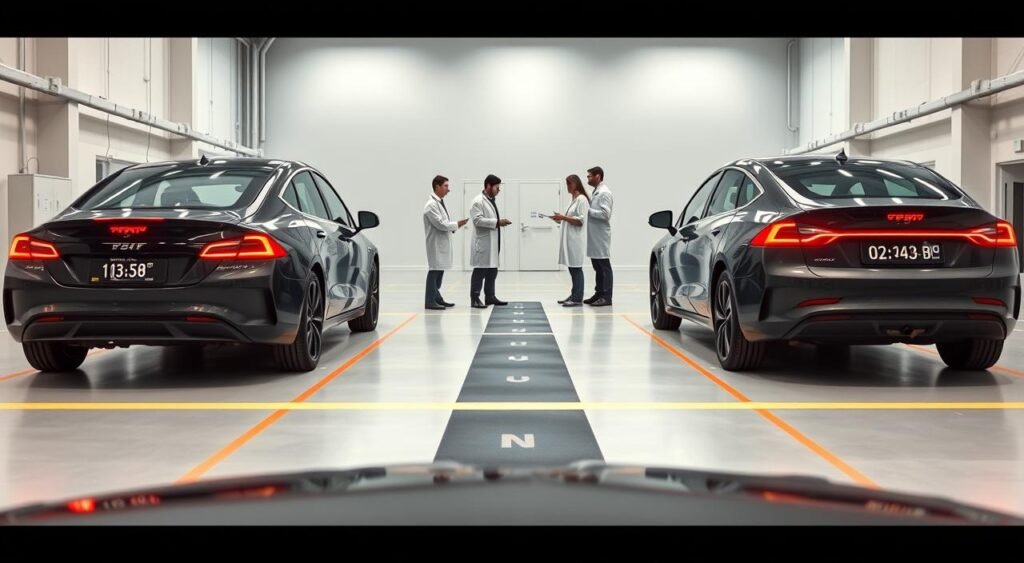
What is Range Testing?
Range testing checks how well an electric vehicle’s battery works. The Automotive Research Association of India (ARAI) does these tests. They follow strict rules to get official range numbers.
But, real-world driving is different from lab tests. Things like traffic, air conditioning, and how you drive affect the range. Most EVs don’t go as far as ARAI says. For example, the Mahindra XEV 9e might go 430 to 460 kilometers, not 542 to 656 as ARAI claims.
Importance of Range in EV Selection
Range anxiety is a big worry for EV buyers in India. It’s important for daily commutes and occasional long trips. An EV efficiency comparison helps find the best car for your needs.
City drivers and those who travel long distances have different needs. Knowing how far an EV can really go helps choose the right car. This way, buyers avoid surprises and find a car that fits their life.
Overview of Mahindra XEV9E
The Mahindra XEV9E is a strong contender in the electric vehicle market. It combines advanced technology with a design that appeals to today’s drivers. This electric SUV is built on Mahindra’s electric platform, showing the brand’s commitment to premium electric mobility in India.
Key Features and Specifications
The XEV9E has impressive technical specs, making it stand out in the market. It has a Permanent Magnet Synchronous Motor that produces 282 horsepower and 380 Newton-meters of torque. It comes with two battery options: 59 kWh for daily use and 79 kWh for longer trips.
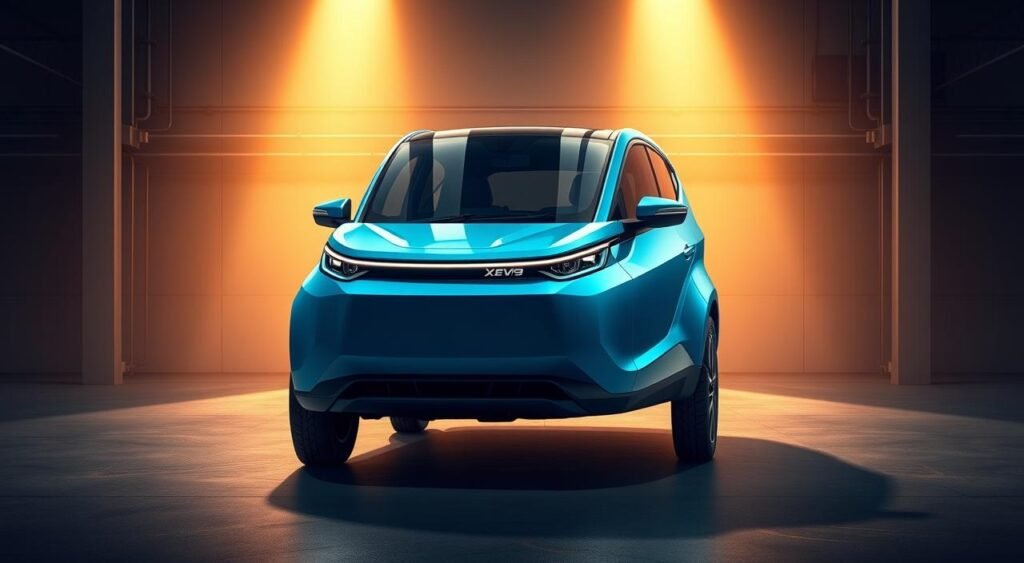
The SUV is 4,789mm long, 1,907mm wide, and 1,694mm tall. It has a 2,775mm wheelbase for spacious interiors and 207mm ground clearance for Indian roads. It has a single-speed automatic transmission and rear-wheel drive for better efficiency.
Design and Comfort
The interior features three 12.3-inch screens for a digital cockpit. It also has a 16-speaker Harman/Kardon audio system with Dolby Atmos. A panoramic glass roof adds natural light, making the interior bright and airy for five people.
| Comfort Features | Details |
|---|---|
| Seating Configuration | 5-seater with ventilated front seats |
| Climate Control | 2-zone automatic temperature management |
| Charging Options | Wireless charging pad for devices |
| Storage Capacity | 663-liter boot space |
Battery and Performance Metrics
The XEV9E has a 5-star BNCAP safety rating. It comes with six airbags, Level 2 ADAS technology, and a 360-degree camera system. These features enhance its performance in real-world driving. The battery management system ensures consistent performance and long battery life.
Overview of BE6
The BE6 is a top choice in the electric vehicle market. It combines great performance with everyday practicality. This compact SUV has impressive specs, making it perfect for those who need reliable range and the latest tech.
It comes with two battery choices and cutting-edge tech. This makes the BE6 ideal for drivers who want both efficiency and fun on their daily drives.
Key Features and Specifications
The BE6 has a Permanent Magnet Synchronous Motor. It produces 228 bhp and 380 Nm of torque. This motor allows the BE6 to go from 0-100 kmph in 6.7 seconds and reach a top speed of 202 kmph.
There are two battery options: 59 kWh and 79 kWh. This gives buyers flexibility based on their driving habits and budget.

Design and Comfort
The BE6 is 4371mm long, 1907mm wide, and 1627mm tall. It has a spacious cabin despite its compact size. The 2775mm wheelbase ensures room for five passengers.
It also has 207mm of ground clearance, perfect for Indian roads. Notable comfort features include a 16-speaker Dolby Atmos sound system, ambient lighting, and ORMS technology. The 455-liter boot is great for carrying stuff on trips.
Battery and Performance Metrics
In the EV range comparison, the BE6 gets between 557-683 km per charge. ARAI testing standards confirm this. It has five drive modes to suit different needs.
Range mode boosts distance, Race mode gives full power, and Everyday mode is for daily use. Snow and Custom modes adjust to specific conditions.
| Battery Option | ARAI Range | Power Output |
|---|---|---|
| 59 kWh | 557 km | 170 kW |
| 79 kWh | 683 km | 170 kW |
Testing Methods for Range
Manufacturers test electric vehicles in labs and real-world settings. The Mahindra XEV9E vs BE6 Range Test shows big differences between official numbers and real driving. Tests range from controlled labs to everyday roads.
Standardized Testing Procedures
The Automotive Research Association of India (ARAI) tests range in labs. They measure energy use under certain conditions. This way, they figure out range based on battery size. It’s done without wind, traffic, or how the driver acts.
ARAI tests give optimistic figures compared to real driving. The XEV9E gets 542-656 km in lab tests, and the BE6 does too. But these tests don’t always match real-world driving.
Real-World Driving Conditions
Real electric vehicle performance is affected by many things labs can’t test. Driving in cities, on highways, and in stop-and-go traffic matters. Weather also affects how far you can go.
| Testing Factor | Impact on Range | XEV9E Real Performance |
|---|---|---|
| Temperature Extremes | 15-25% reduction | 430-460 km achieved |
| Terrain Changes | 10-20% variation | Regenerative braking helps |
| Driving Style | 20-30% difference | 4-level regen modes |
Both cars have regenerative braking with four levels. The XEV9E charges up to 80% in 20 minutes with 180 kW DC fast charging. The BE6 charges at 140 kW, with similar times.
Performance Results: Mahindra XEV9E
The Mahindra XEV9E shows great results in our electric vehicle range test. It highlights the skills of modern Indian EV engineering. Testing it in real-world conditions shows how it performs under different conditions and battery sizes.
Total Range Achieved
The XEV9E comes with two battery sizes. The 59 kWh battery gets you 542 kilometers, as ARAI says. The bigger 79 kWh battery boosts this to 656 kilometers. But, real-world driving shows a different picture.
In mixed driving, you can expect 430 to 460 kilometers. This is about 70 to 80 percent of what’s advertised.
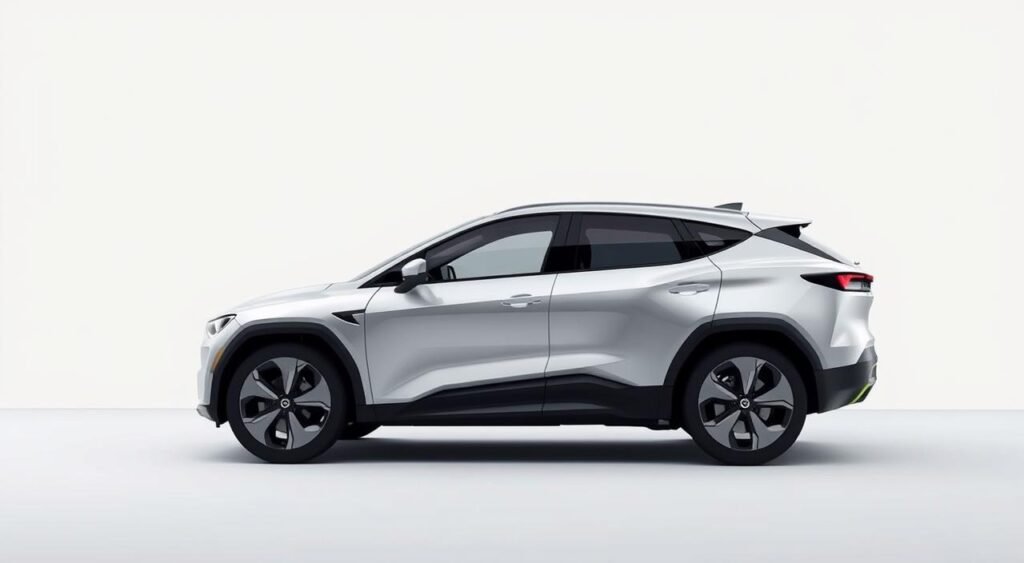
Factors Affecting Performance
Many things affect the XEV9E’s performance:
- Driving style – Fast driving cuts range by up to 20 percent
- Climate control – Using air conditioning reduces range by about 15 percent
- Terrain variations – Going up hills makes it less efficient
- Vehicle payload – Carrying more people and stuff uses more battery
- Drive modes – You can choose settings to save energy or go fast
Comparisons with Manufacturer Claims
The difference between ARAI ratings and real-world results is common. The Pack Three has a 282 bhp motor for fast starts but uses more energy. Charging is fast, with DC fast charging to 80 percent in 20 minutes at 180 kW stations.
Standard AC charging takes 8 to 11.7 hours. This depends on the charger’s power, 7.2 kW or 11.2 kW.
Performance Results: BE6
The BE6 electric SUV stands out in the Mahindra vs BE6 electric vehicle range testing. It shows top-notch performance that beats many expectations. Tests show it can keep a steady range in various driving conditions and stays efficient.
Total Range Achieved
The BE6 has two battery options, both showing great range. The 59 kWh battery gets 557 kilometers, as certified by ARAI. The bigger 79 kWh battery goes up to 683 kilometers on one charge. Surprisingly, the Batman Edition with the 59 kWh battery also hits 683 kilometers, thanks to smart efficiency.
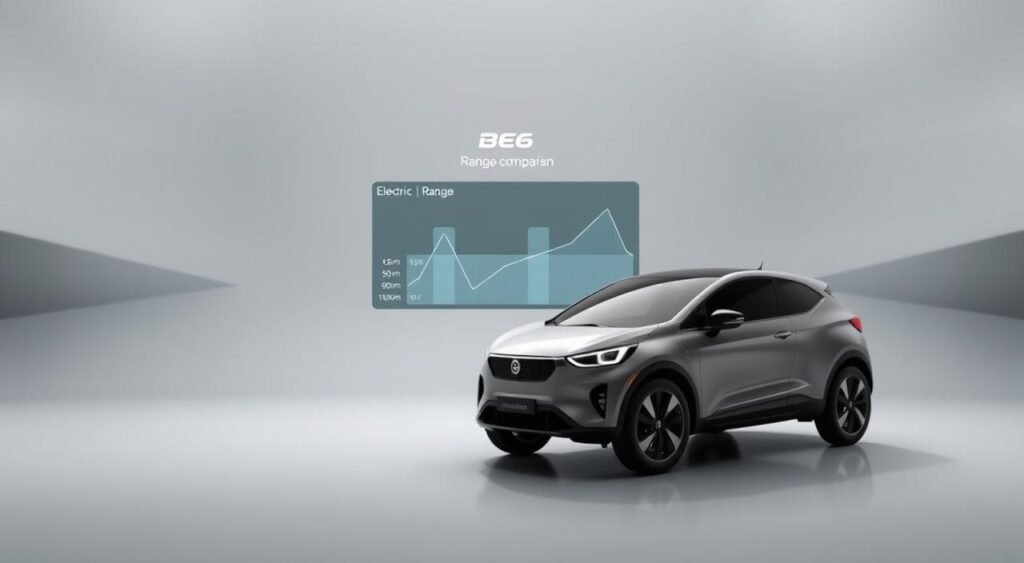
Factors Affecting Performance
Several things help the BE6 achieve its impressive range:
- Its lighter weight at 2,070 kg helps it use energy better
- The 228 bhp motor gives good power without using too much energy
- Five drive modes let drivers choose between range or speed
- Range mode boosts distance by adjusting the throttle
- Its design cuts down on drag at high speeds
Comparisons with Manufacturer Claims
Real-world tests show the BE6 lives up to its promises. It accelerates from 0-100 kmph in 6.7 seconds, proving its speed. It also charges fast, reaching 80% in 20 minutes with 140 kW chargers. AC charging takes 6 to 8.7 hours, depending on the charger used.
Head-to-Head Comparison
When we compare the Mahindra XEV9E and BE6, we find some surprising results. These two models show different ways to improve efficiency and range in the Indian EV market.
Side-by-Side Range Analysis
The BE6 leads with a 683 km ARAI-certified range from its 79 kWh battery pack. The XEV9E gets 656 km with the same battery, 27 km less. This is important for those who drive long distances.
| Specification | Mahindra XEV9E | BE6 |
|---|---|---|
| ARAI Range | 656 km | 683 km |
| Battery Capacity | 79 kWh | 79 kWh |
| Power Output | 282 bhp | 228 bhp |
| DC Fast Charging | 180 kW | 140 kW |
| Drivetrain | RWD Single-speed | RWD Single-speed |
Performance Under Similar Conditions
In real-world tests, both cars see a 15-30% drop from their ARAI ranges. The BE6’s lighter build helps it perform better. The XEV9E makes up for it with quicker charging, cutting down on wait times. Both have identical CCS-II charging ports, making them compatible with India’s charging network.
Cost of Ownership
When looking at the Mahindra XEV9E vs BE6 Range Test, the cost is key. The total cost of owning a car is more than just the price. It includes how much you spend on running the car every day.
Initial Purchase Prices
The BE6 starts at Rs 18.90 lakh, making it cheaper. The XEV9E costs Rs 21.90 lakh, which is Rs 3 lakh more. For those wanting the best, the XEV9E Pack Three costs Rs 31.25 lakh.
The BE6 Batman Edition is Rs 27.79 lakh. It’s a special edition that’s cheaper than the XEV9E’s top model.
Ongoing Costs: Charging and Maintenance
Both cars save money on running costs. They both support home charging with 7.2 kW or 11.2 kW AC chargers. This means similar costs for daily use.
Both makers offer five-year free service packages. This helps cut down on maintenance costs right from the start.
| Cost Factor | Mahindra XEV9E | BE6 |
|---|---|---|
| Base Price | Rs 21.90 lakh | Rs 18.90 lakh |
| Top Variant | Rs 31.25 lakh | Rs 27.79 lakh |
| Free Service Period | 5 years | 5 years |
| Home Charging Options | 7.2/11.2 kW | 7.2/11.2 kW |
Electric cars don’t need oil changes and use regenerative braking. This makes brake pads last longer. Insurance for the XEV9E is higher because it’s more expensive.
Both cars get government subsidies and tax benefits. This helps lower the cost of buying them.
Conclusion: Which EV is the Better Choice?
The electric vehicle range test shows each model has its own strengths. The BE6 leads with a certified range of 683 kilometers. This is 27 kilometers more than the XEV9E’s top variant range of 656 kilometers.
This difference makes the BE6 better for those who want to travel far without needing to charge often.
Summary of Key Findings
The BE6 has a lower starting price, Rs 3 lakh less than the XEV9E. This makes electric cars more affordable for Indian buyers. Its design and range are appealing to those looking for value.
The XEV9E offers more space, with a huge 663-liter boot and a long body. This makes it great for families who need room for everyone.
Both cars have 5-star BNCAP safety ratings and advanced ADAS technology. The XEV9E charges faster, which is good for long trips. It also has premium features like triple screens and Harman/Kardon audio.
Real-world tests show both cars can go 430-460 kilometers on Indian roads. This meets most daily driving needs.
Recommendations for Future Buyers
The BE6 is perfect for single professionals and couples. It offers great range, sporty looks, and value. Its lower price and better range make it great for first-time EV buyers.
The XEV9E is better for families. It has more space, comfort, and premium features. Mahindra’s wide service network in India supports both models, ensuring a good ownership experience.
FAQ
What is the real-world range difference between the Mahindra XEV9E and BE6?
The BE6 has a higher ARAI-certified range of 683 km with its 79 kWh battery. The XEV9E has a range of 656 km. But, real-world tests show both cars get about 70-80% of their claimed range.
User reviews say the XEV9E gets 430-460 km in mixed driving. The BE6 might be slightly more efficient because it’s lighter and has a better powertrain.
How much faster does the XEV9E charge compared to the BE6?
The XEV9E charges at 180 kW DC fast, while the BE6 charges at 140 kW DC. Yet, both can get to 80% charge in about 20 minutes with DC fast charging.
For home AC charging, both take 8-11.7 hours. This depends on whether you use a 7.2 kW or 11.2 kW charger.
What accounts for the Rs 3 lakh price difference between these electric vehicles?
The XEV9E starts at Rs 21.90 lakh, while the BE6 starts at Rs 18.90 lakh. This Rs 3 lakh difference is due to several factors.
The XEV9E is bigger, with a 4789 mm length compared to the BE6’s 4371 mm. It also has a larger boot, 663 liters, versus the BE6’s 455 liters. Plus, it has triple 12.3-inch screens and more power, 282 bhp, than the BE6’s 228 bhp.
How does ARAI testing differ from real-world EV range results?
ARAI testing is done in a controlled lab, measuring energy use and predicting range based on battery size. Real-world tests, though, mix different driving conditions.
Things like temperature, terrain, and driving style greatly affect actual range. This can cut the range by 15-30% from ARAI figures for both cars.
Which EV offers better value for Indian buyers considering EV efficiency comparison?
The BE6 is more affordable, starting at Rs 18.90 lakh. It has a top ARAI range of 683 km and a 228 bhp motor. It also goes from 0-100 kmph in 6.7 seconds.
But, the XEV9E offers more space and premium features. Its larger cabin, advanced infotainment, and faster DC charging might be worth the extra cost for some.
What are the key electric vehicle performance differences between these models?
The XEV9E has 282 bhp and 380 Nm torque in its top variants. The BE6 has 228 bhp and 380 Nm torque. Yet, the BE6 is faster, reaching 0-100 kmph in 6.7 seconds.
Both cars have rear-wheel drive and single-speed automatic transmission. They also have multiple drive modes, including Range mode for better efficiency.
How do regenerative braking systems affect the Mahindra vs BE6 electric vehicle range?
Both cars have 4-level regenerative braking systems. This helps recover energy during braking, improving efficiency and reducing brake wear. It also lowers maintenance costs.
The braking can be adjusted based on driving style and conditions. This allows for better performance or range, depending on preference.
What factors most significantly impact the electric vehicle range test results?
Driving style, climate control, terrain, and payload are key factors. Aggressive driving, air conditioning, hills, and heavy loads can cut range by up to 30%.
Both models have drive modes to optimize range or performance. Range mode is for efficiency, while Race or Sport modes focus on speed.
